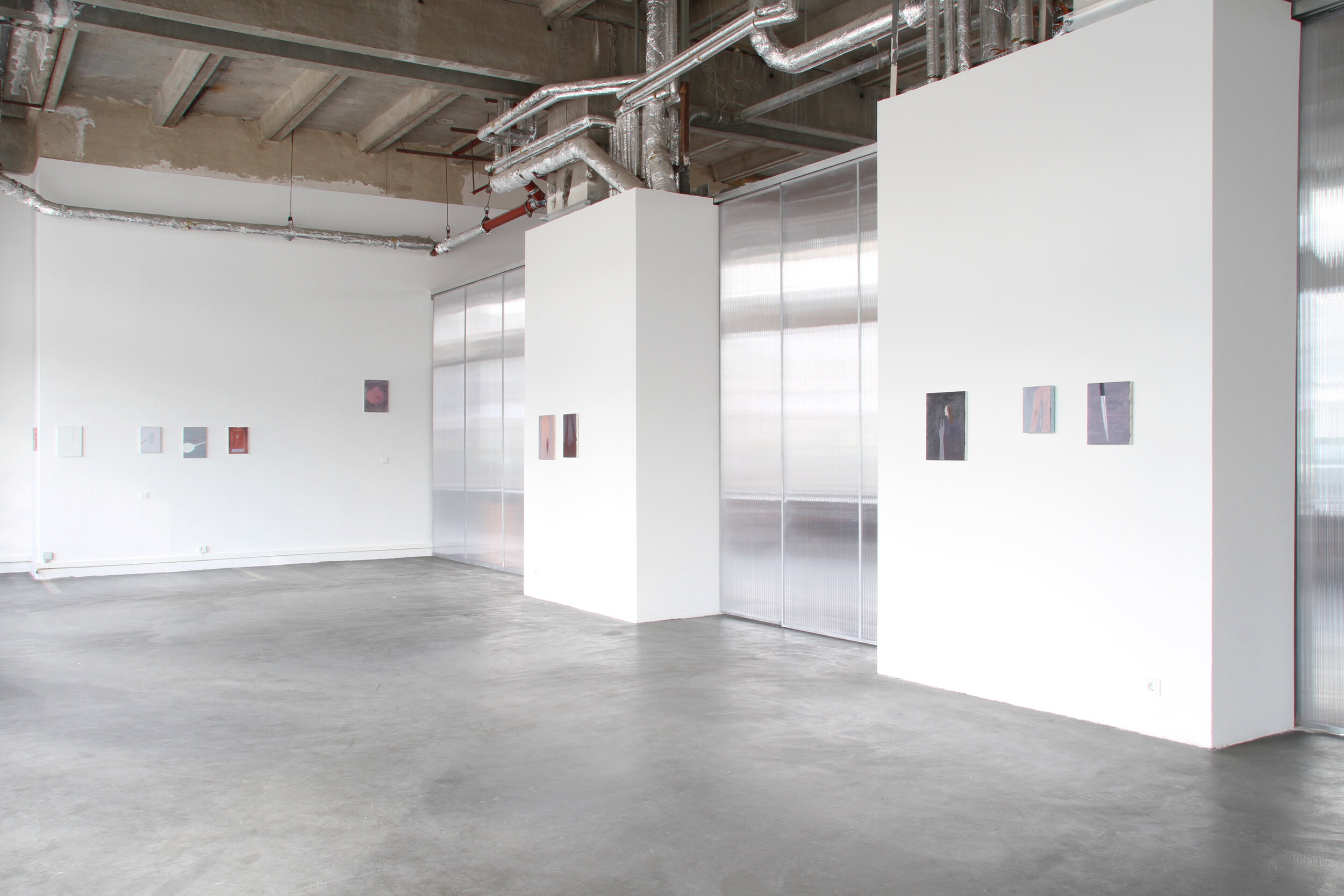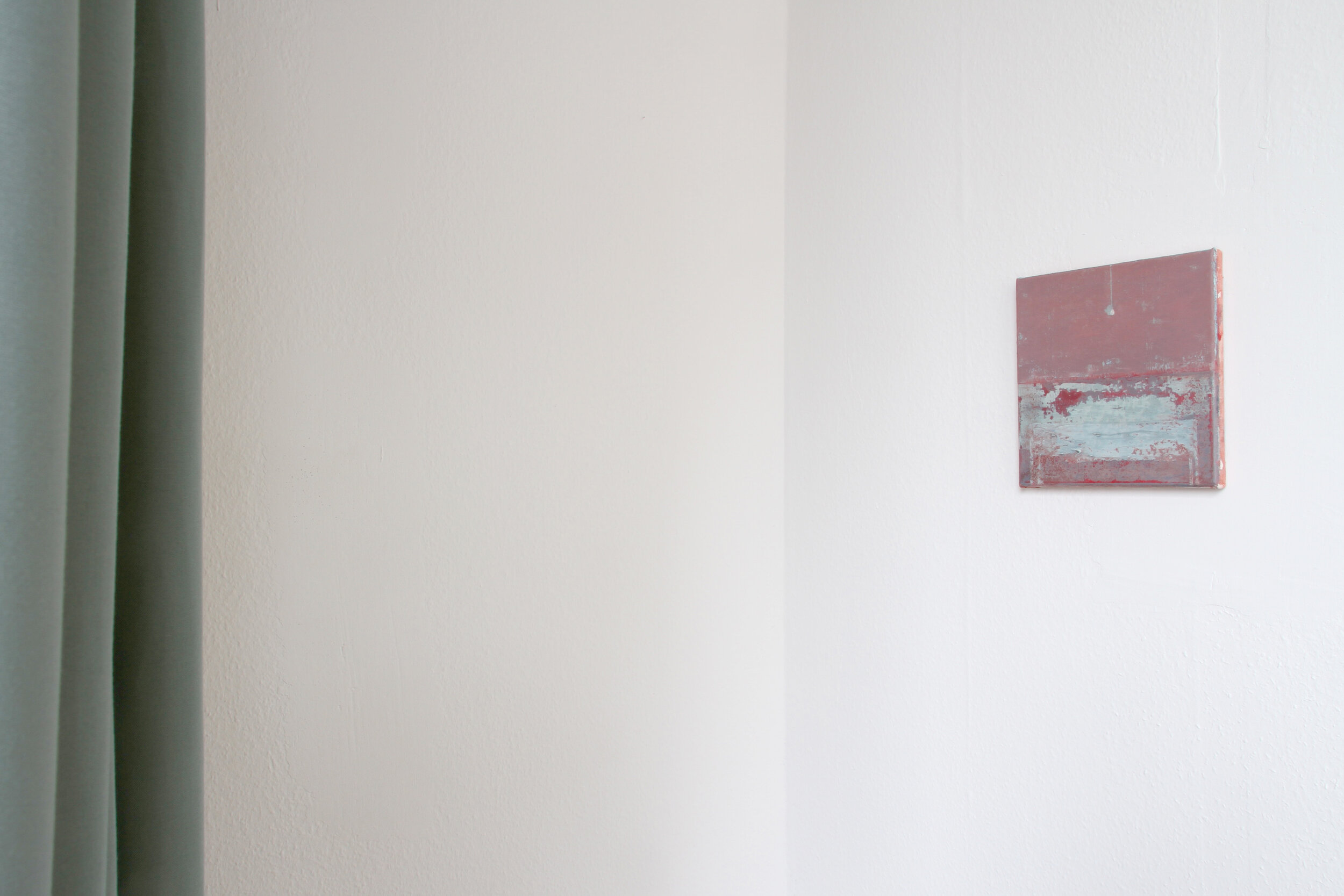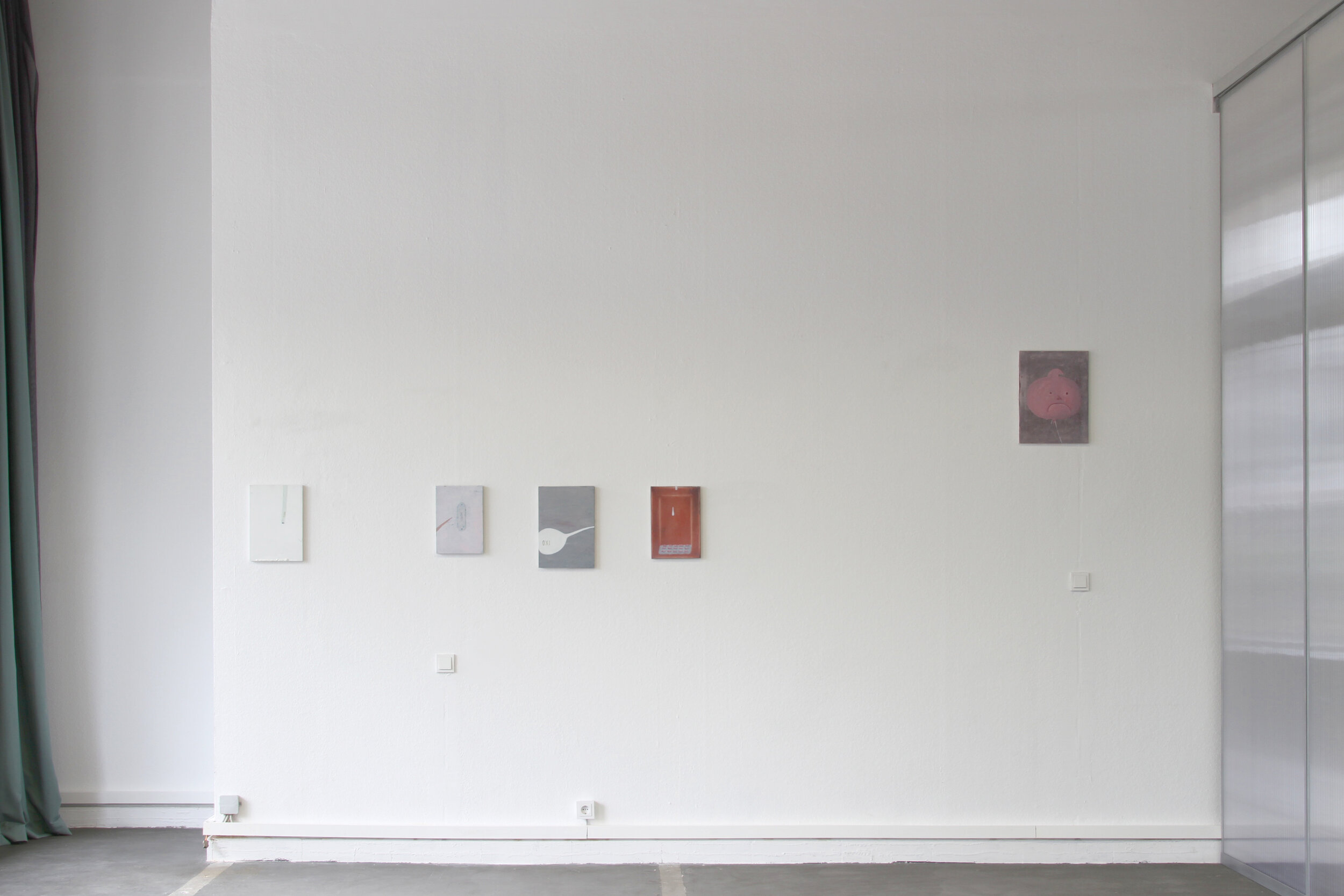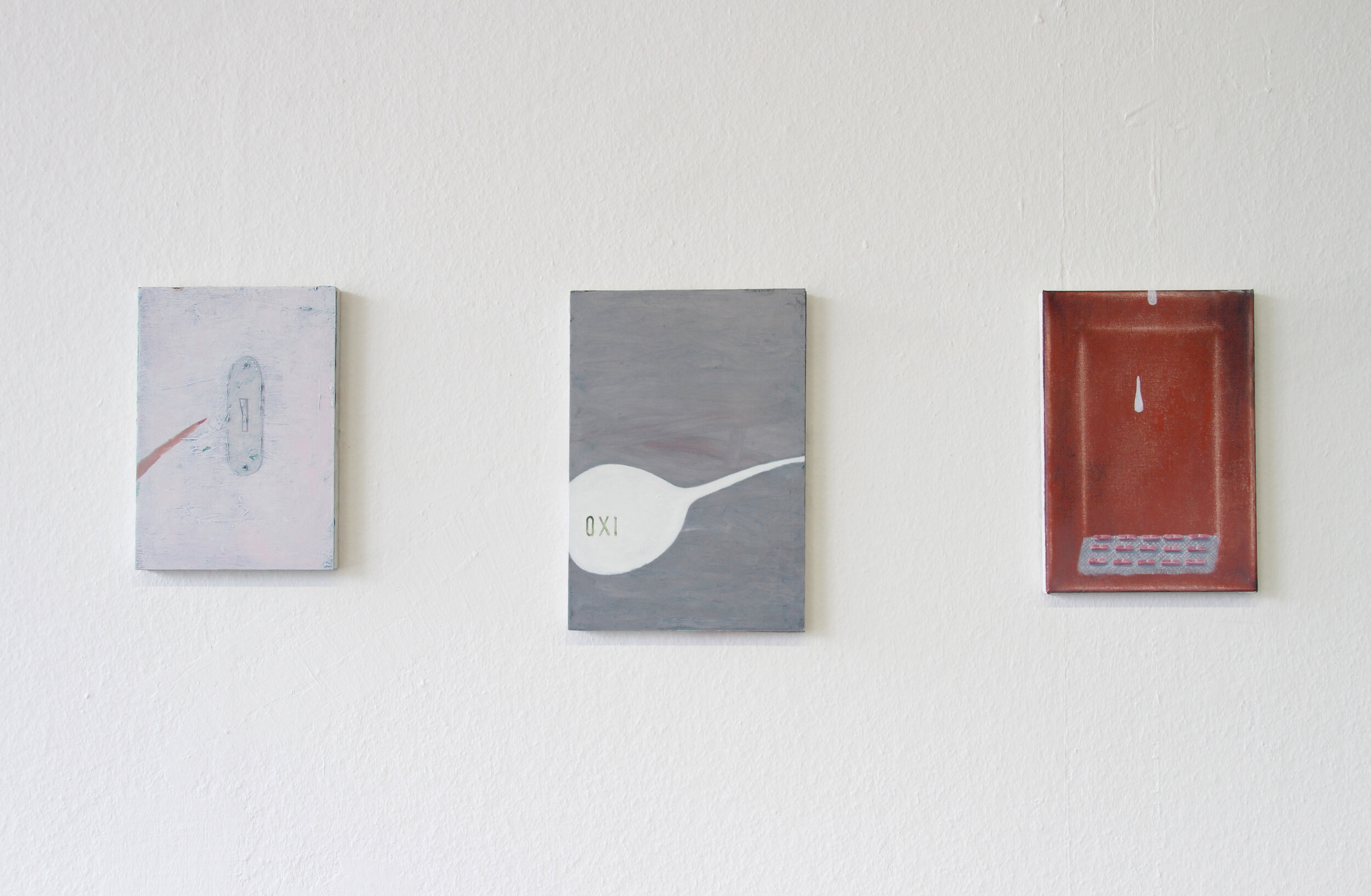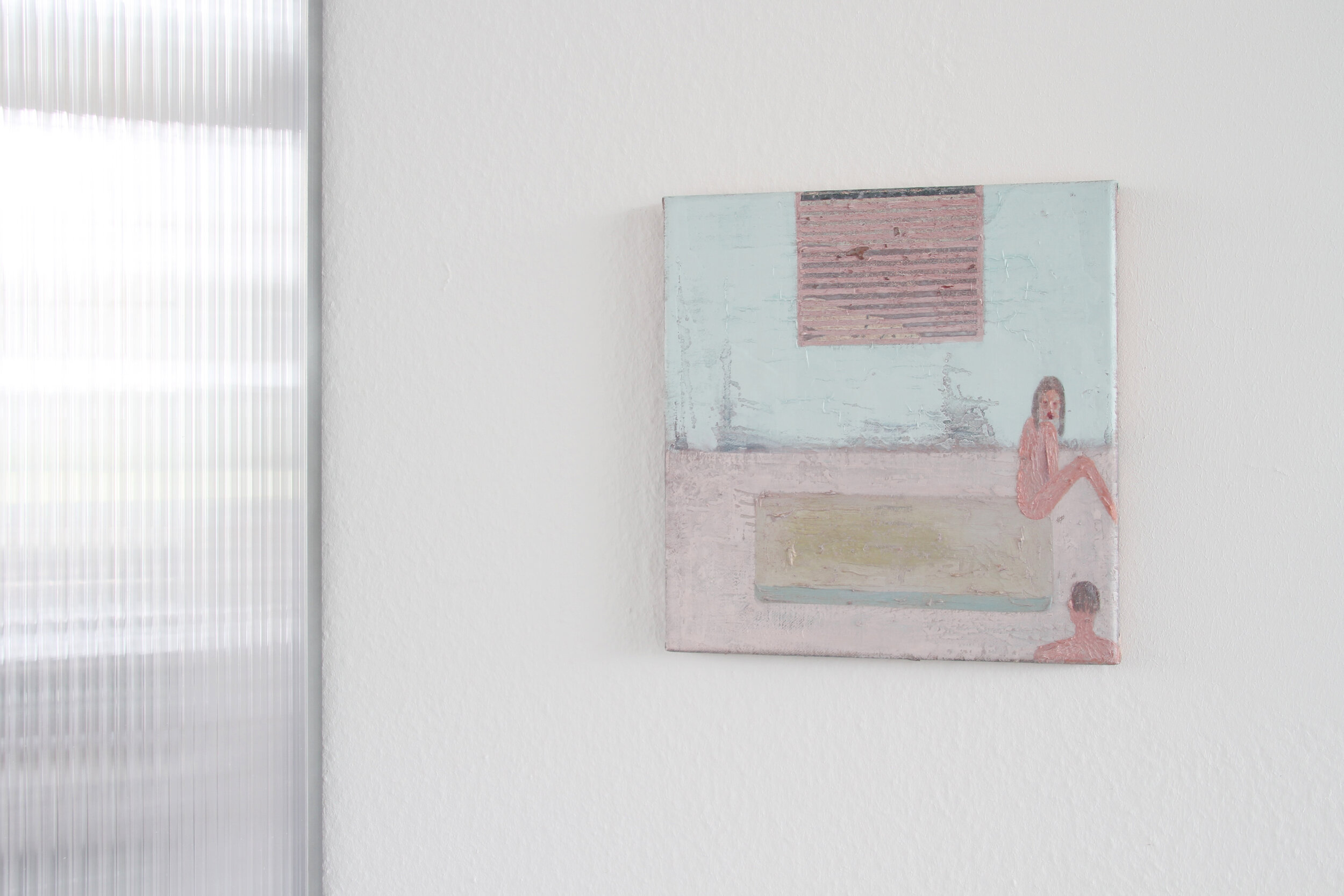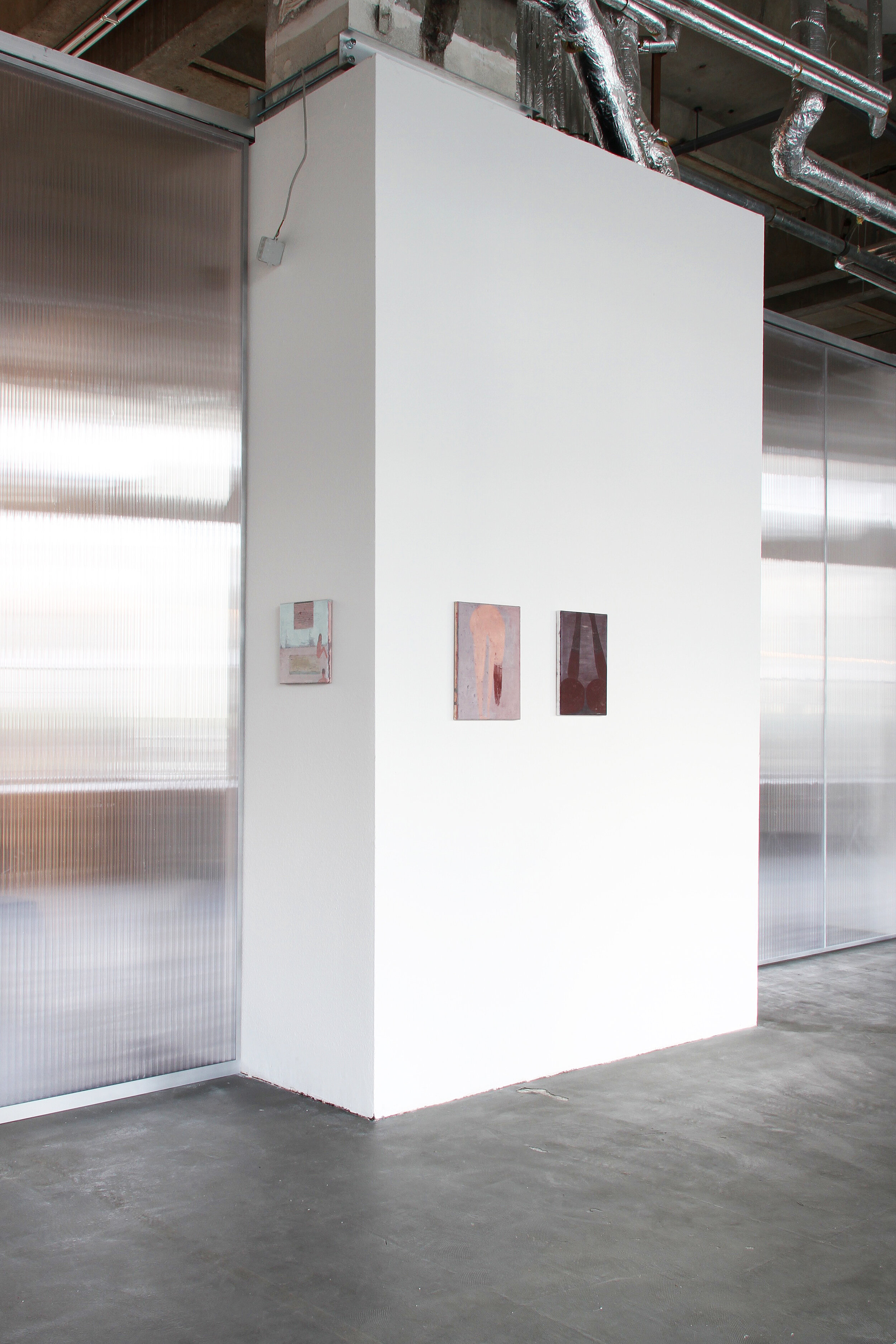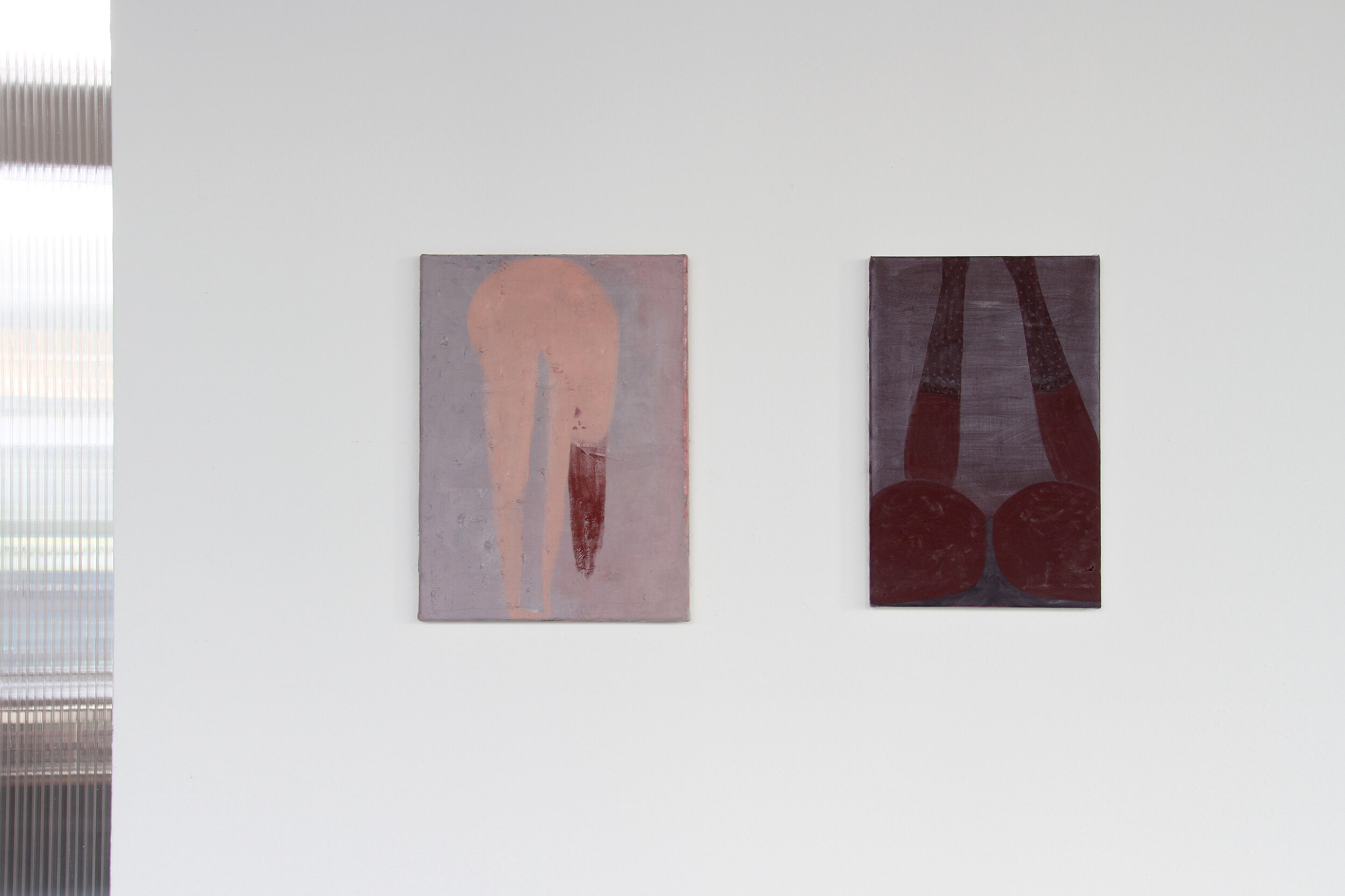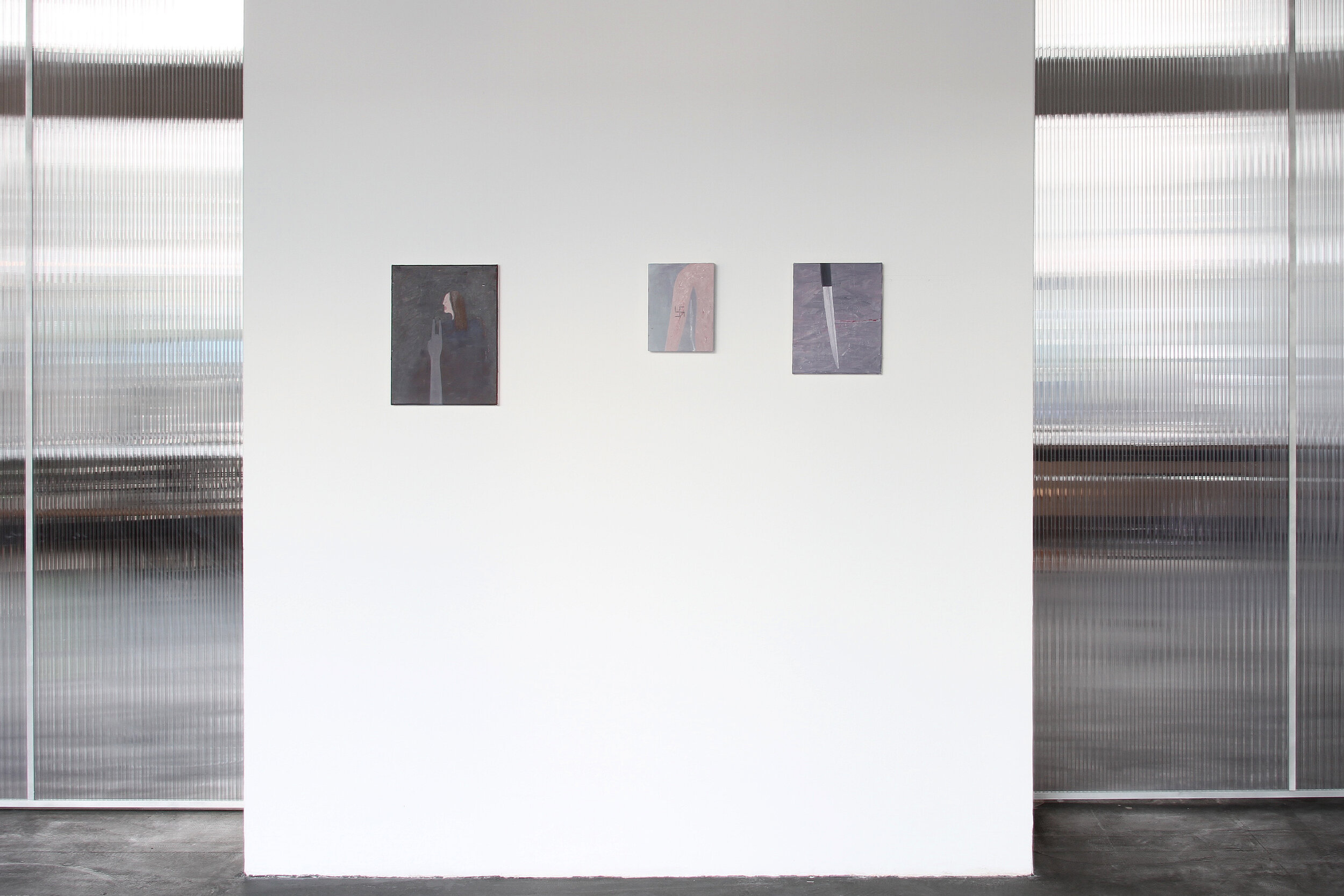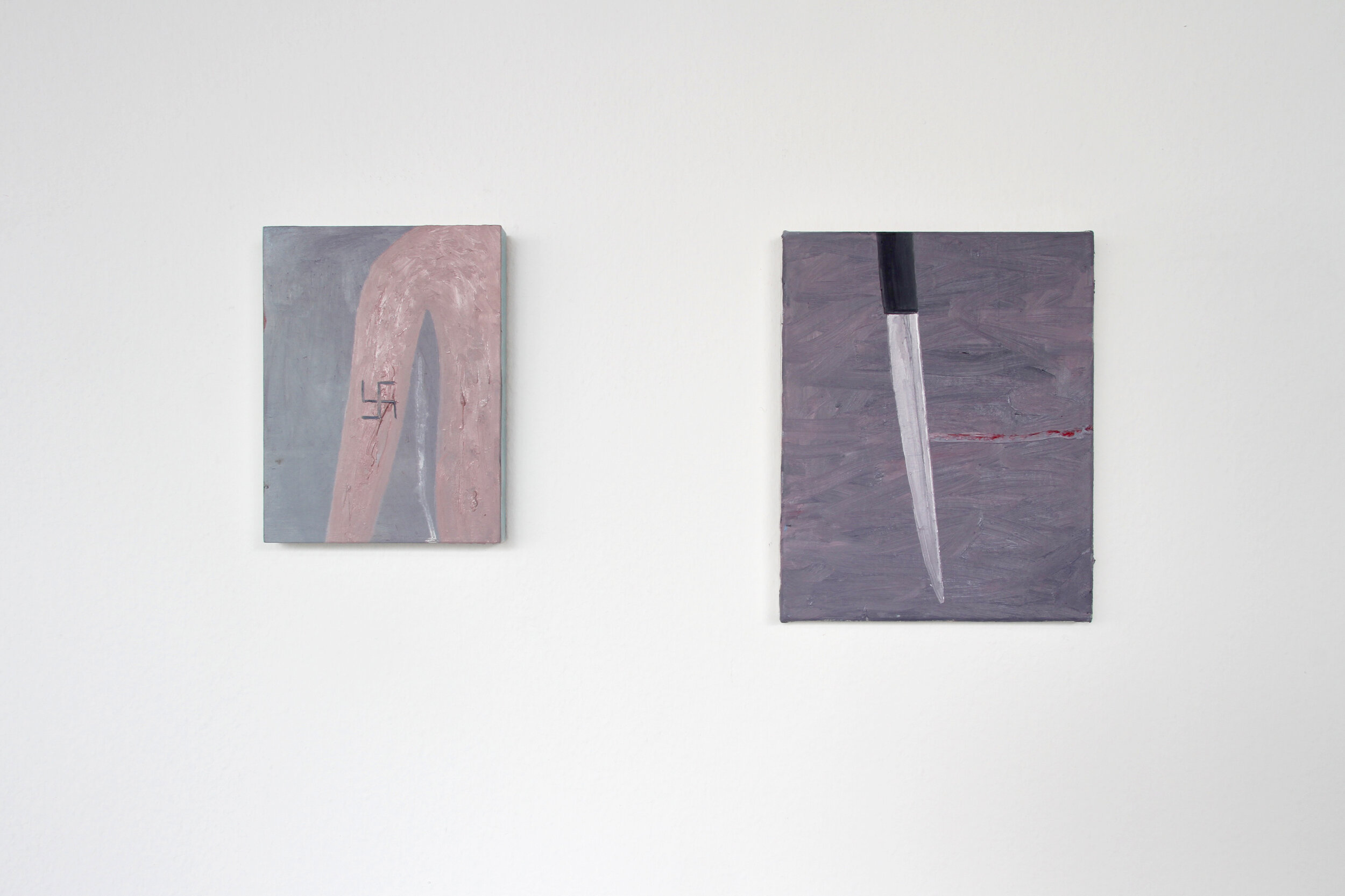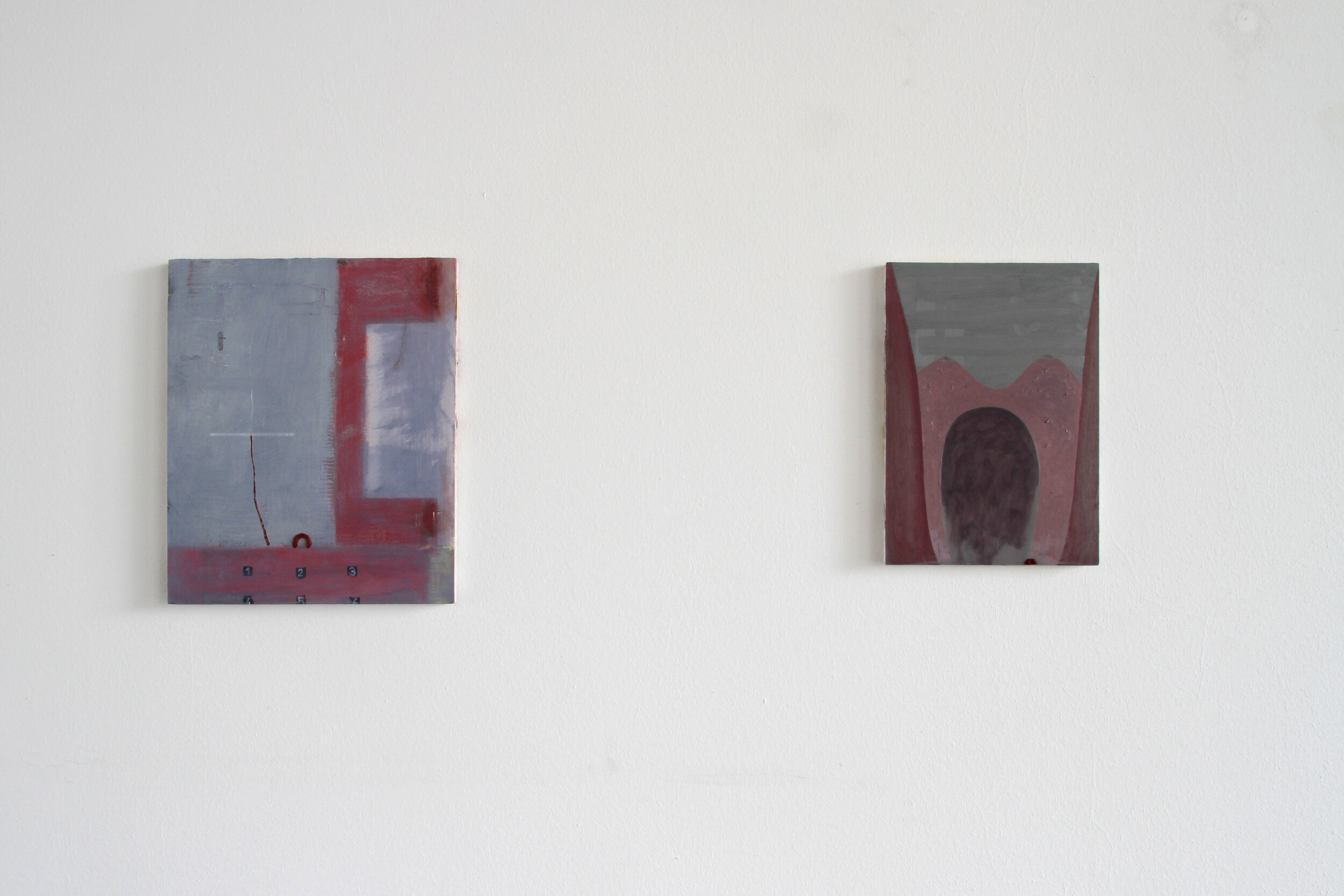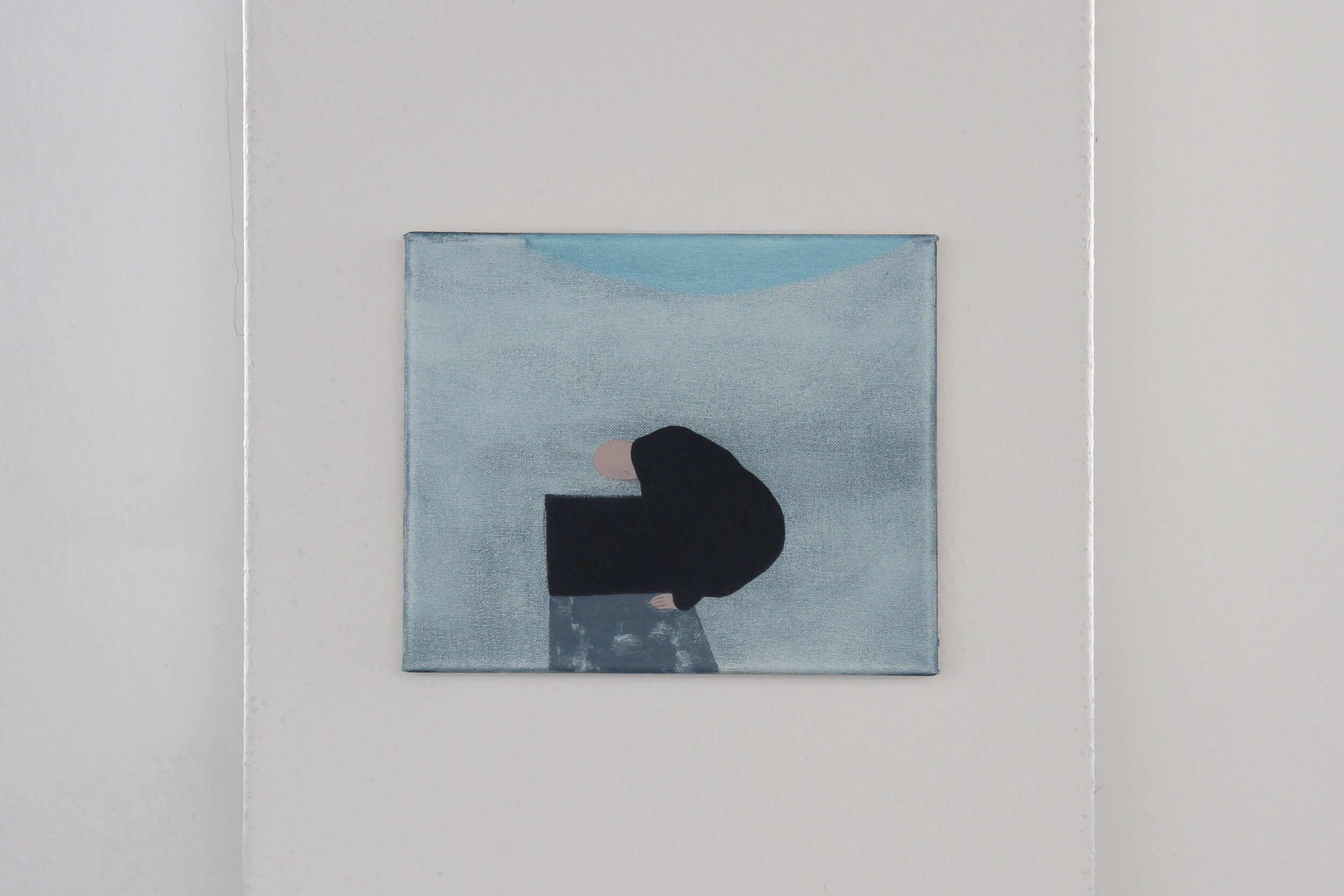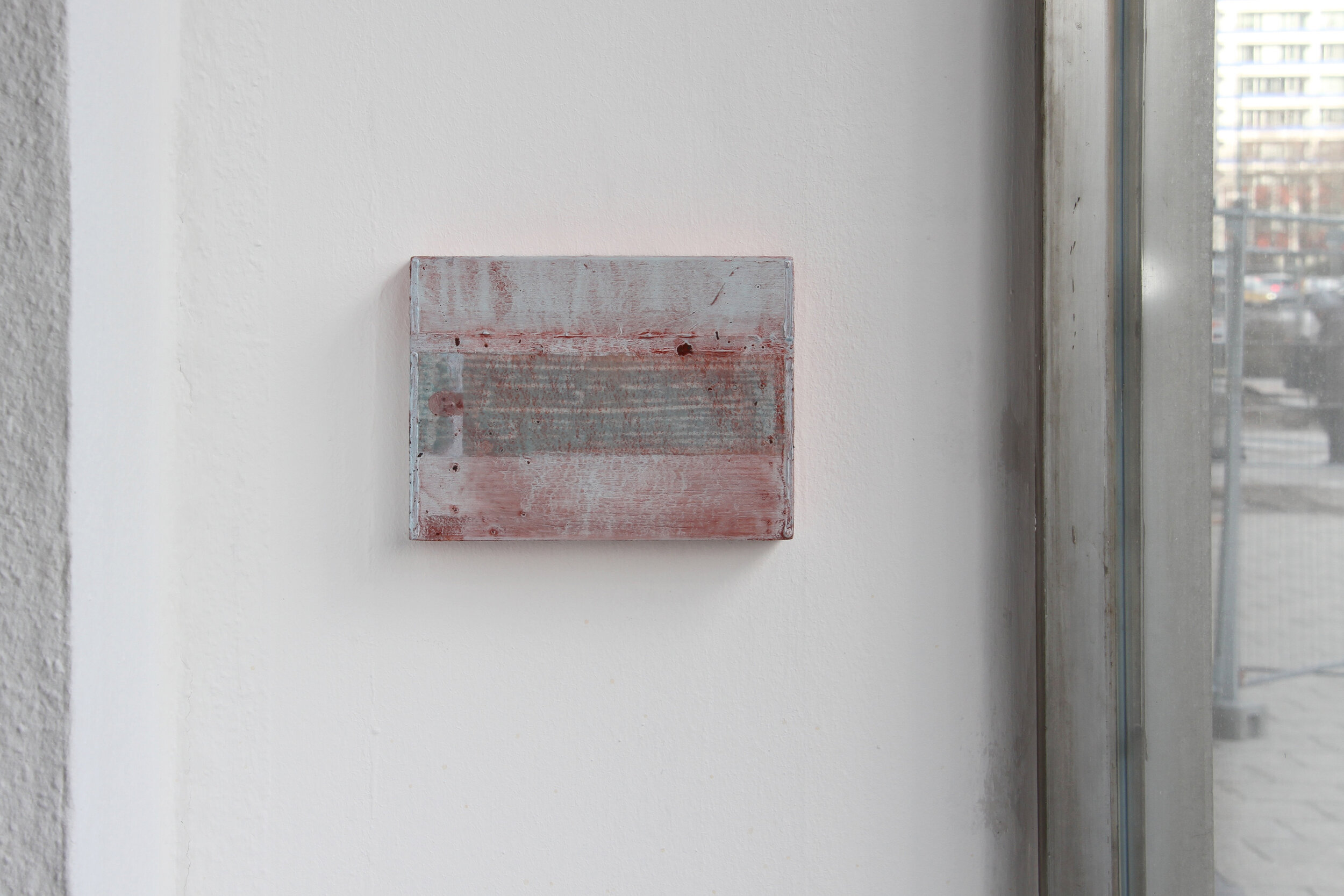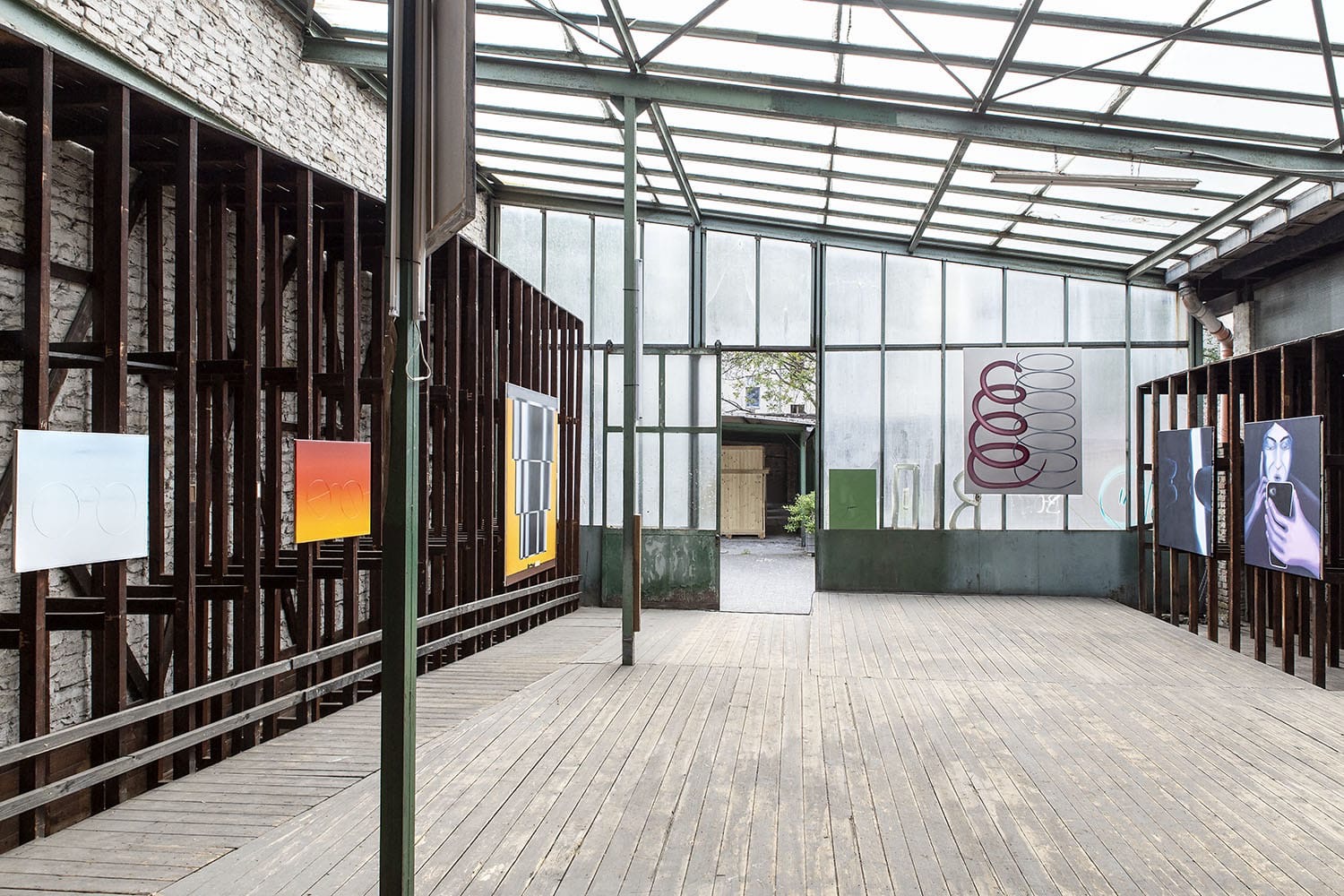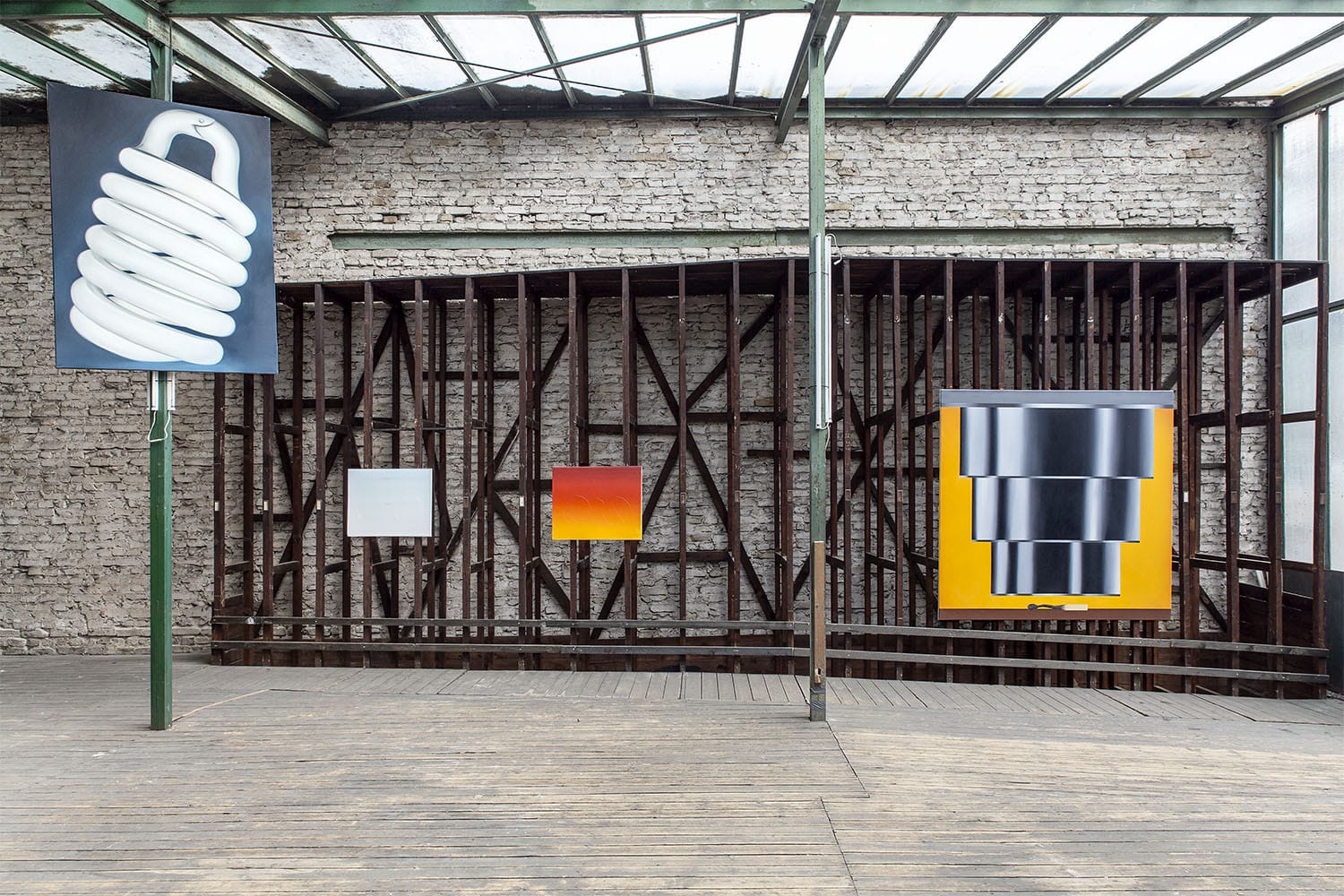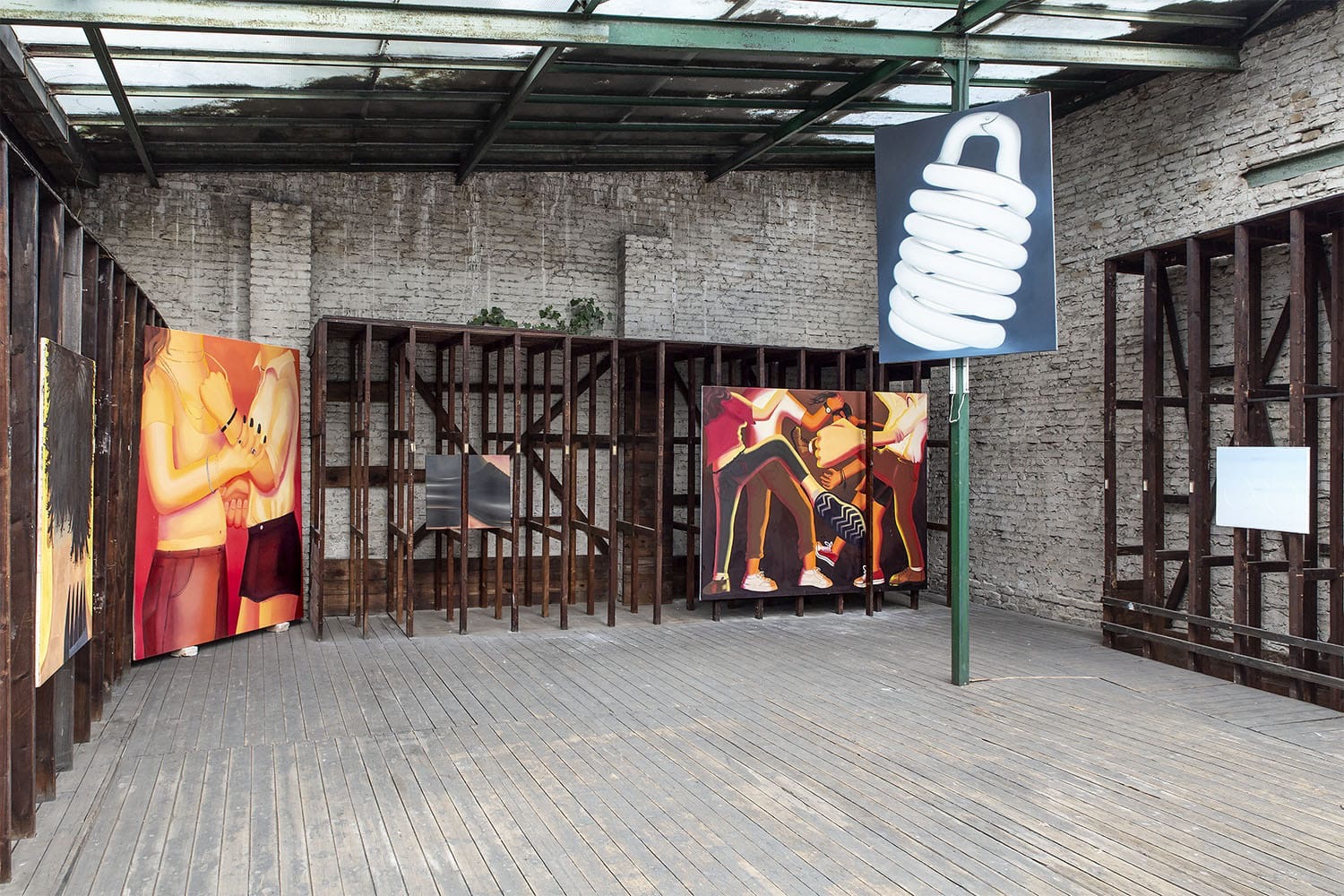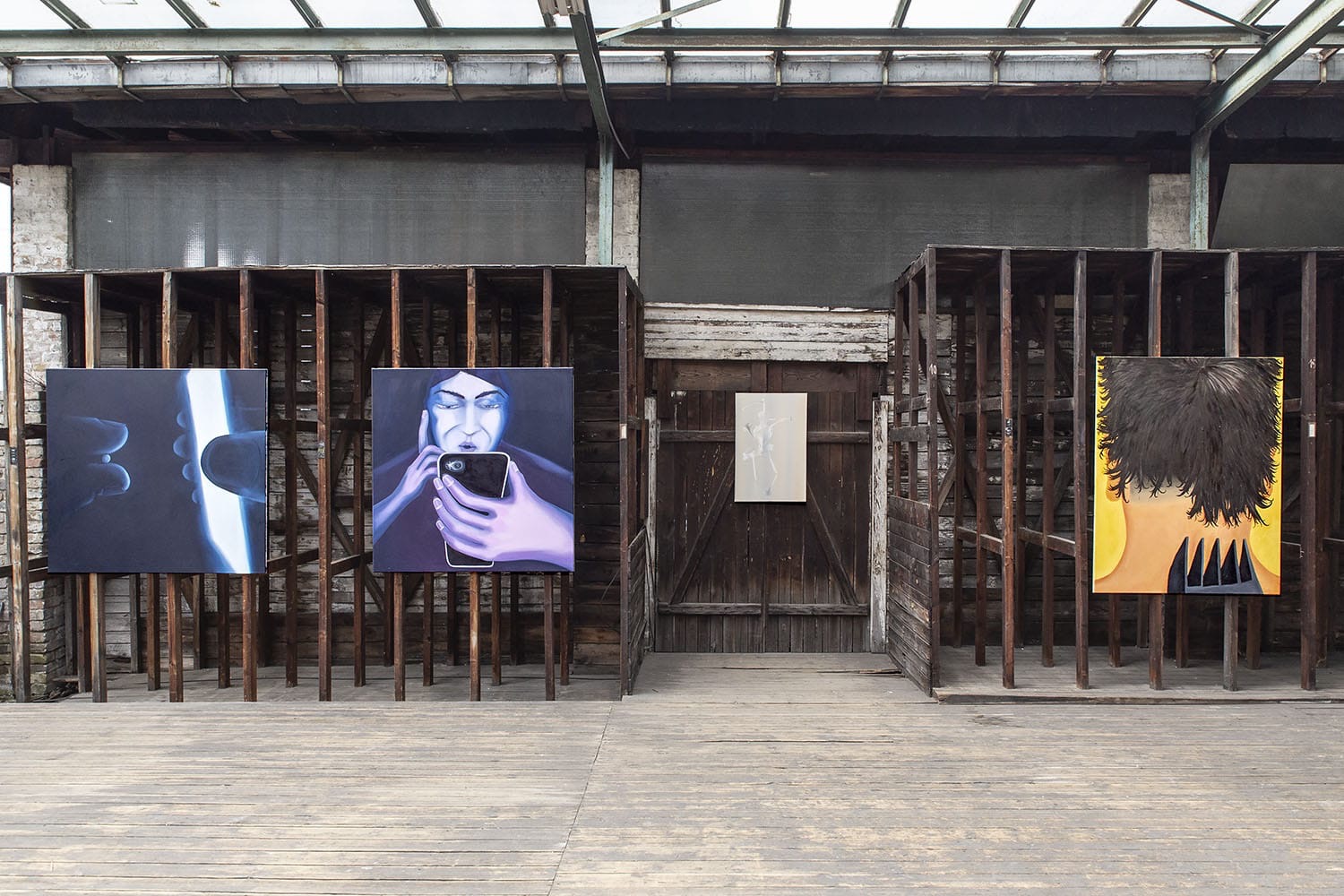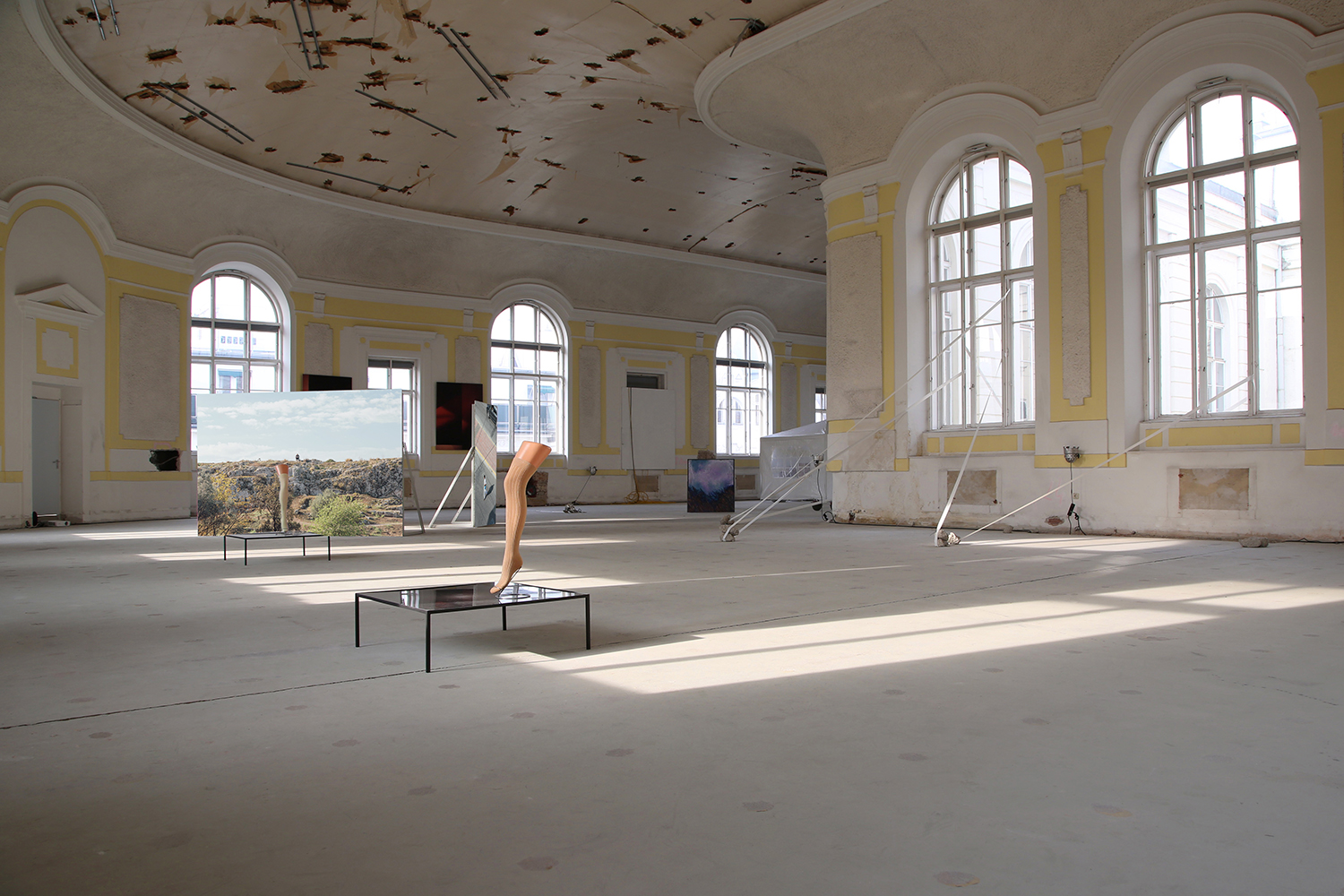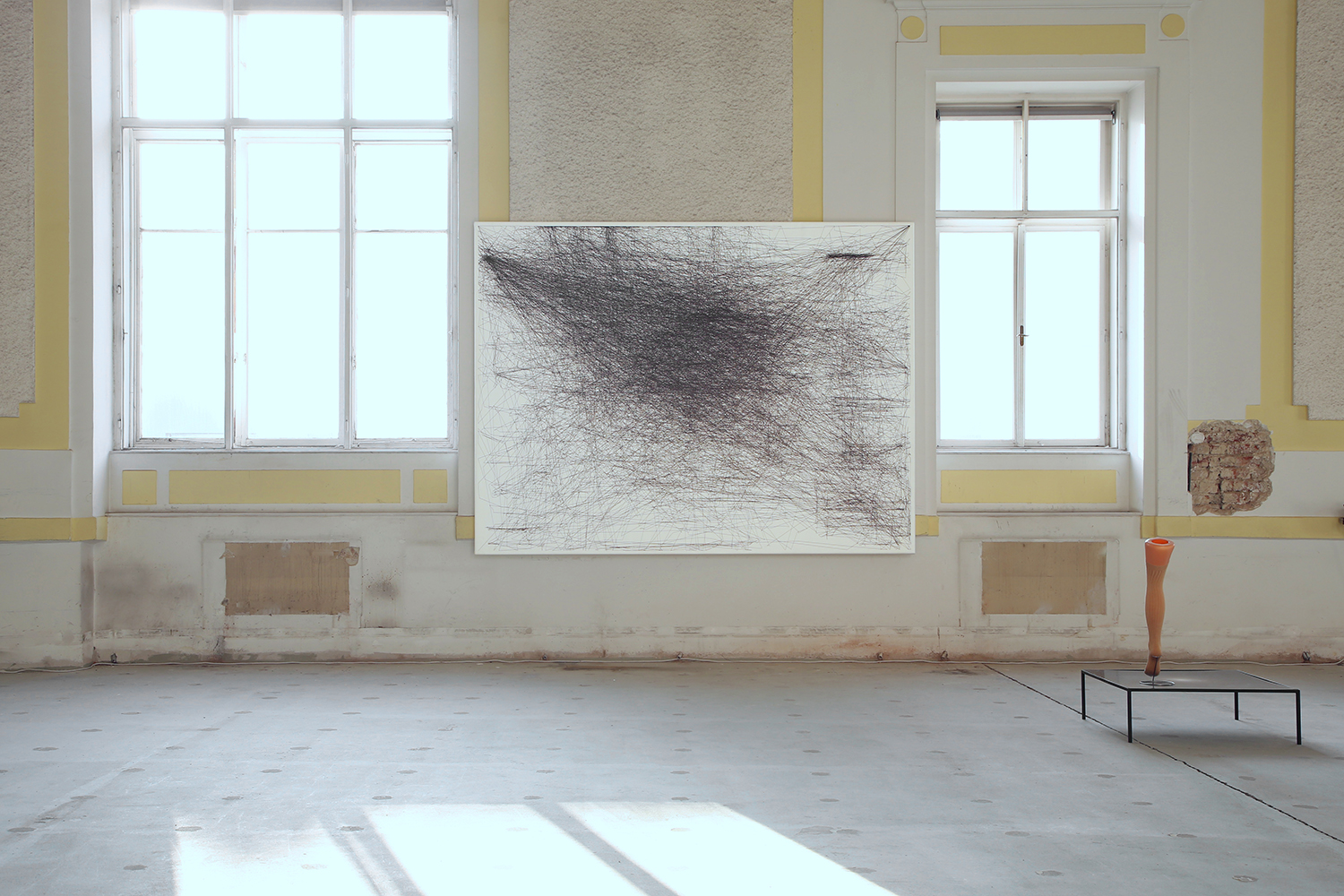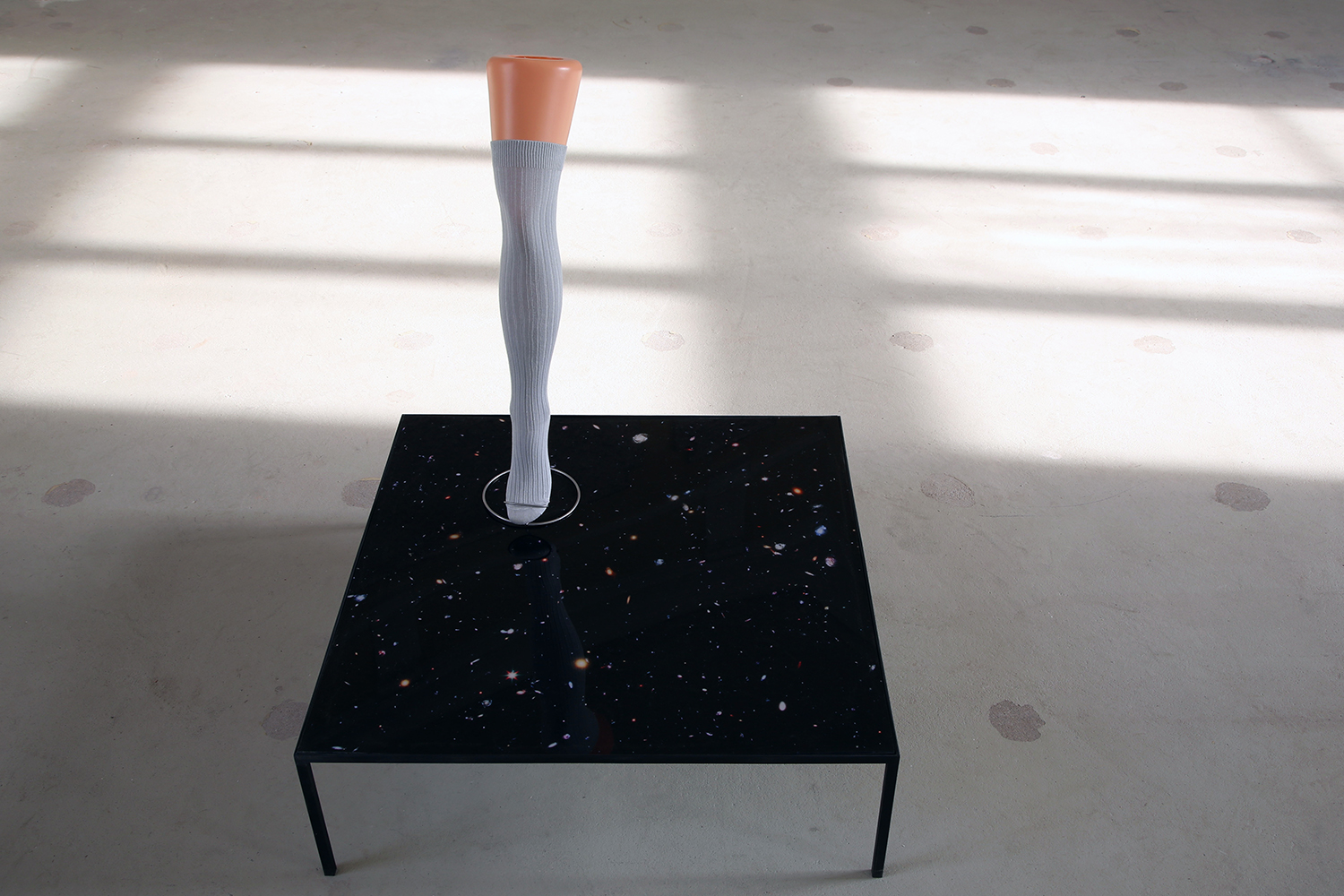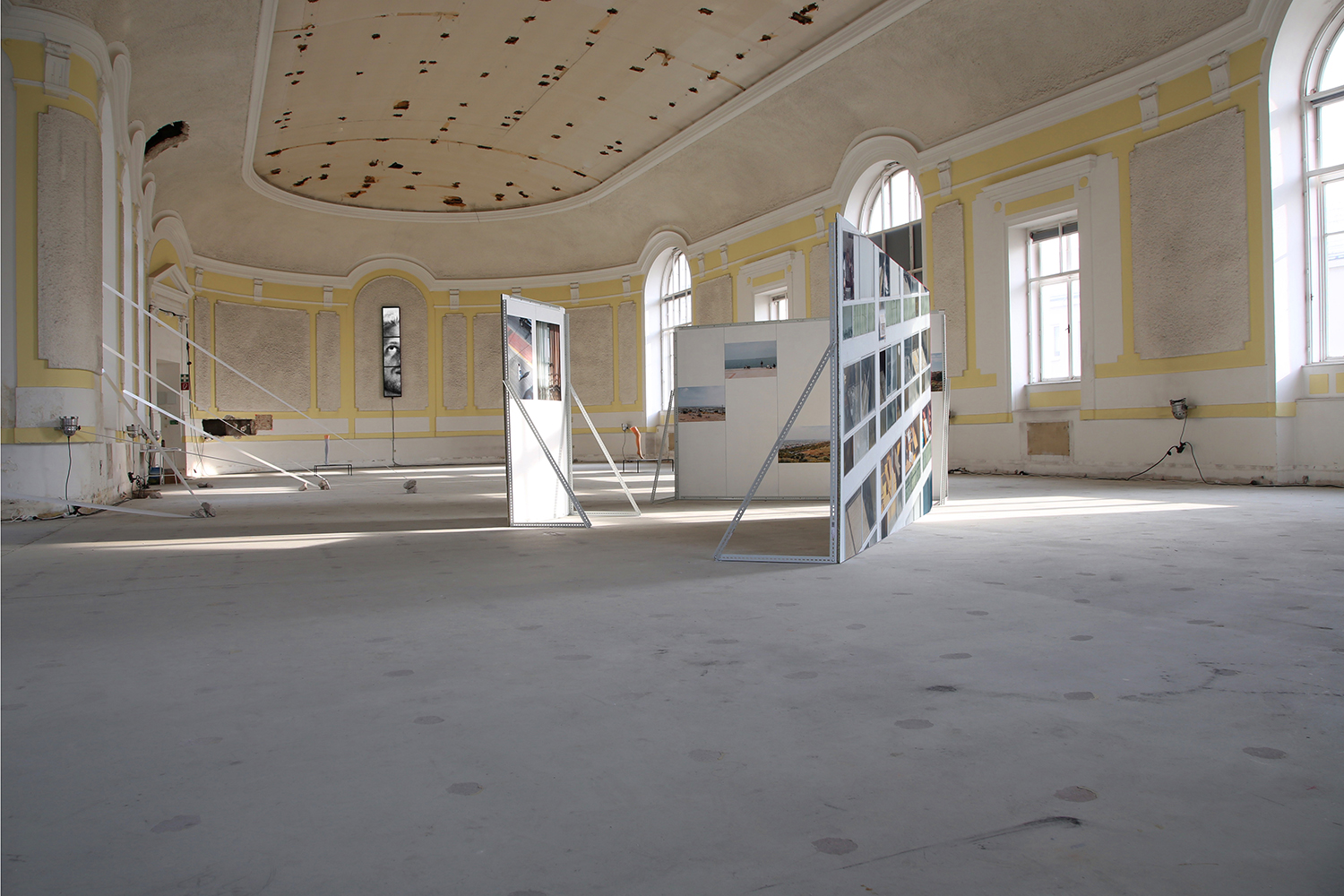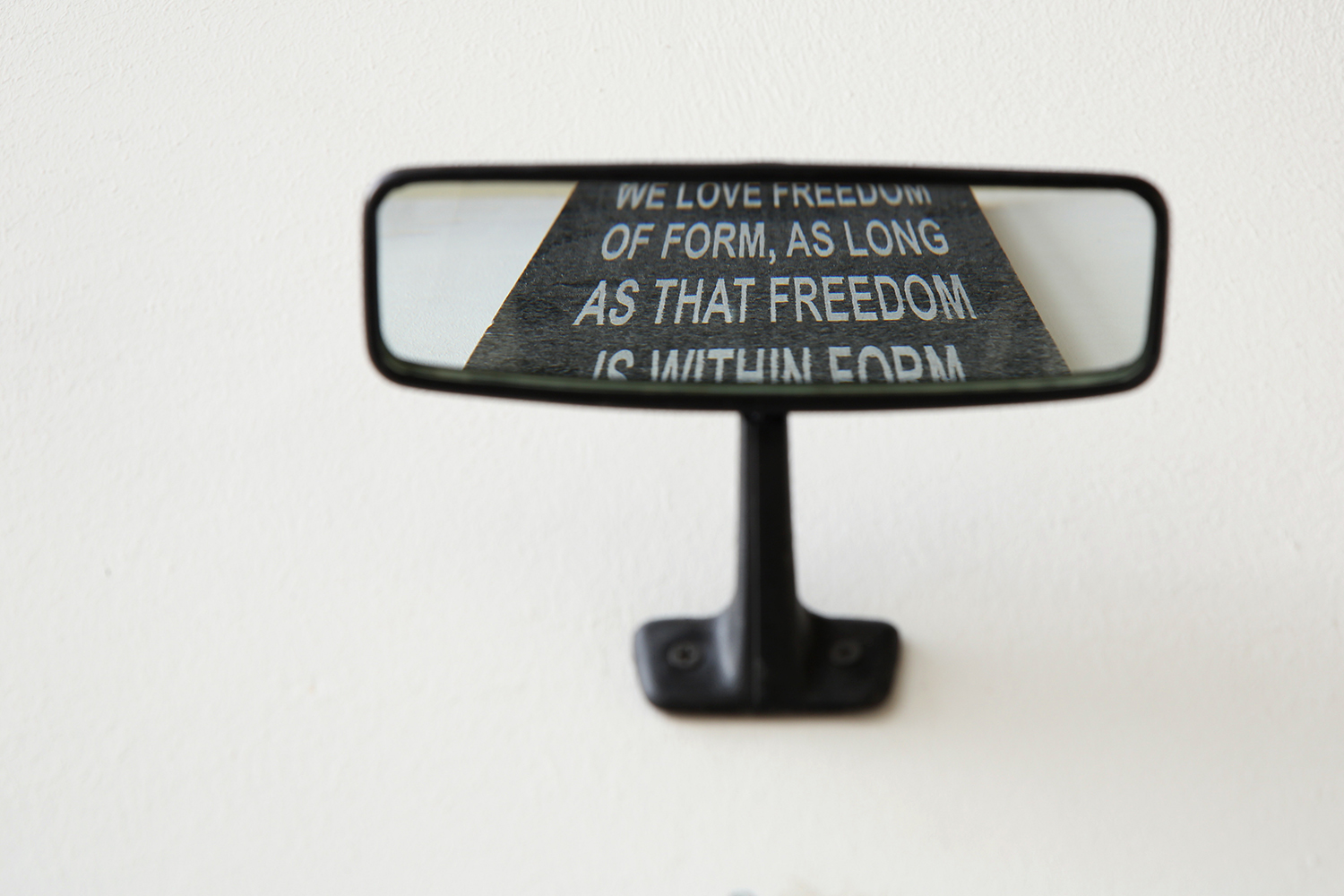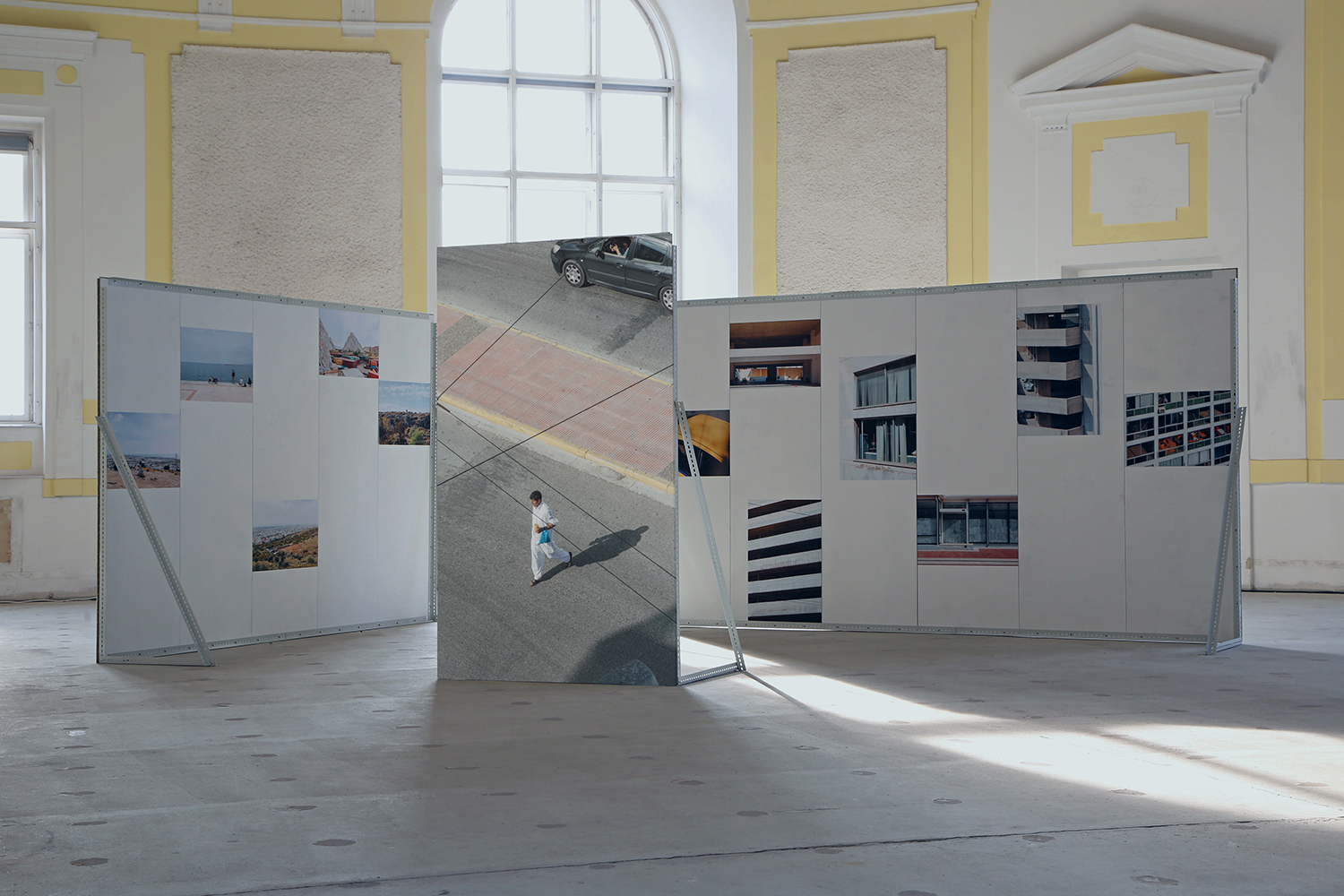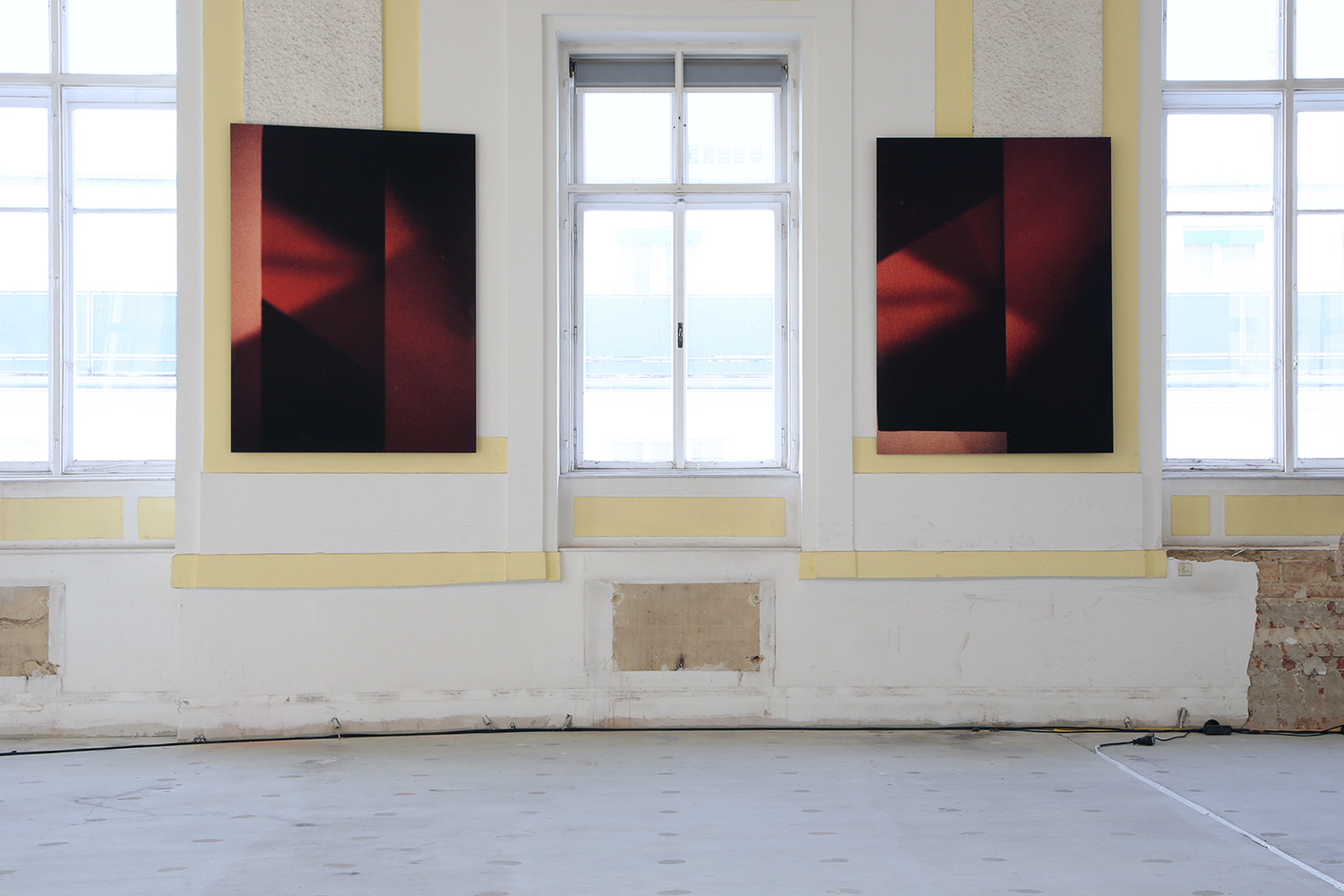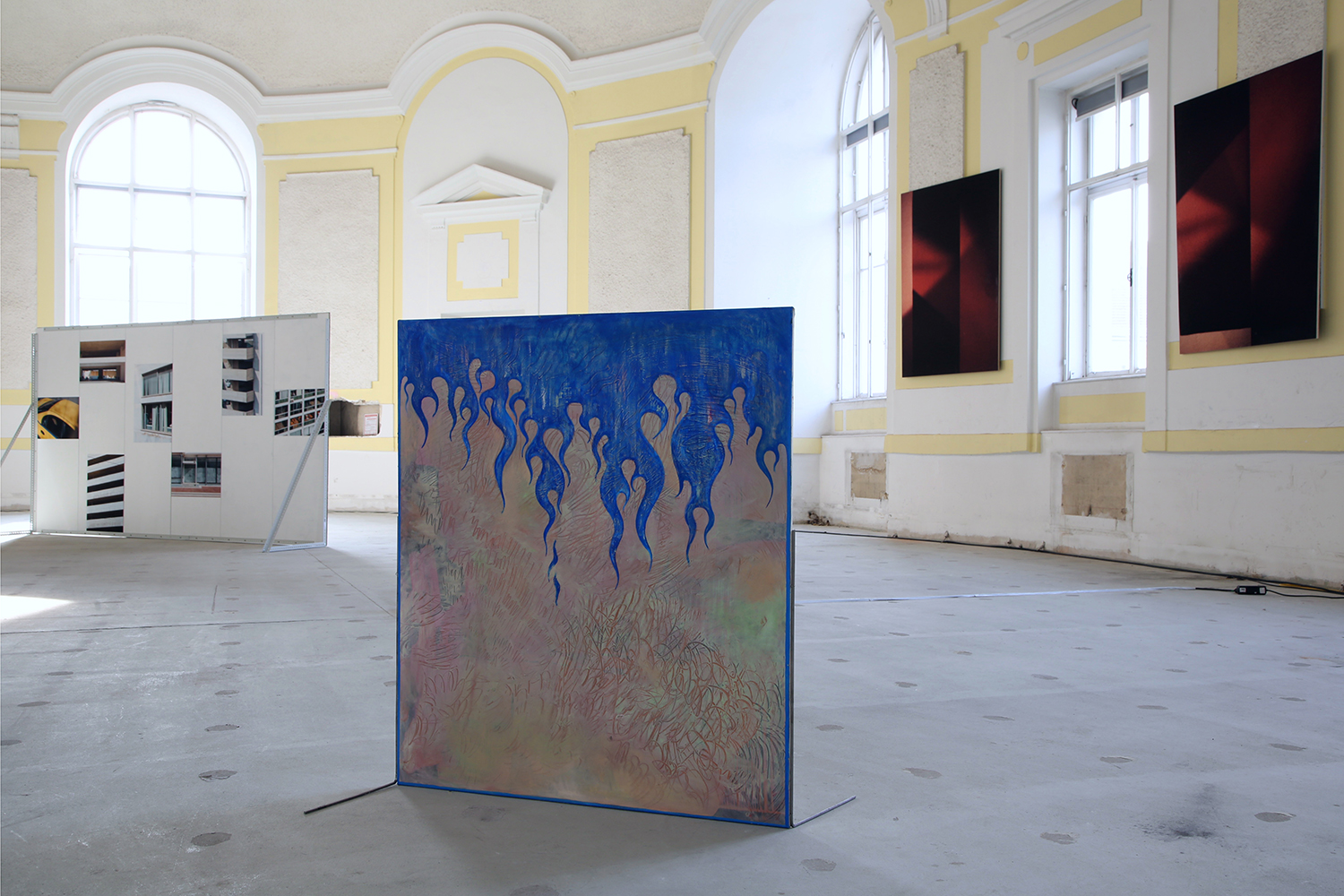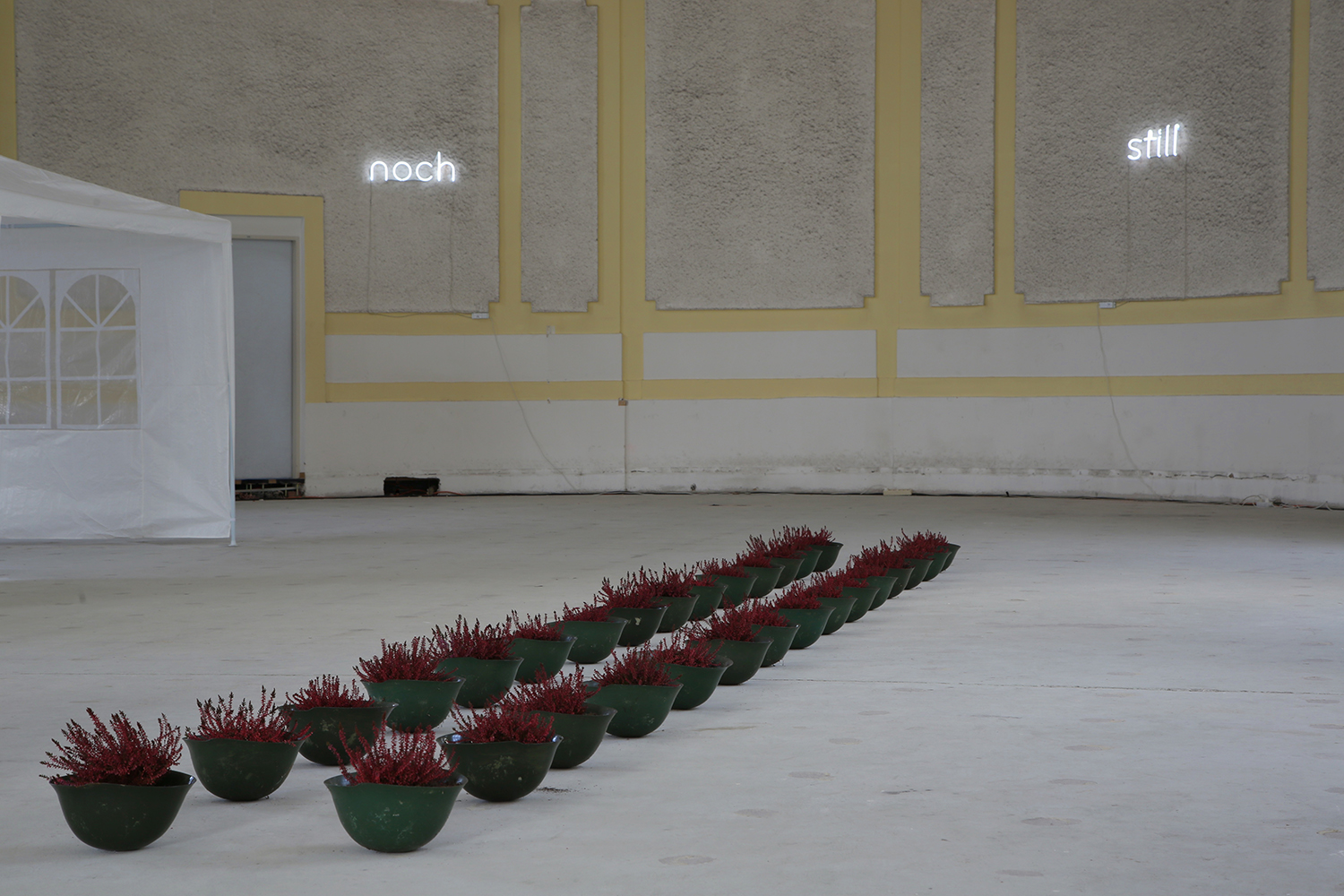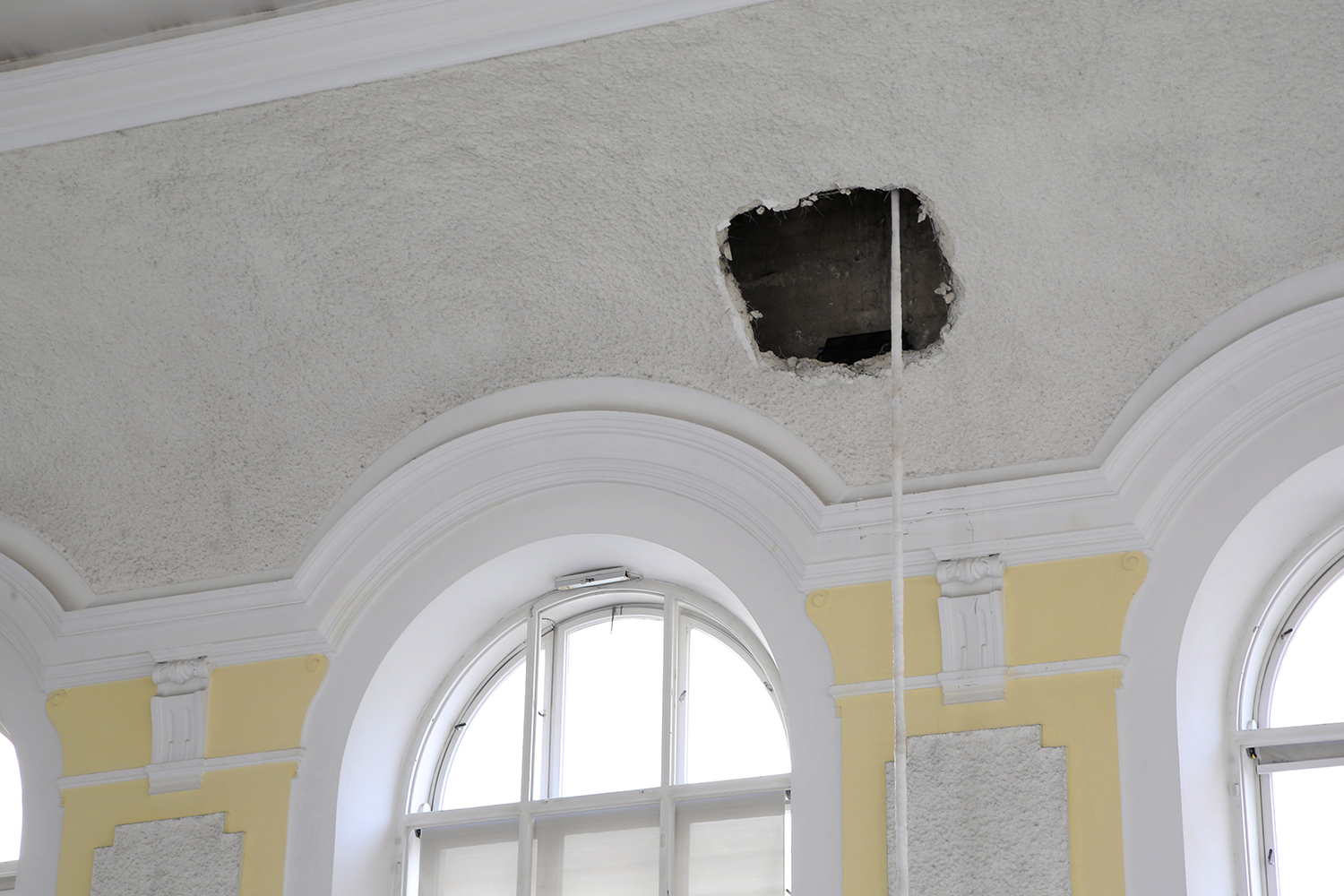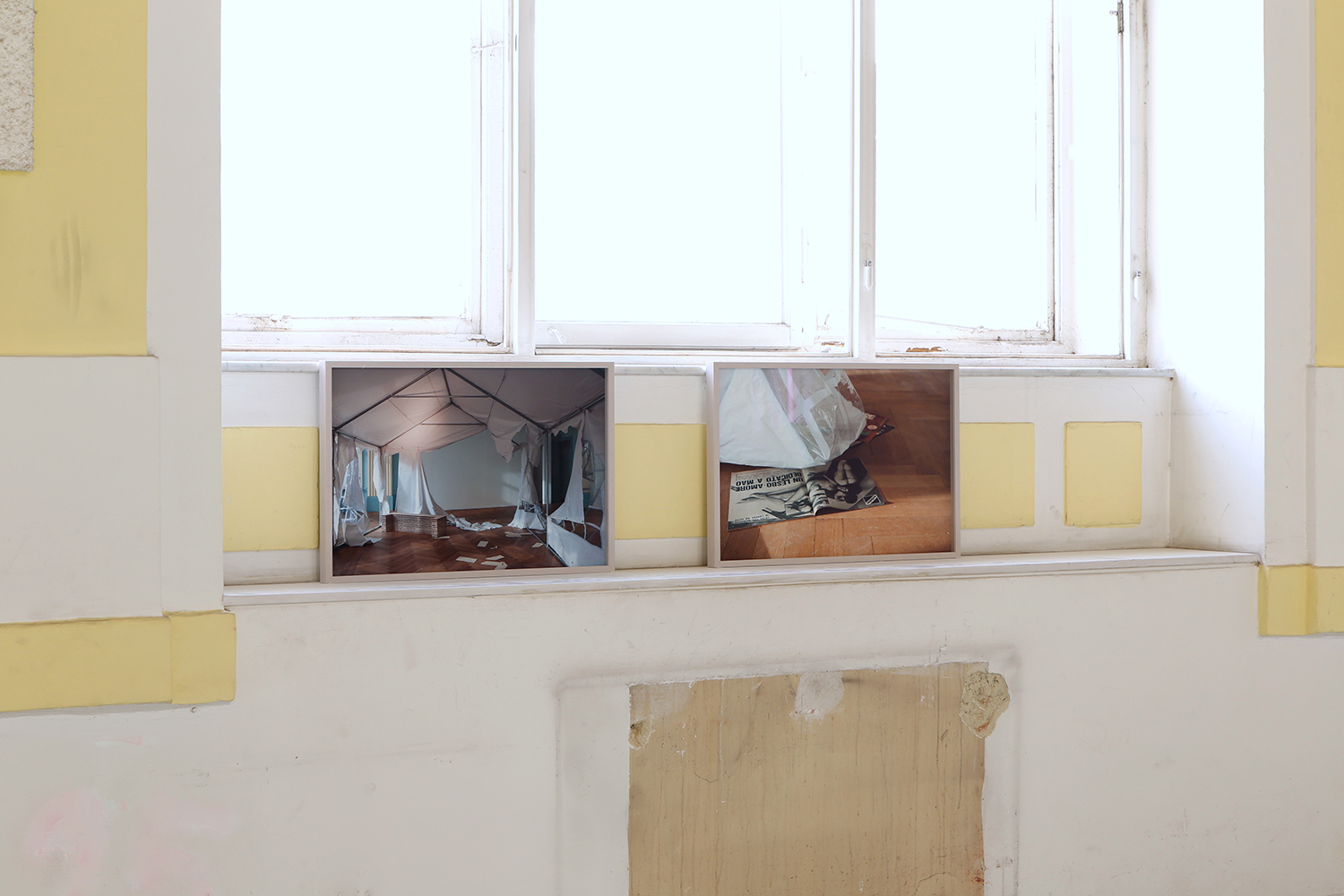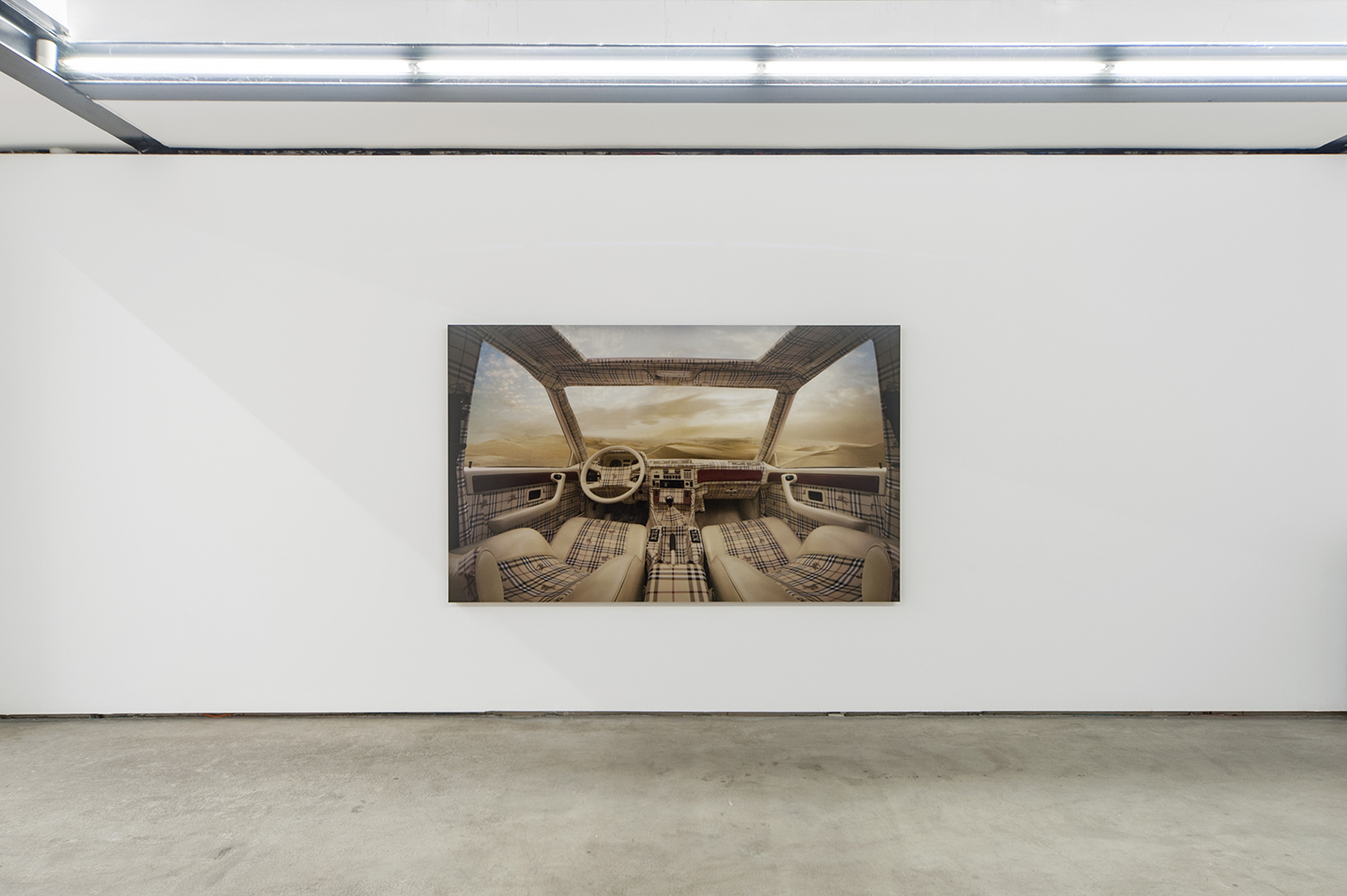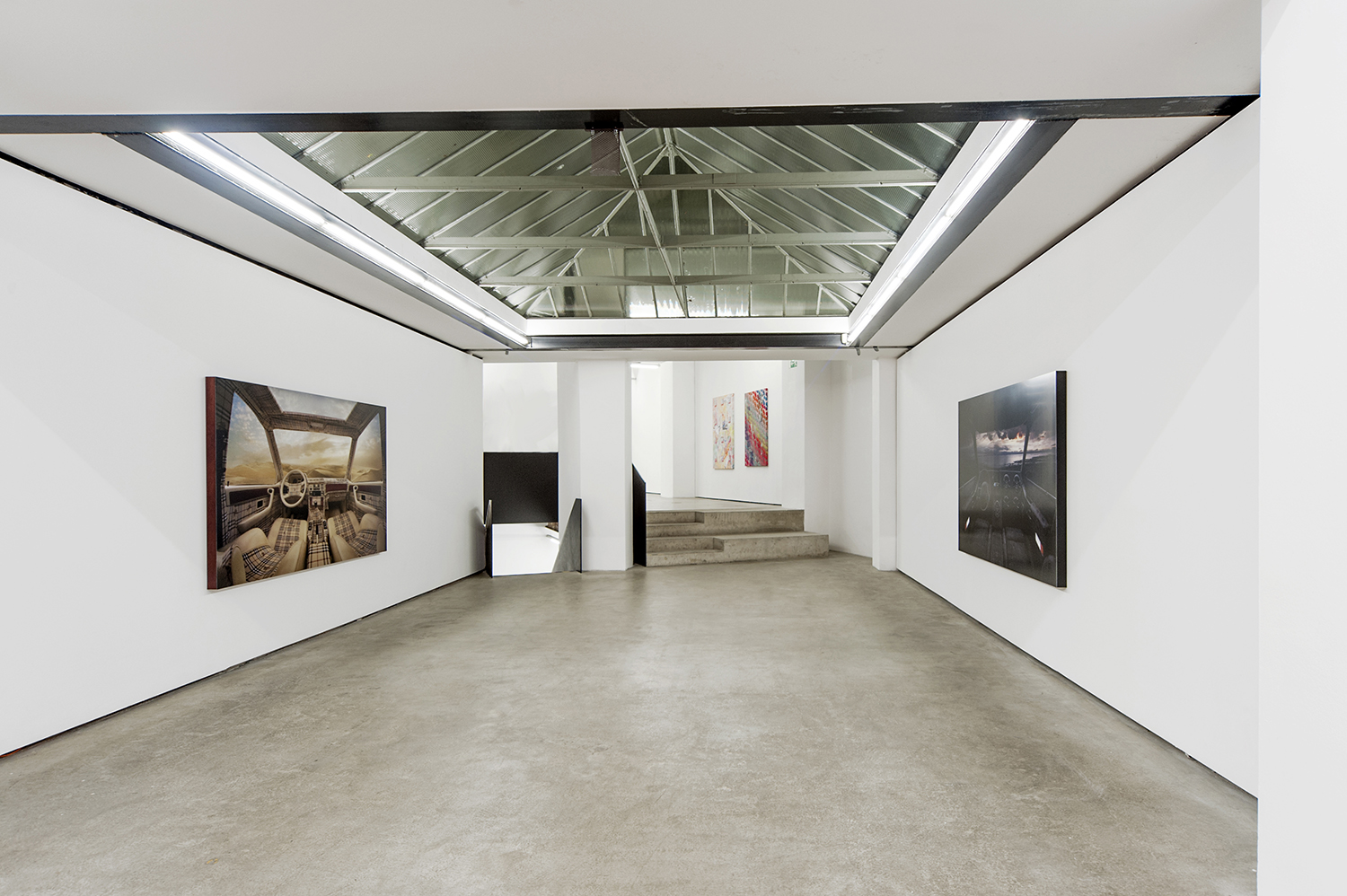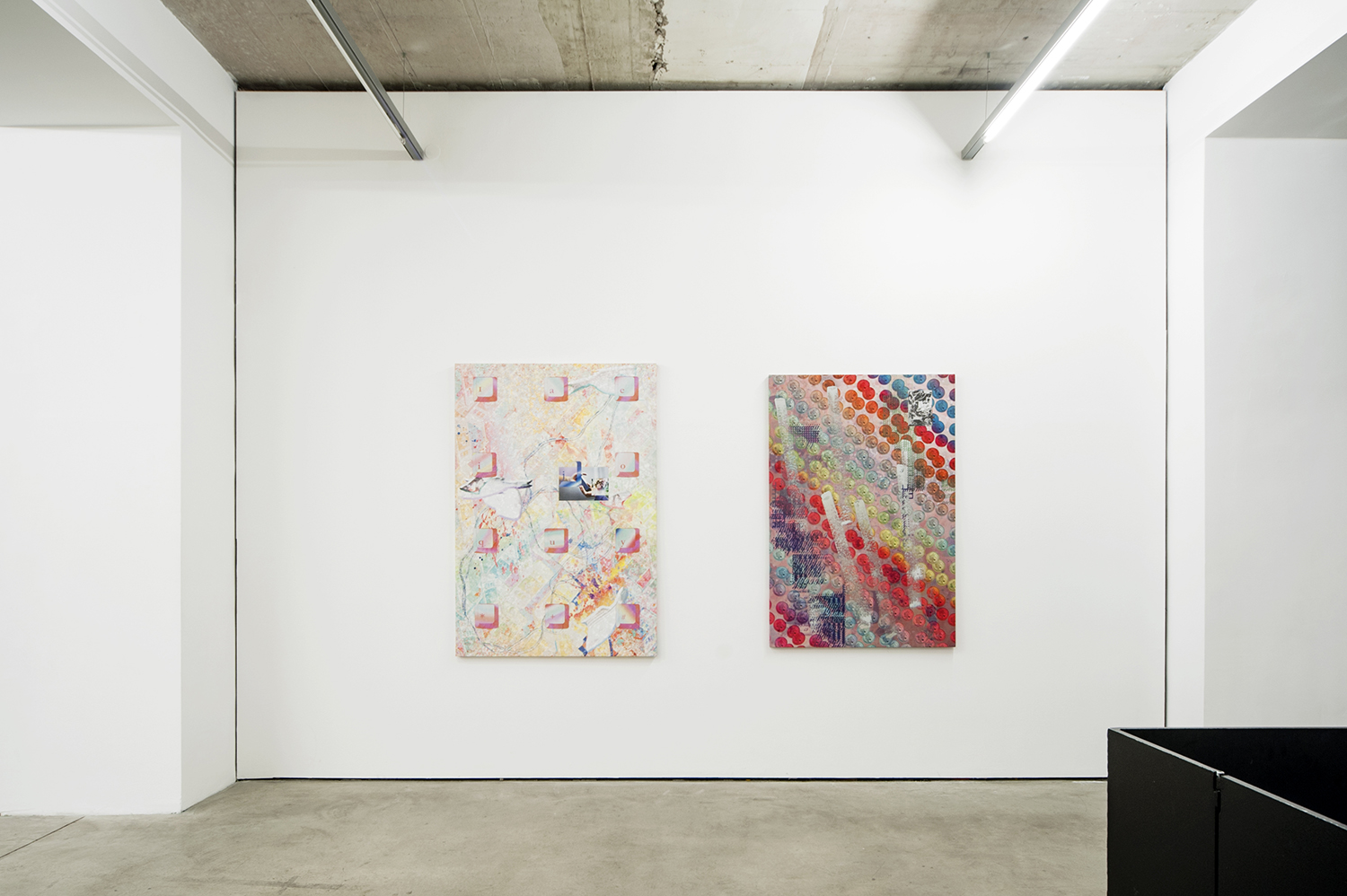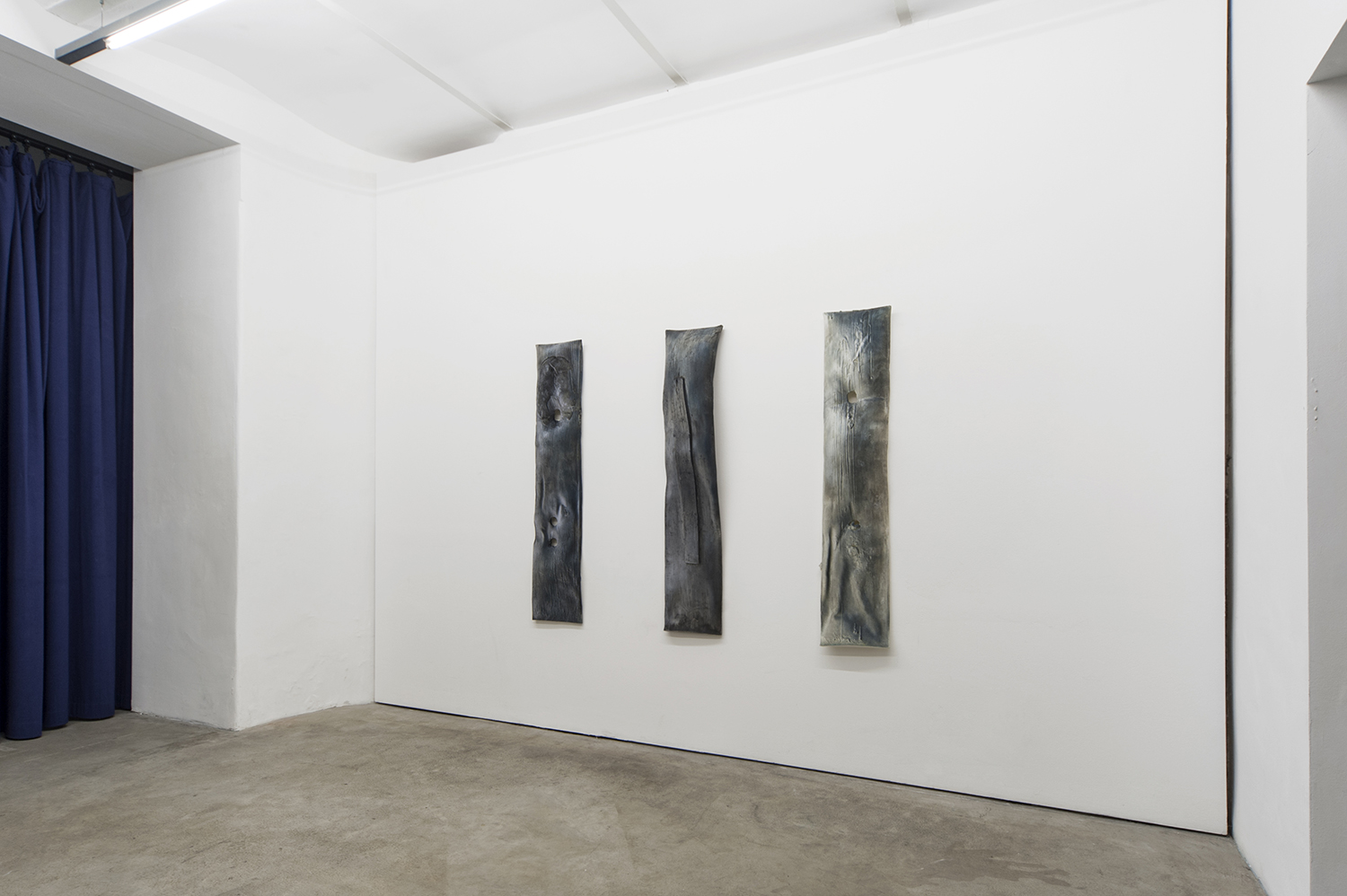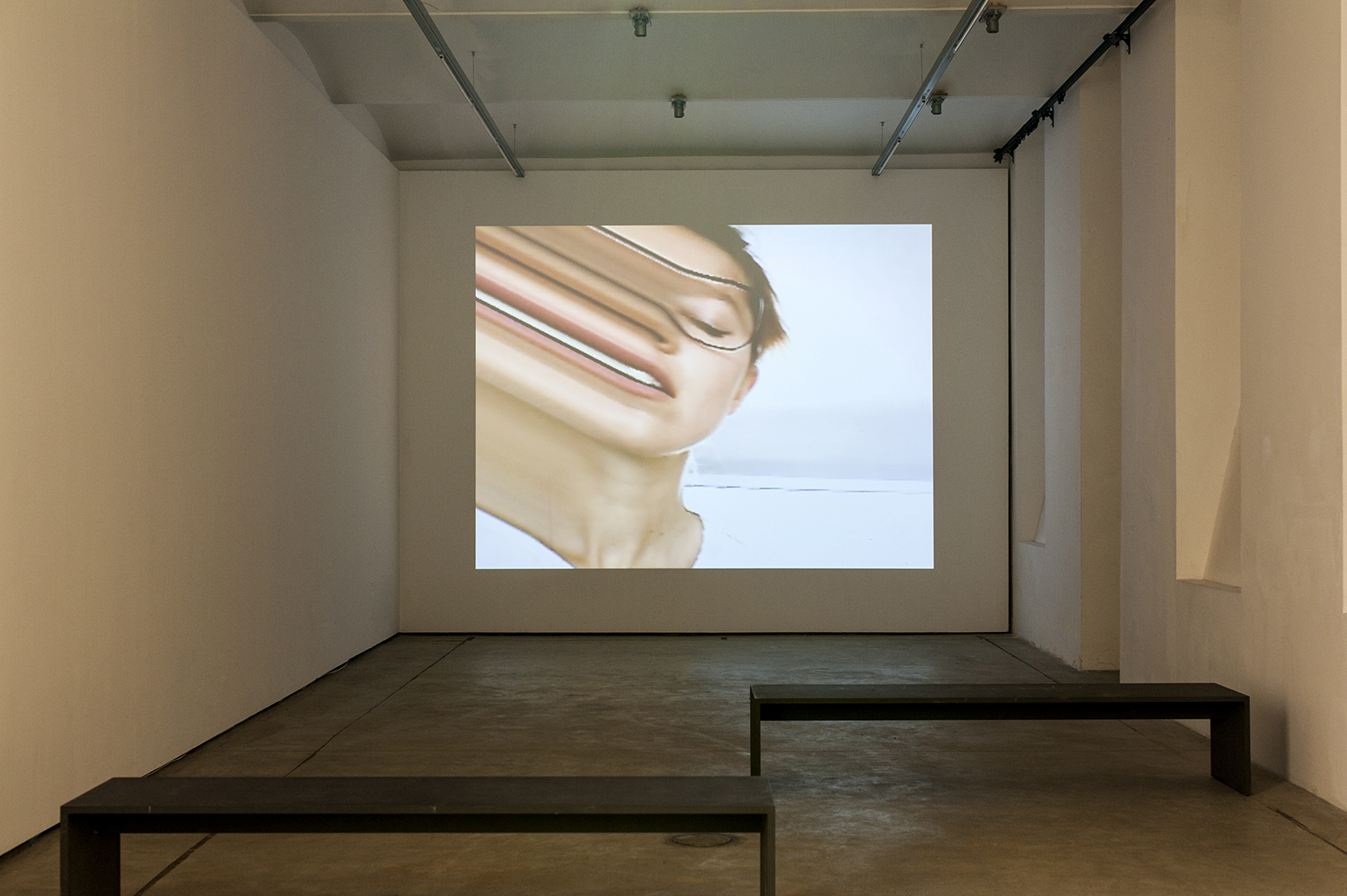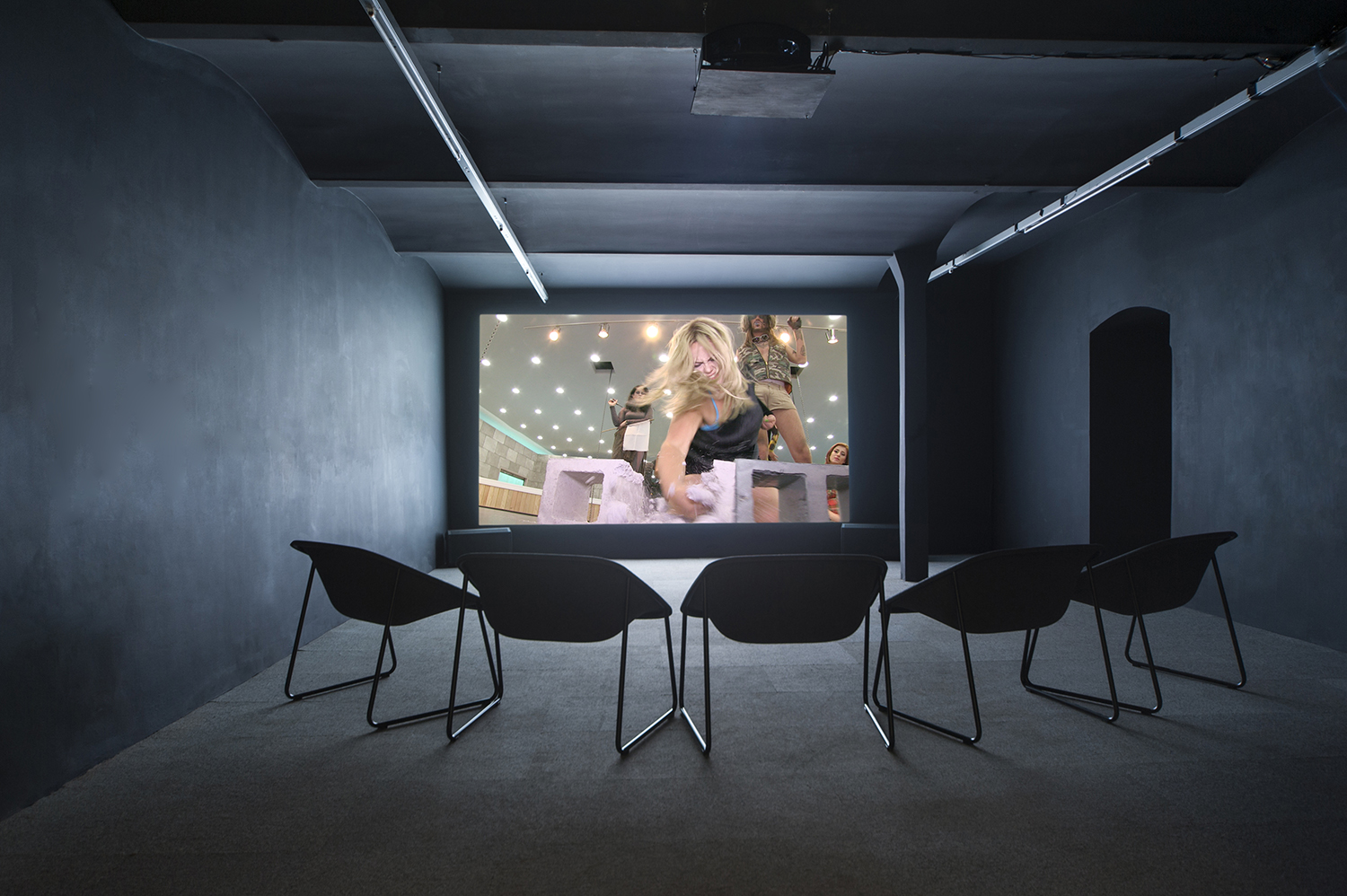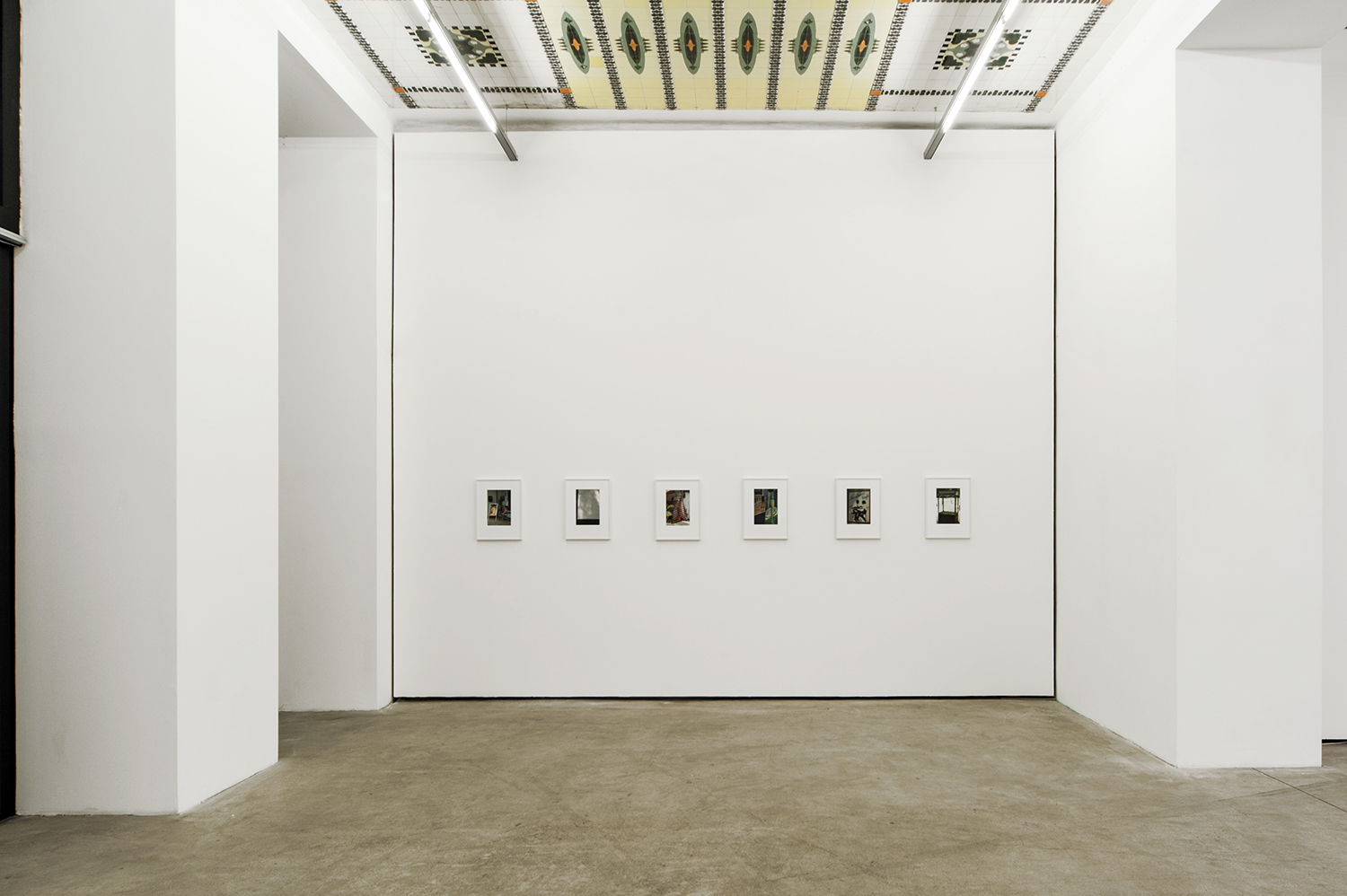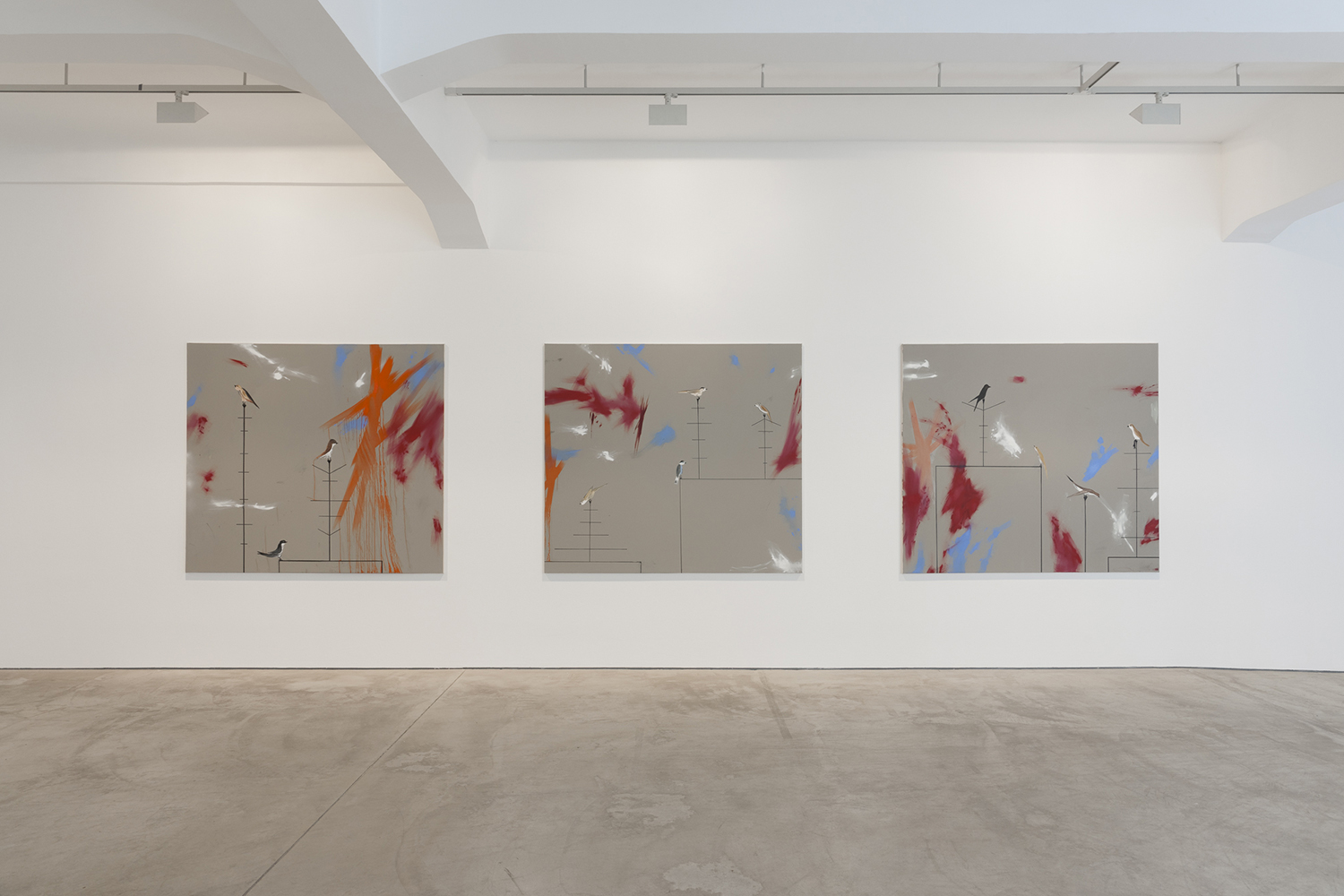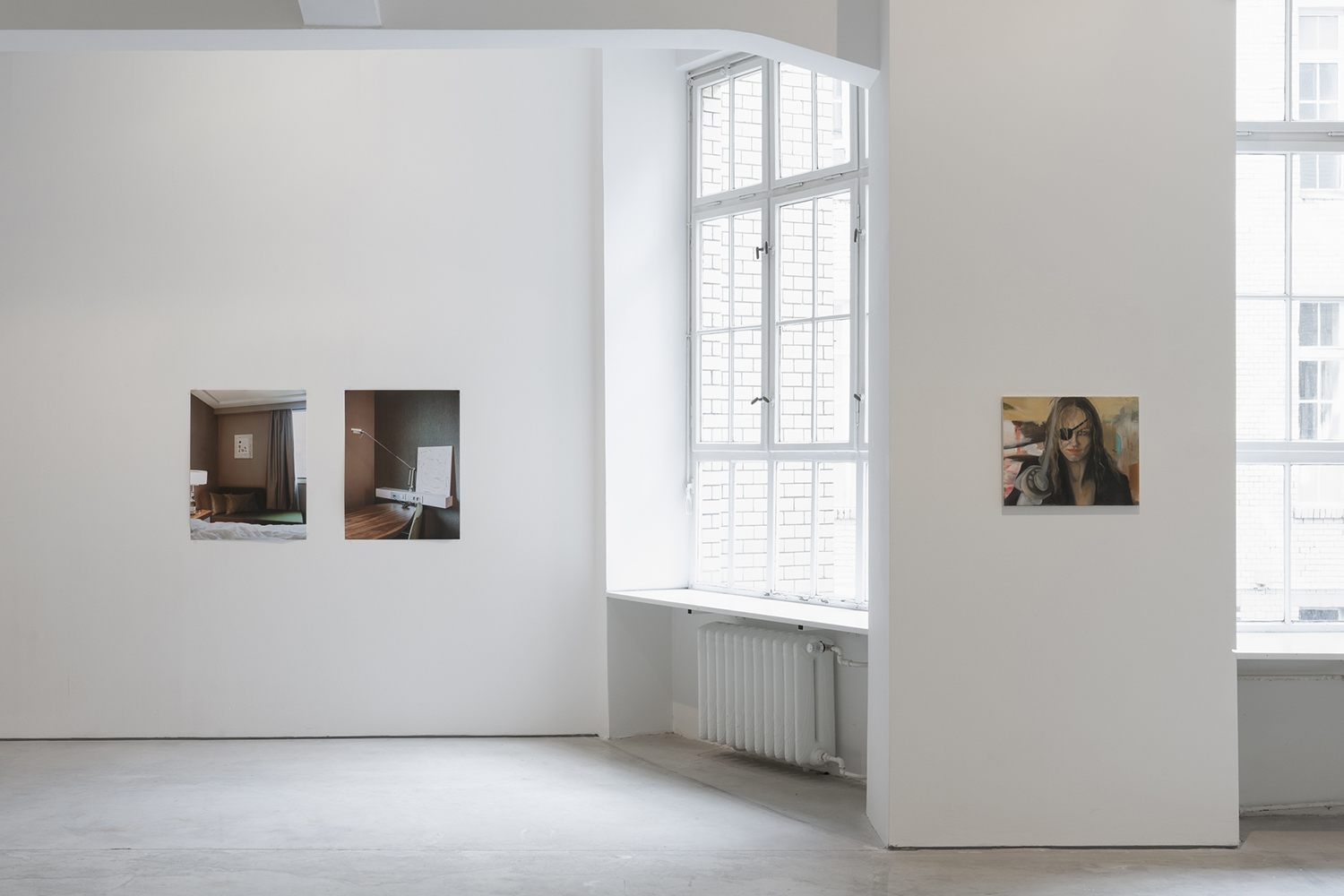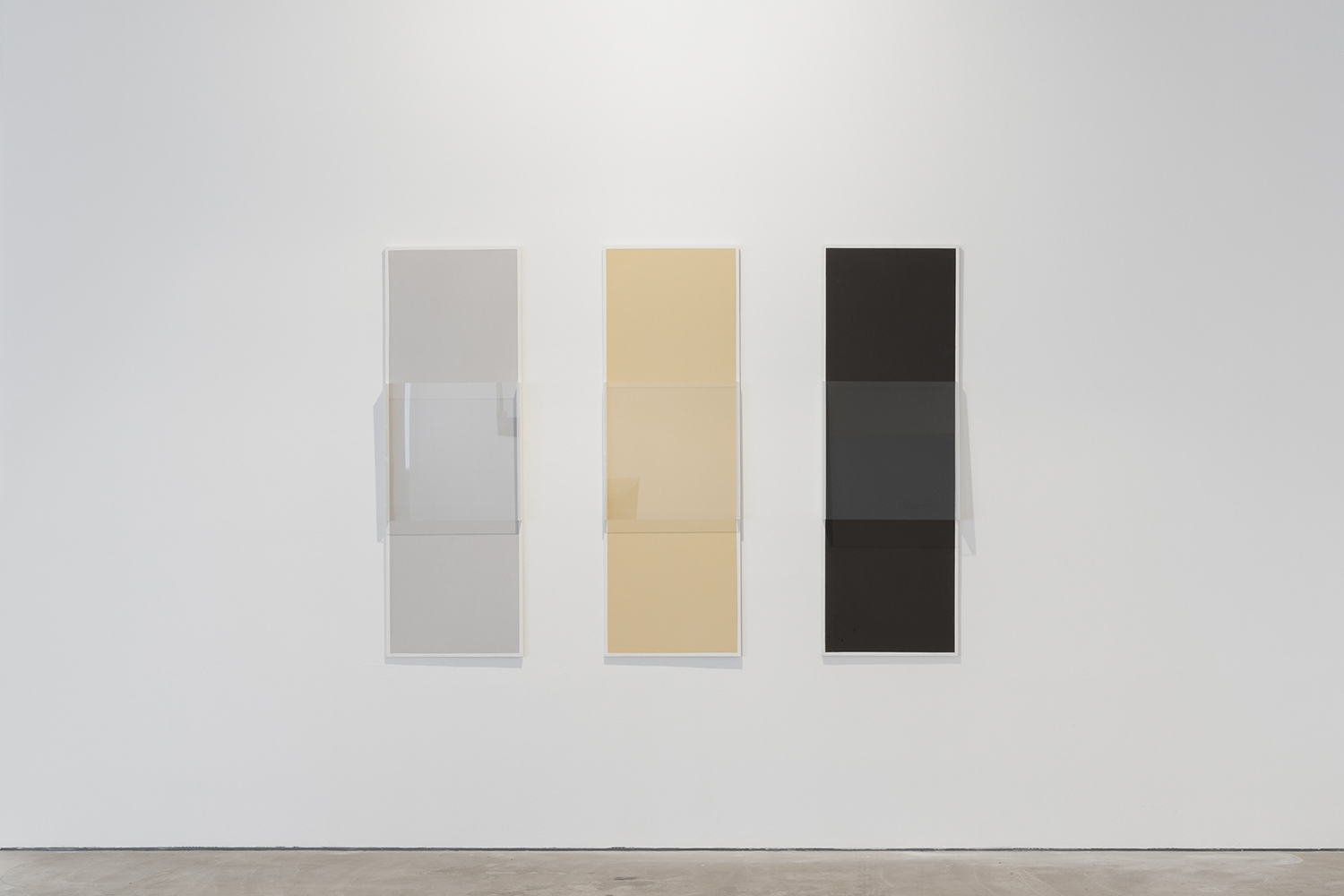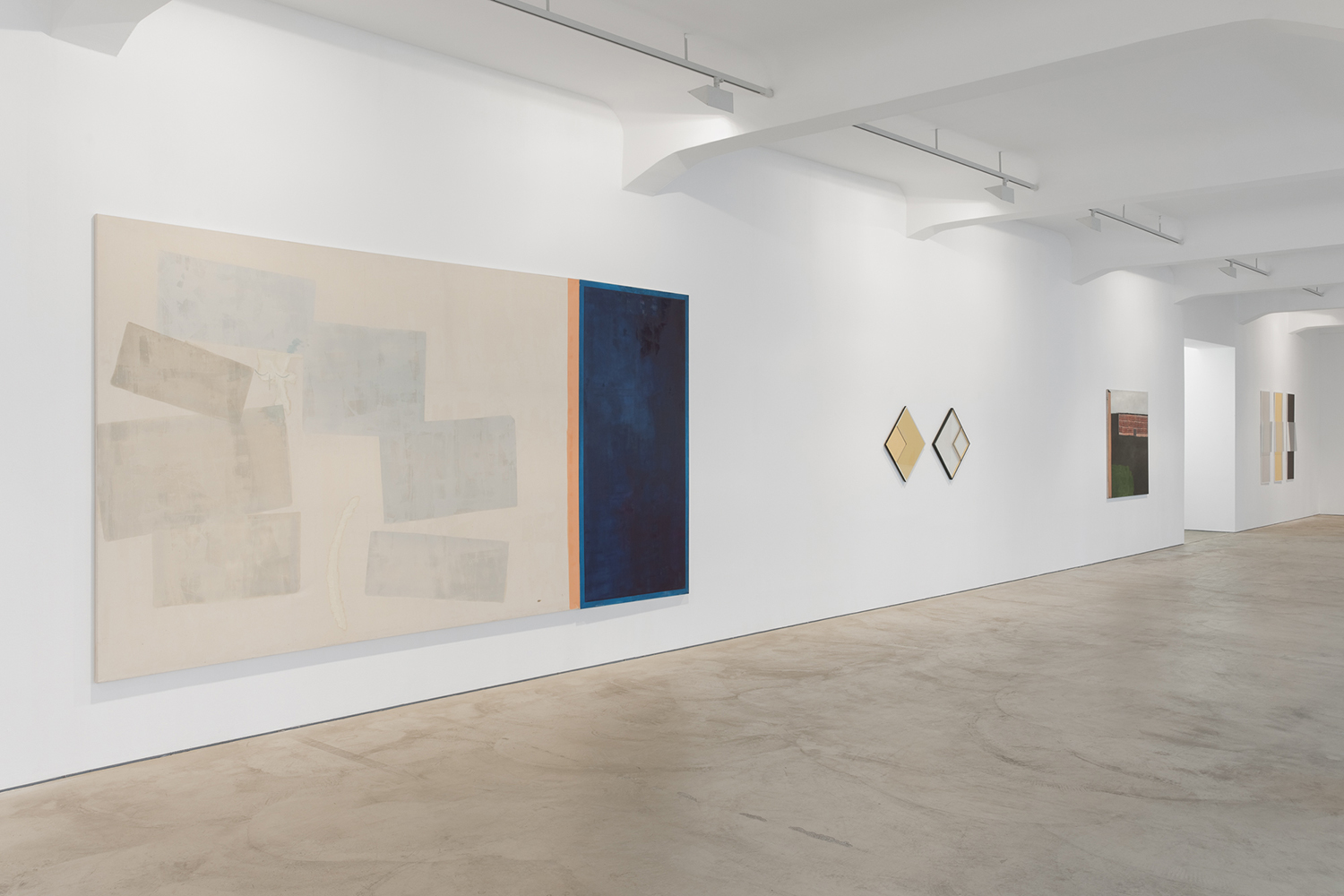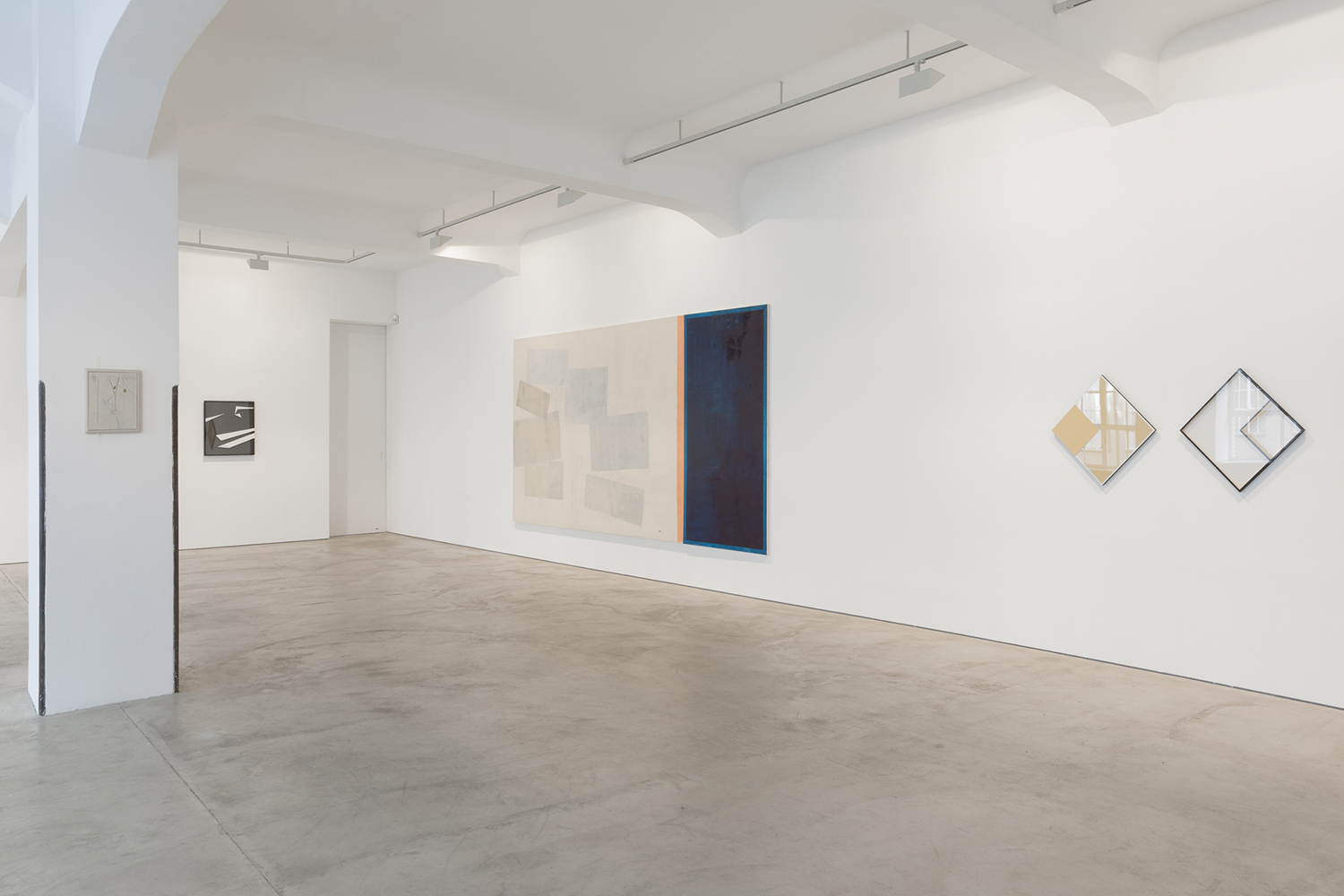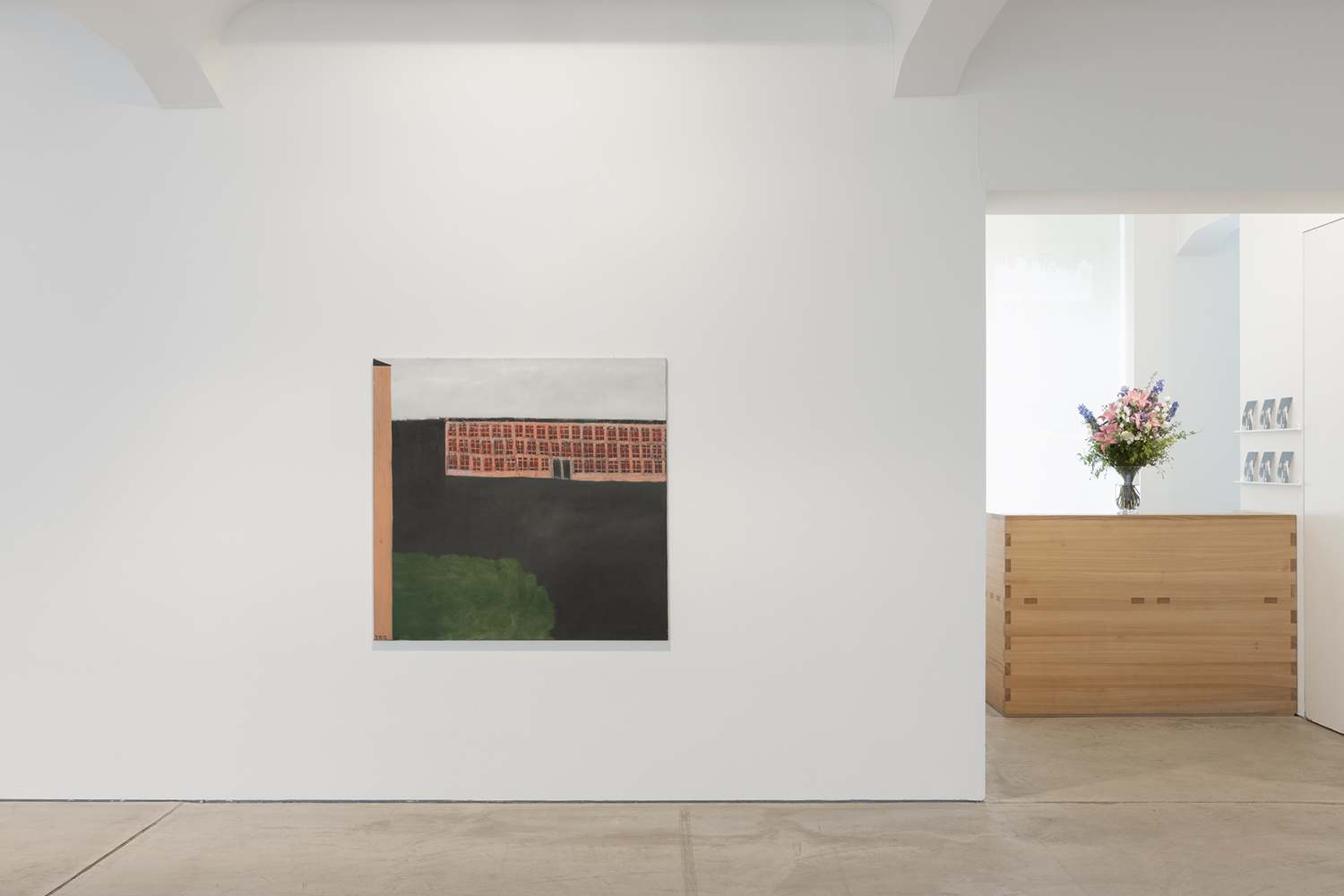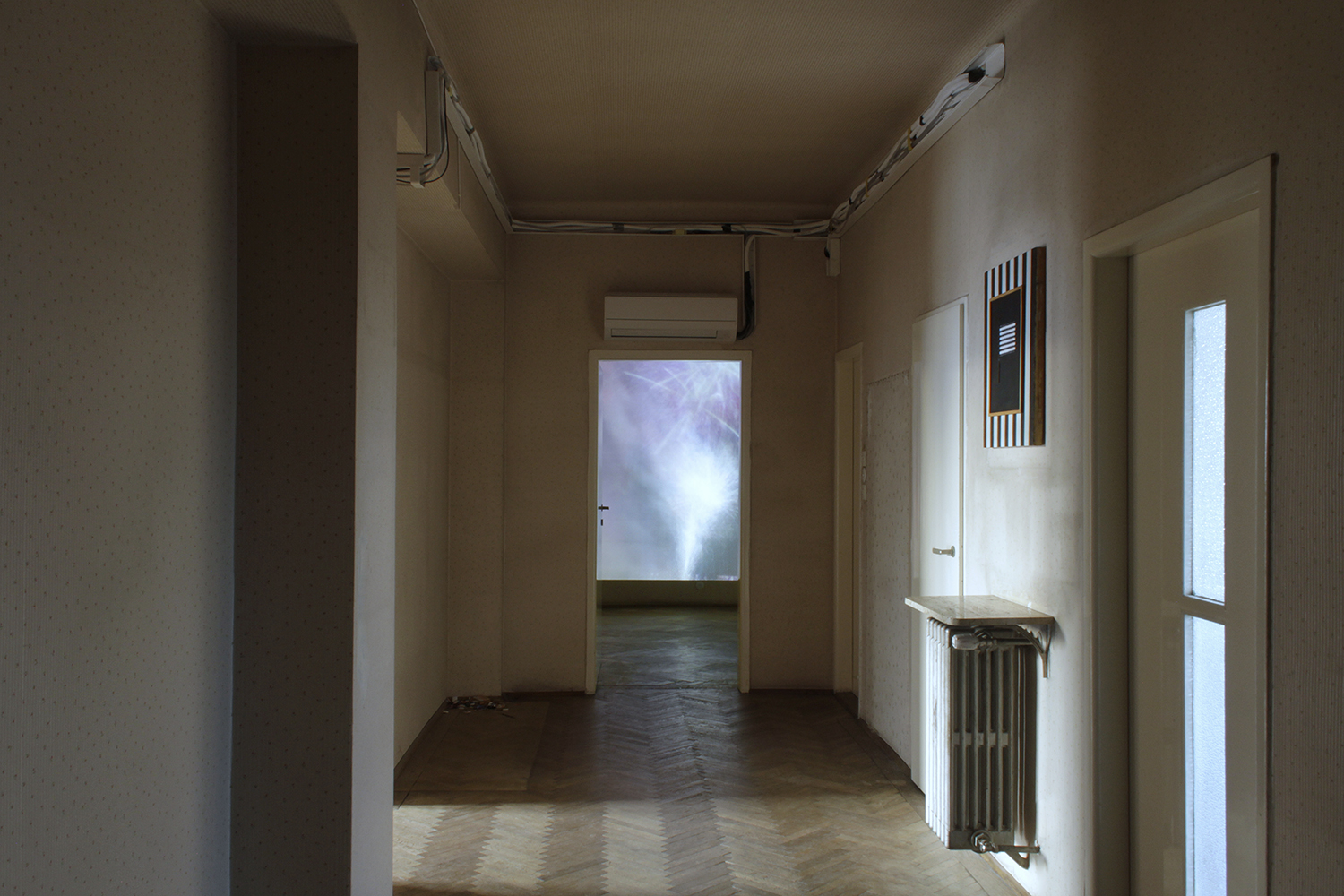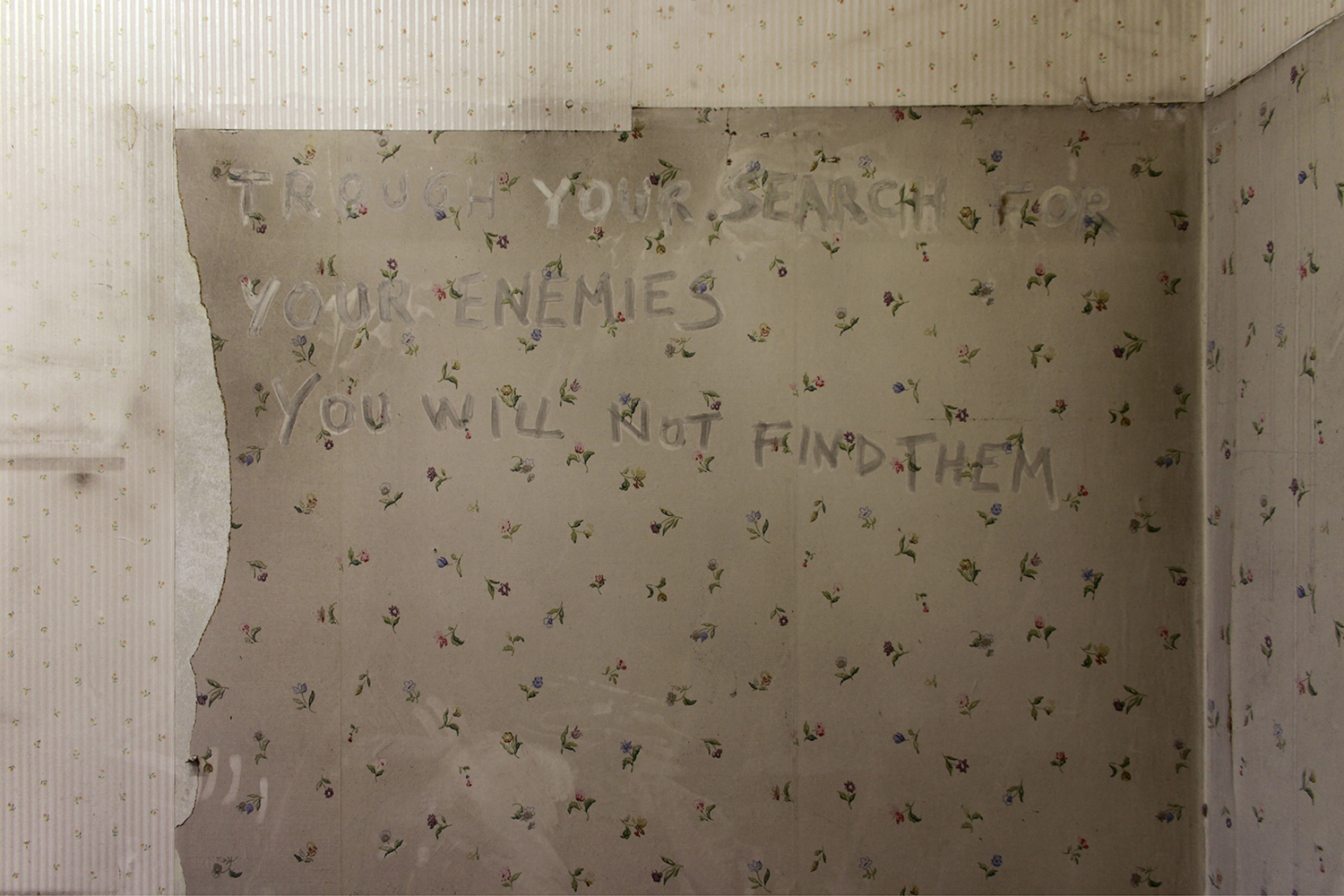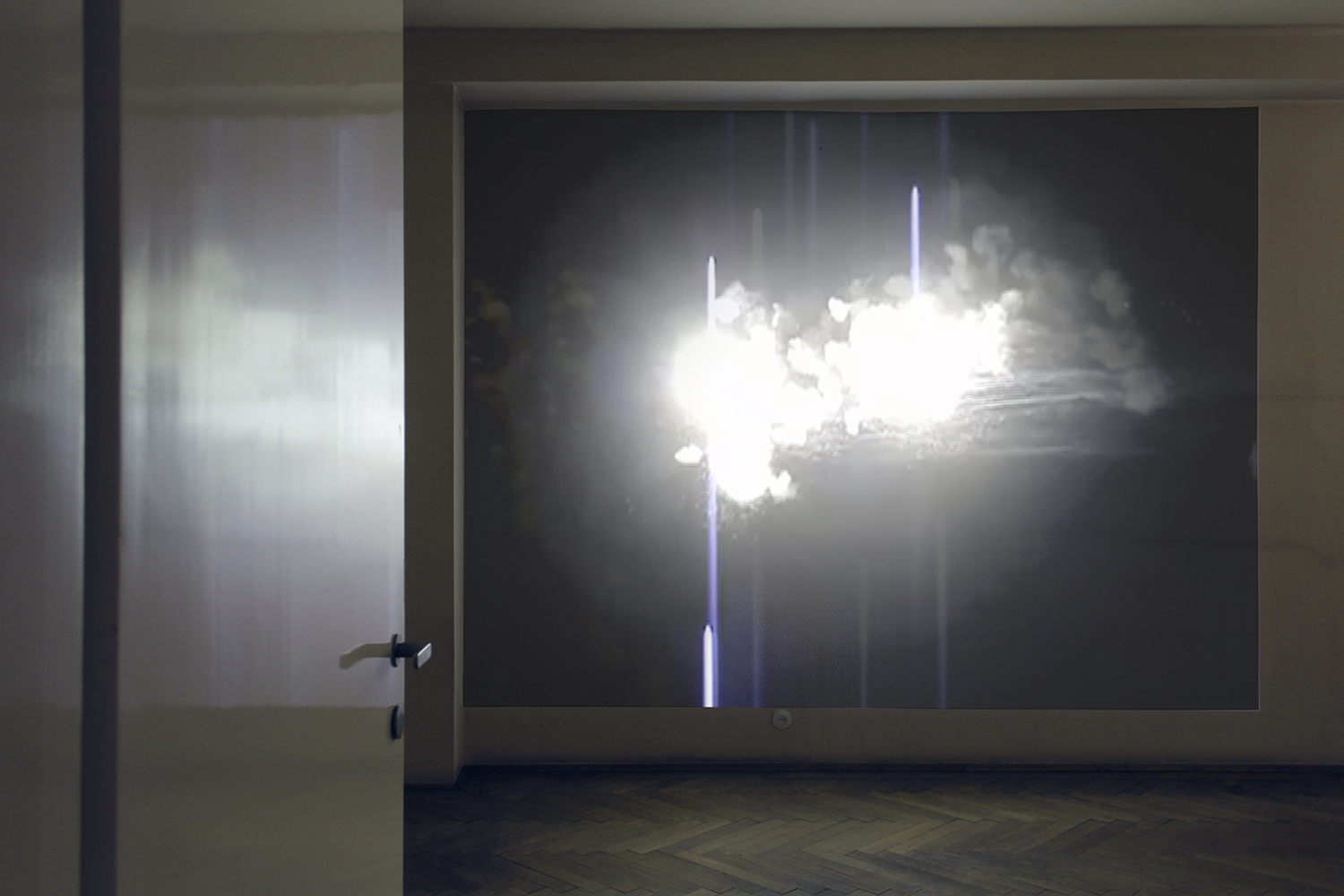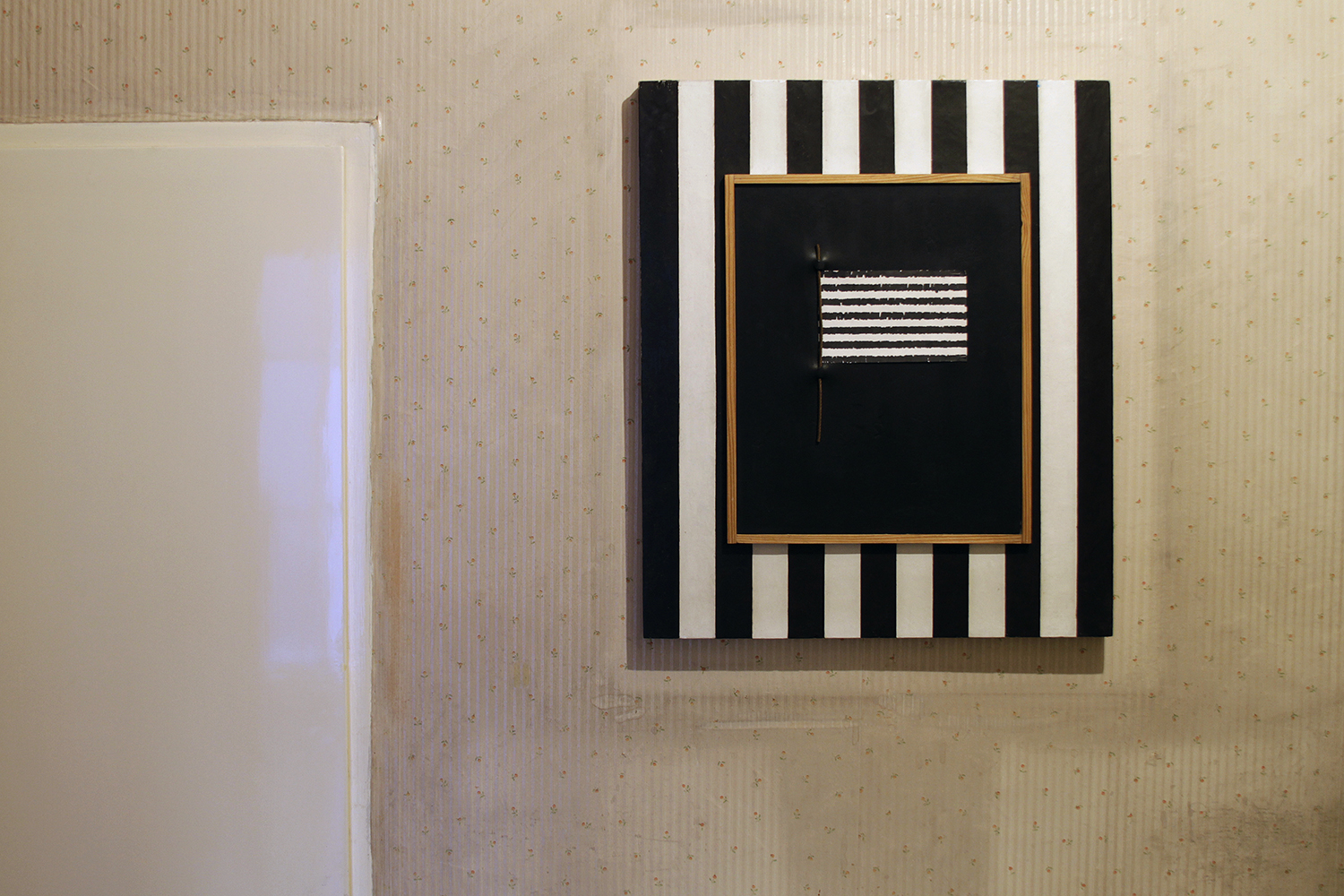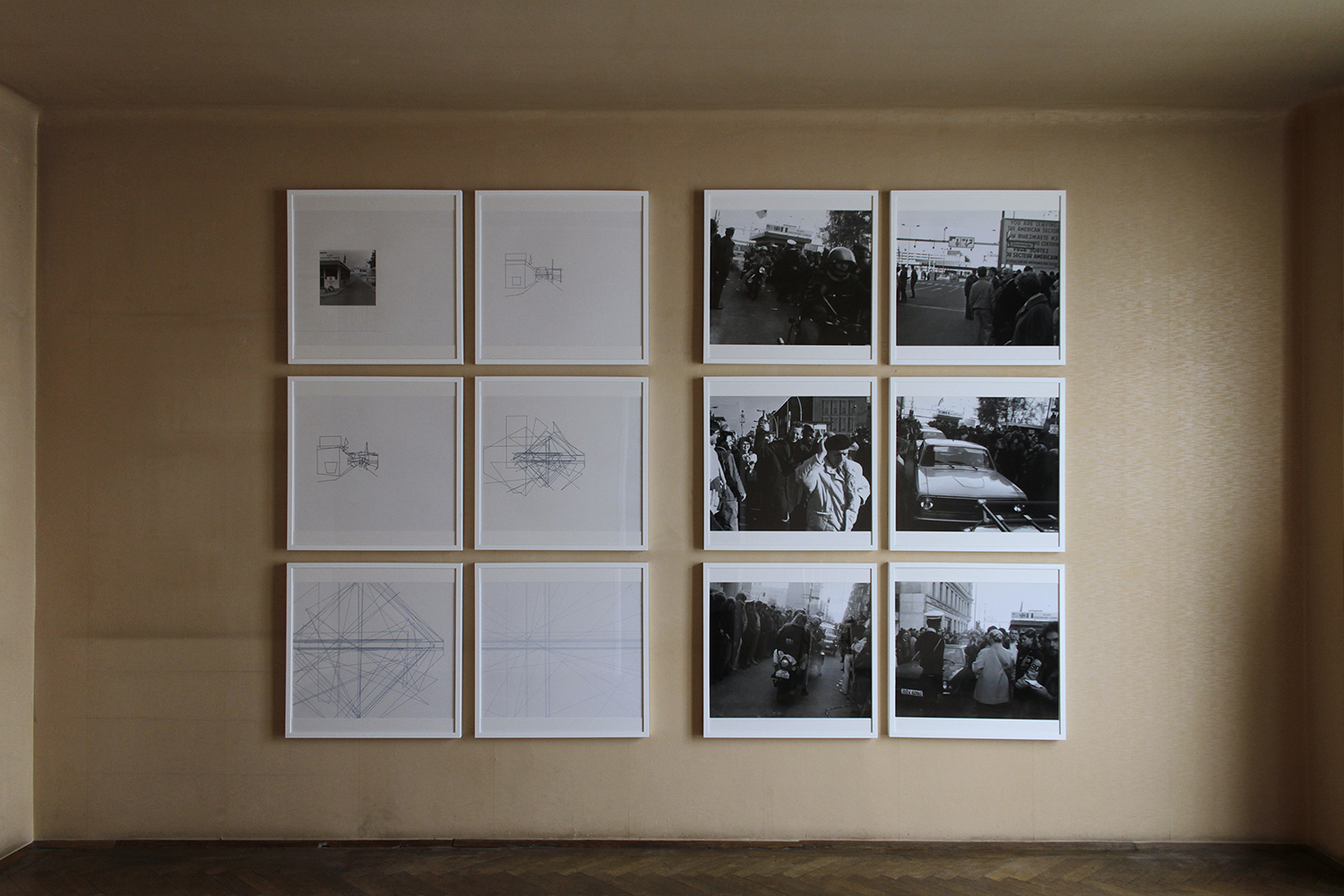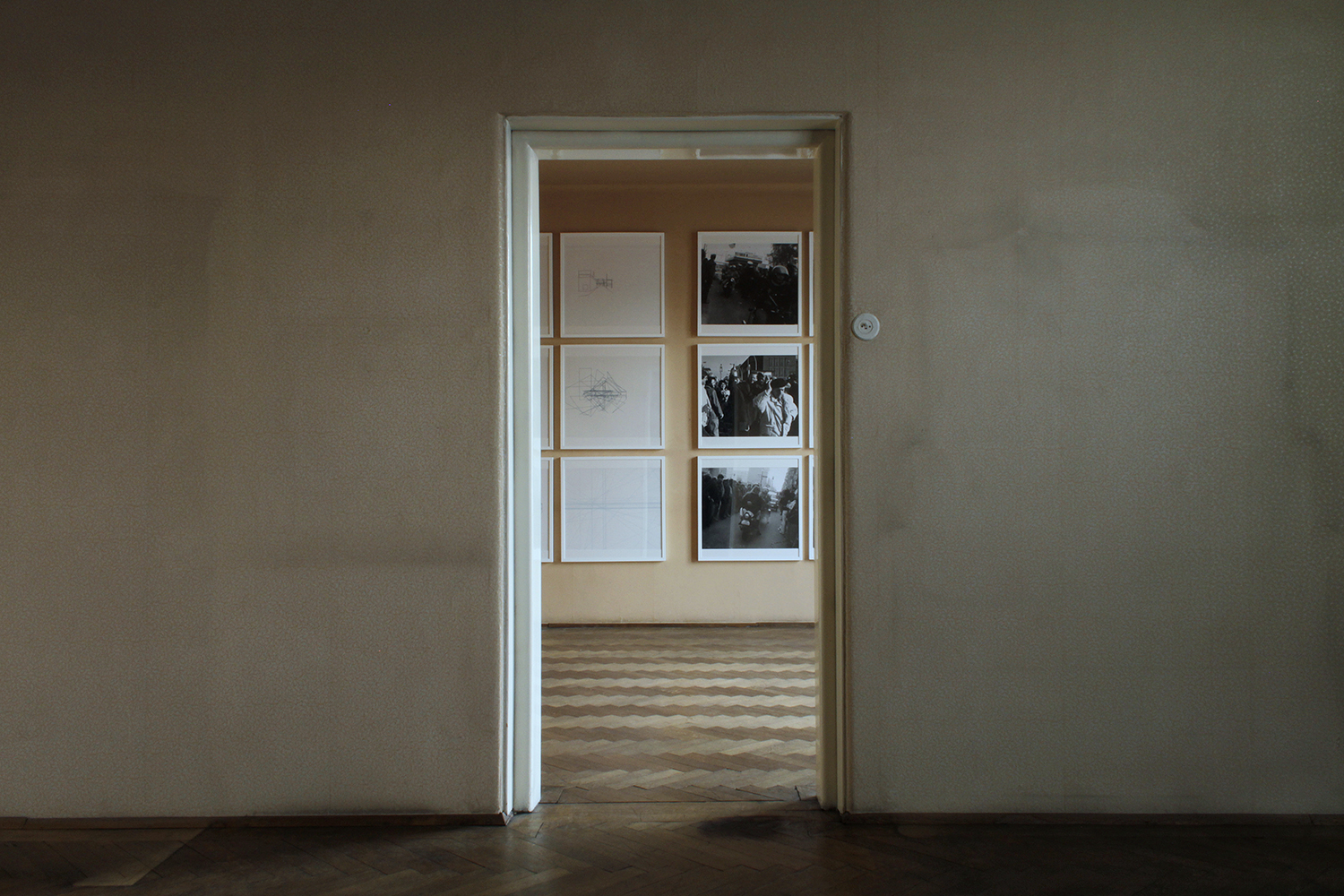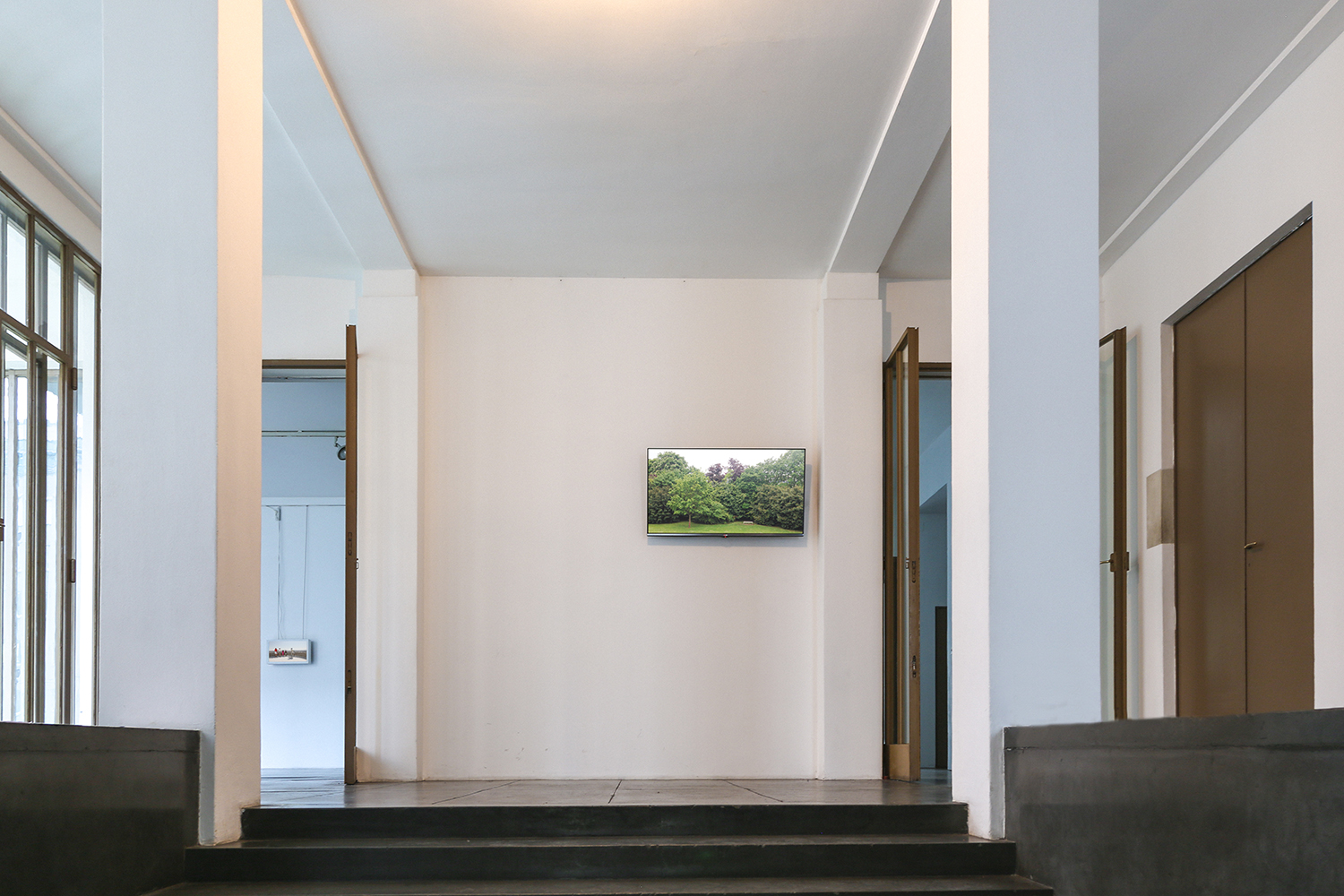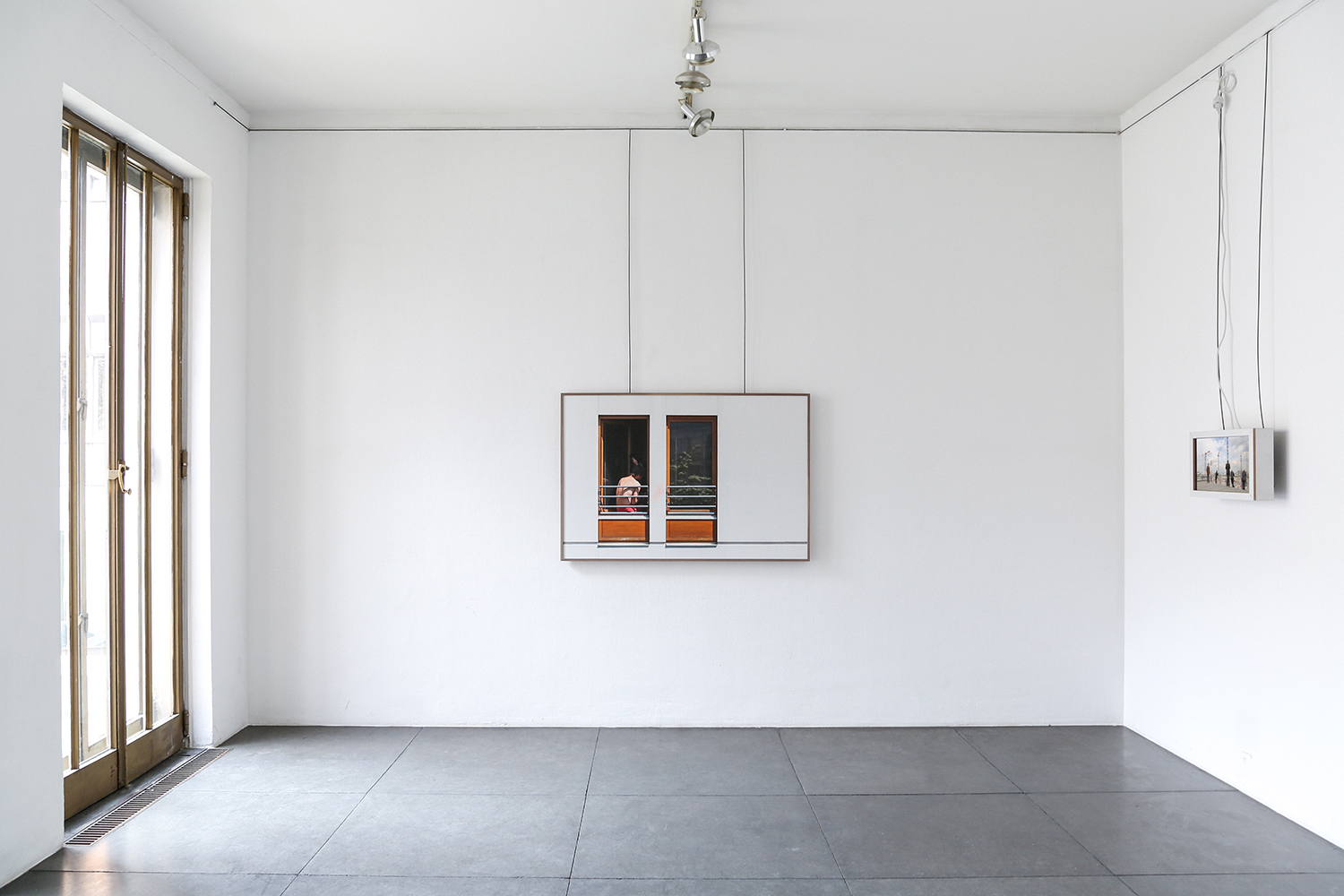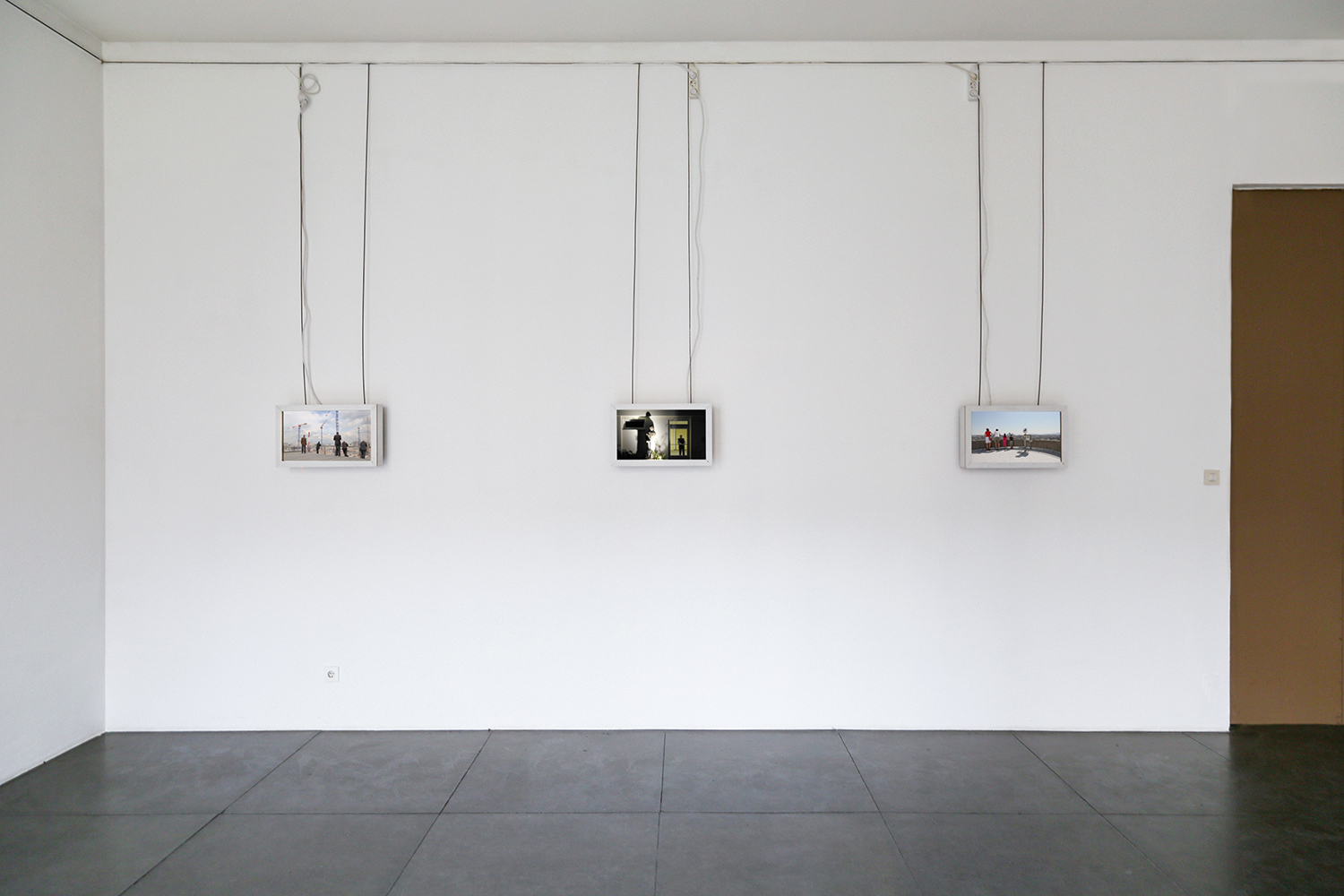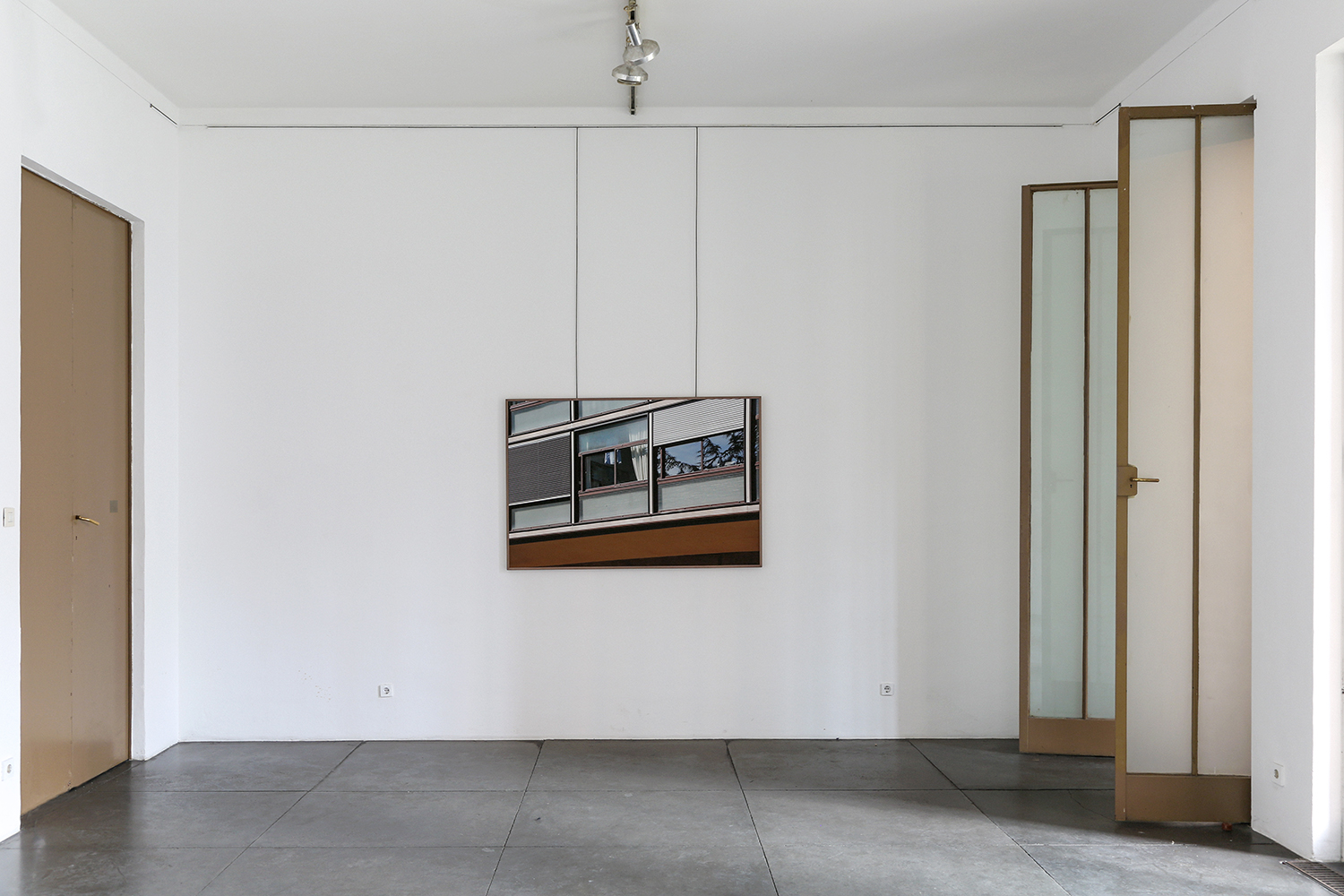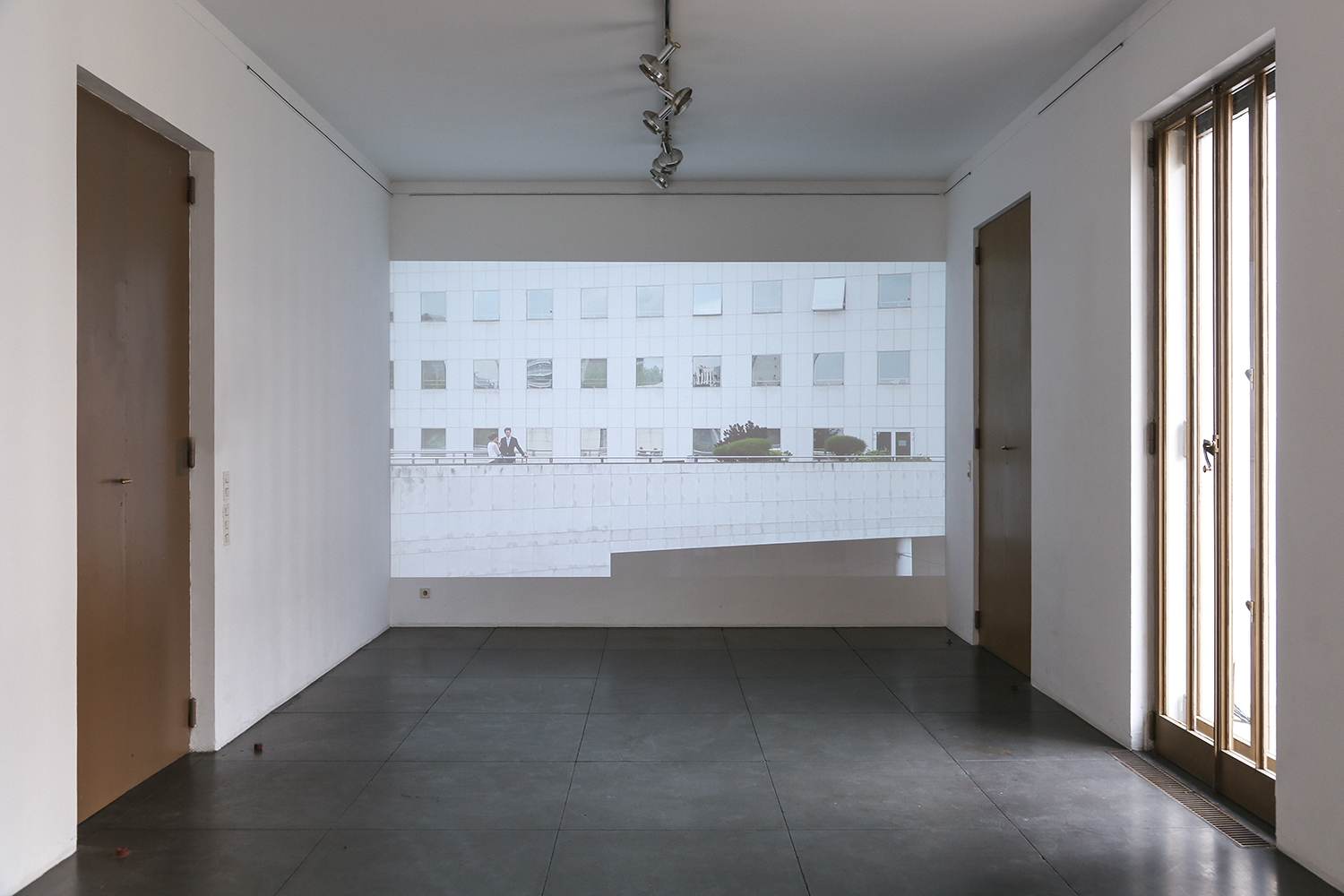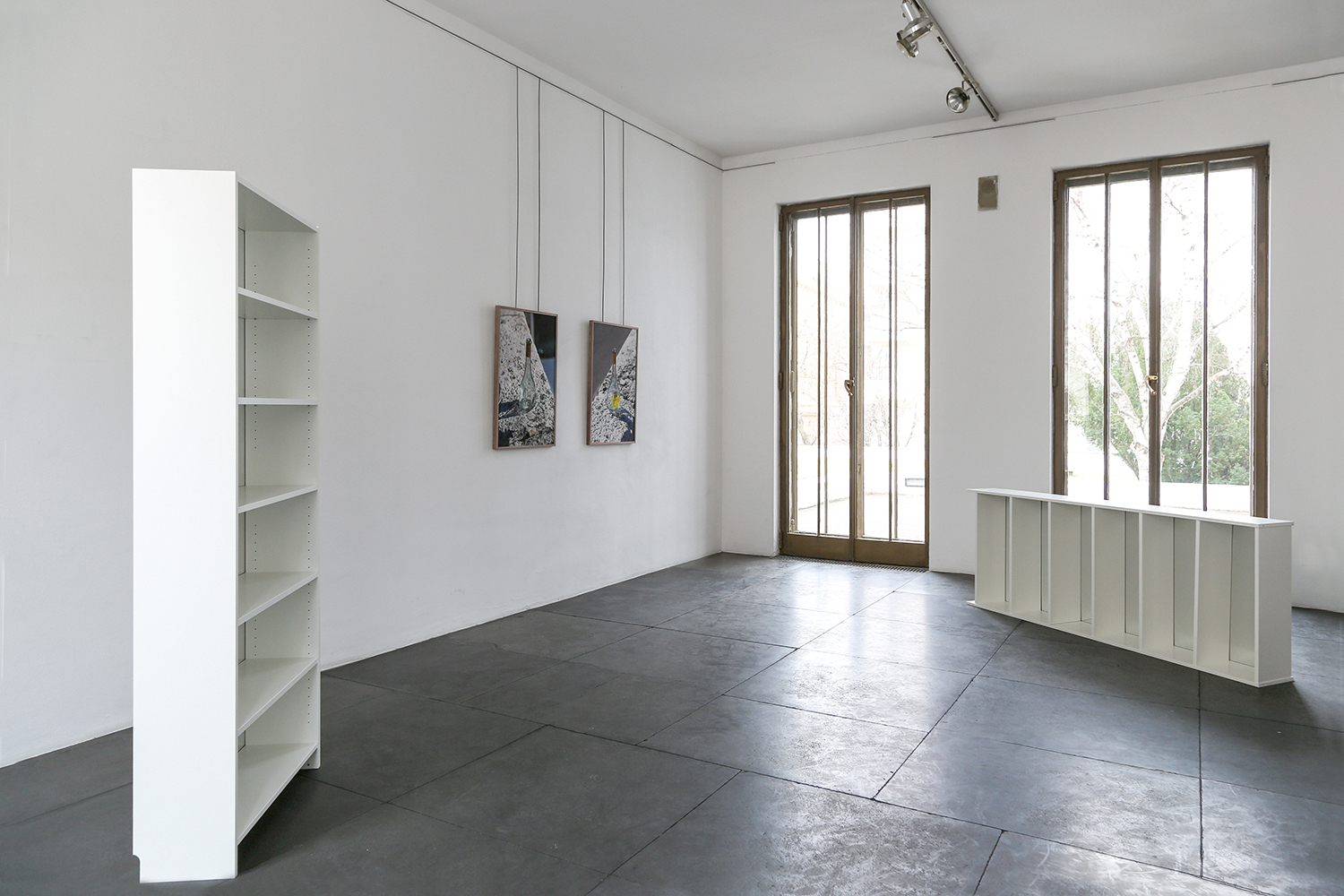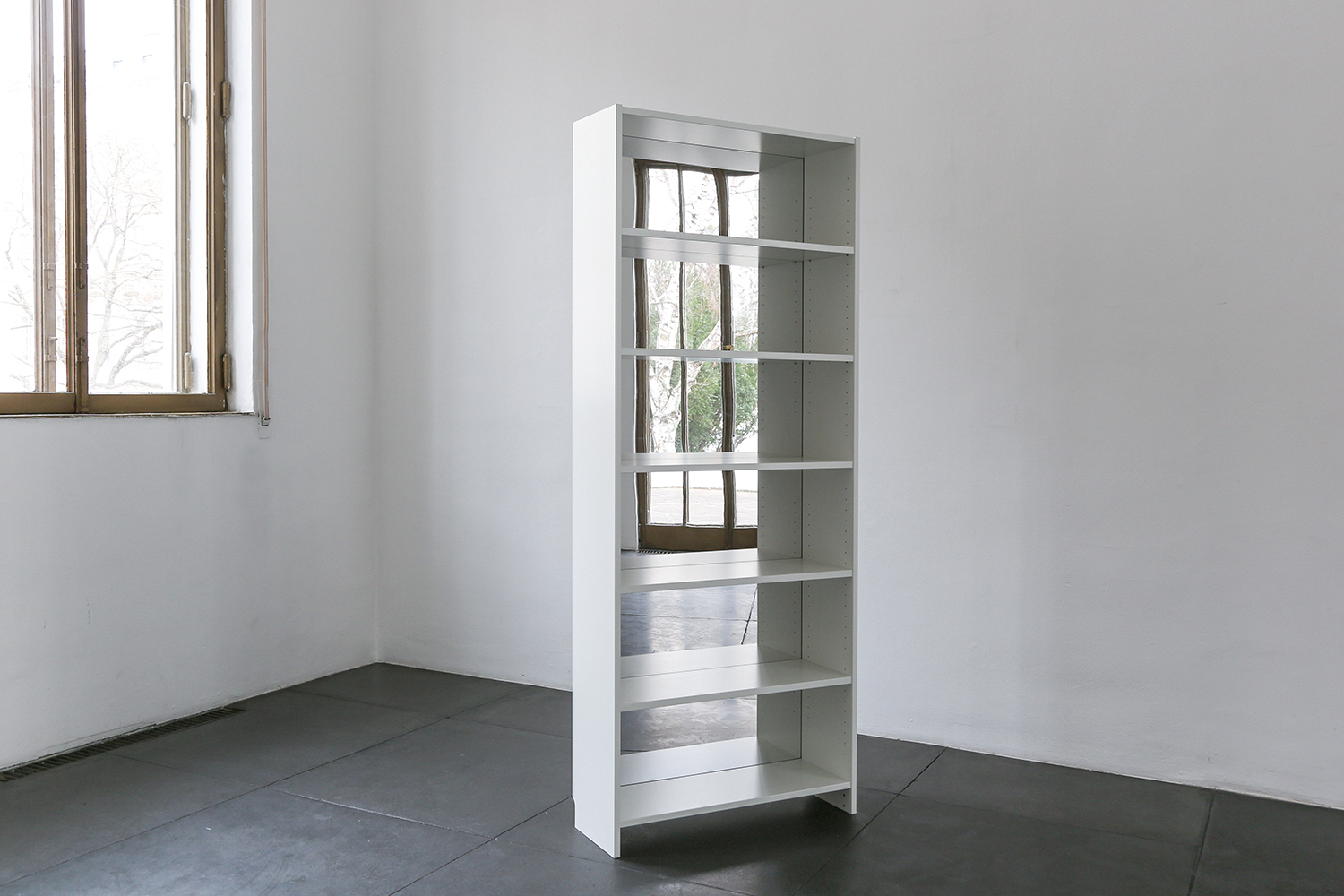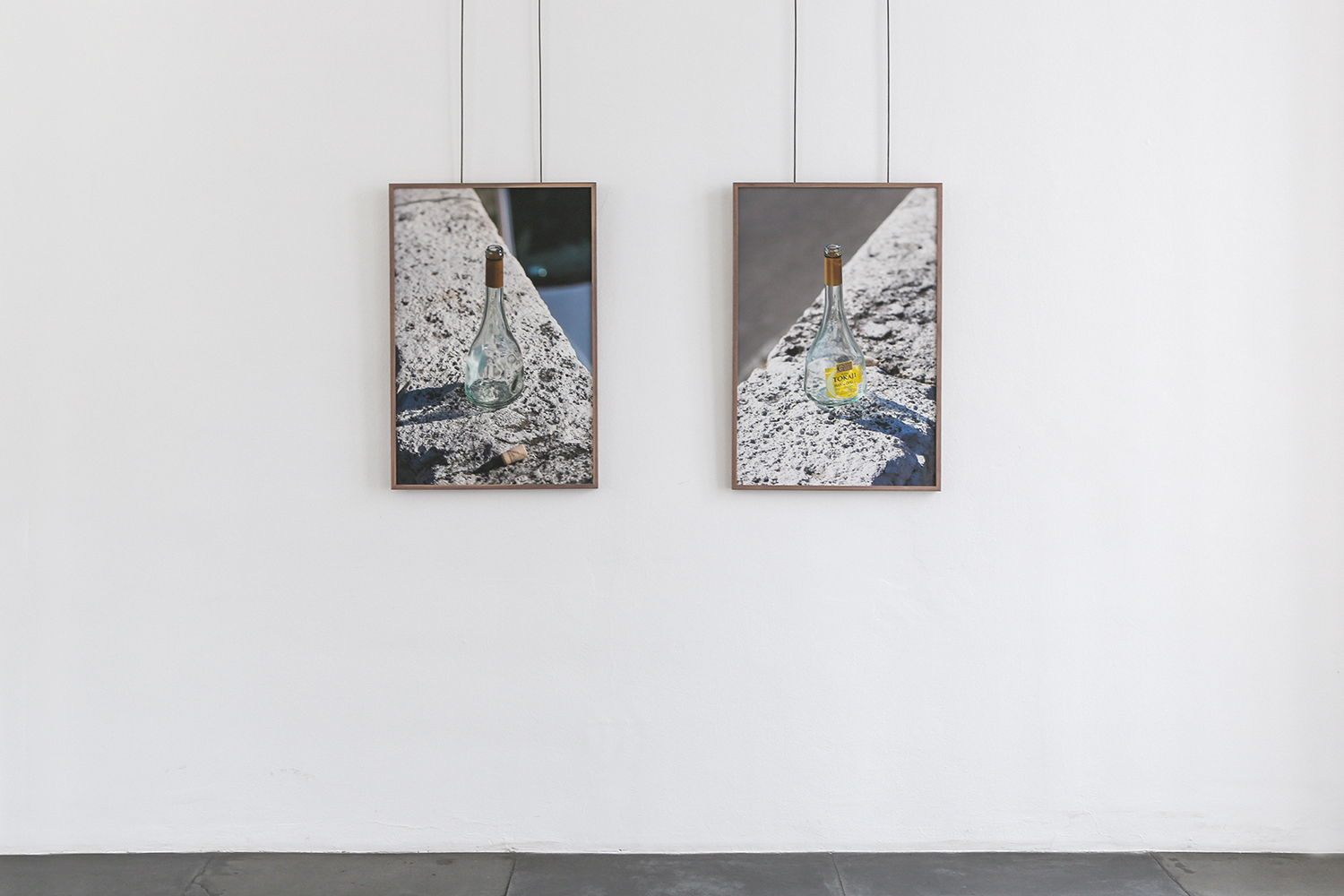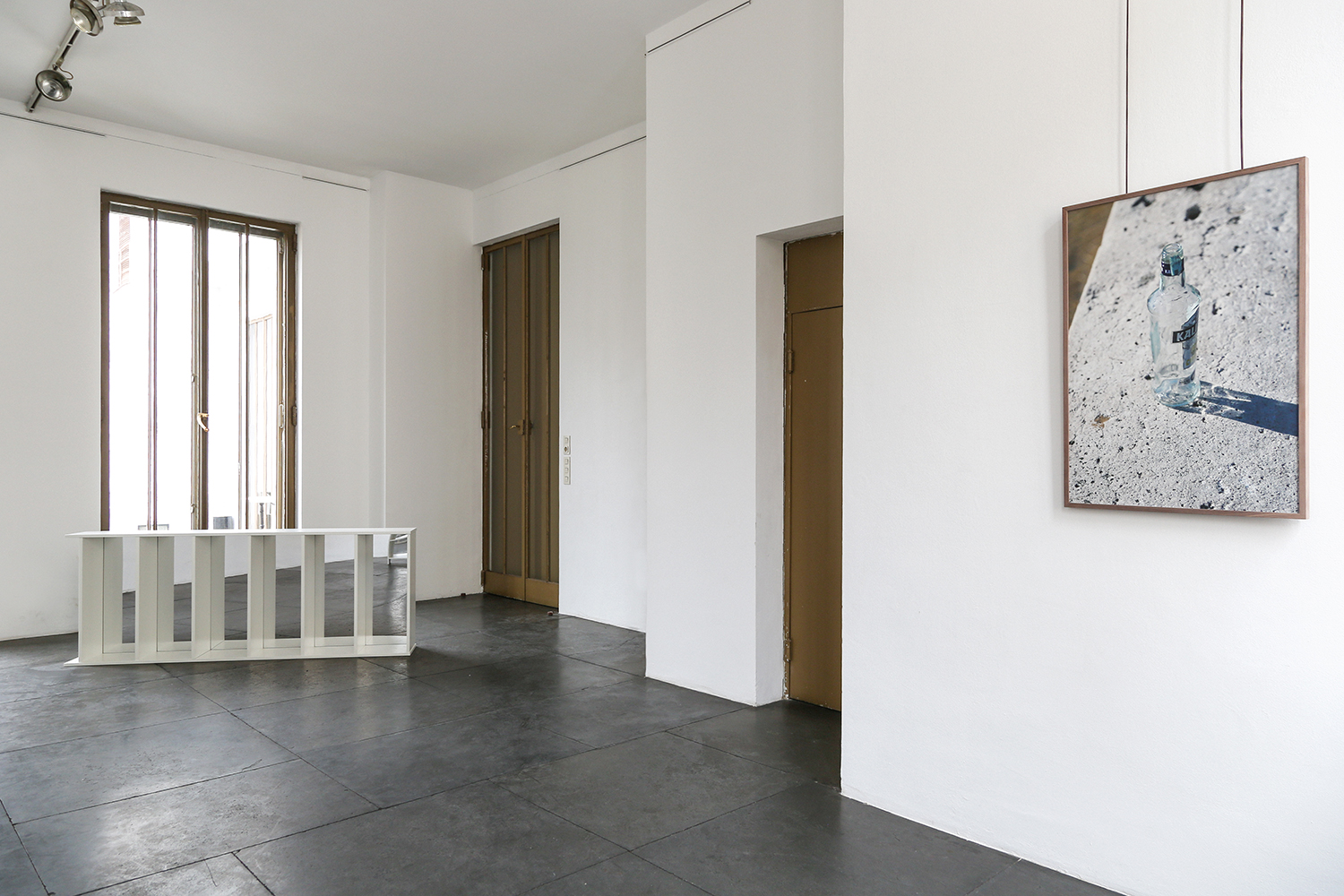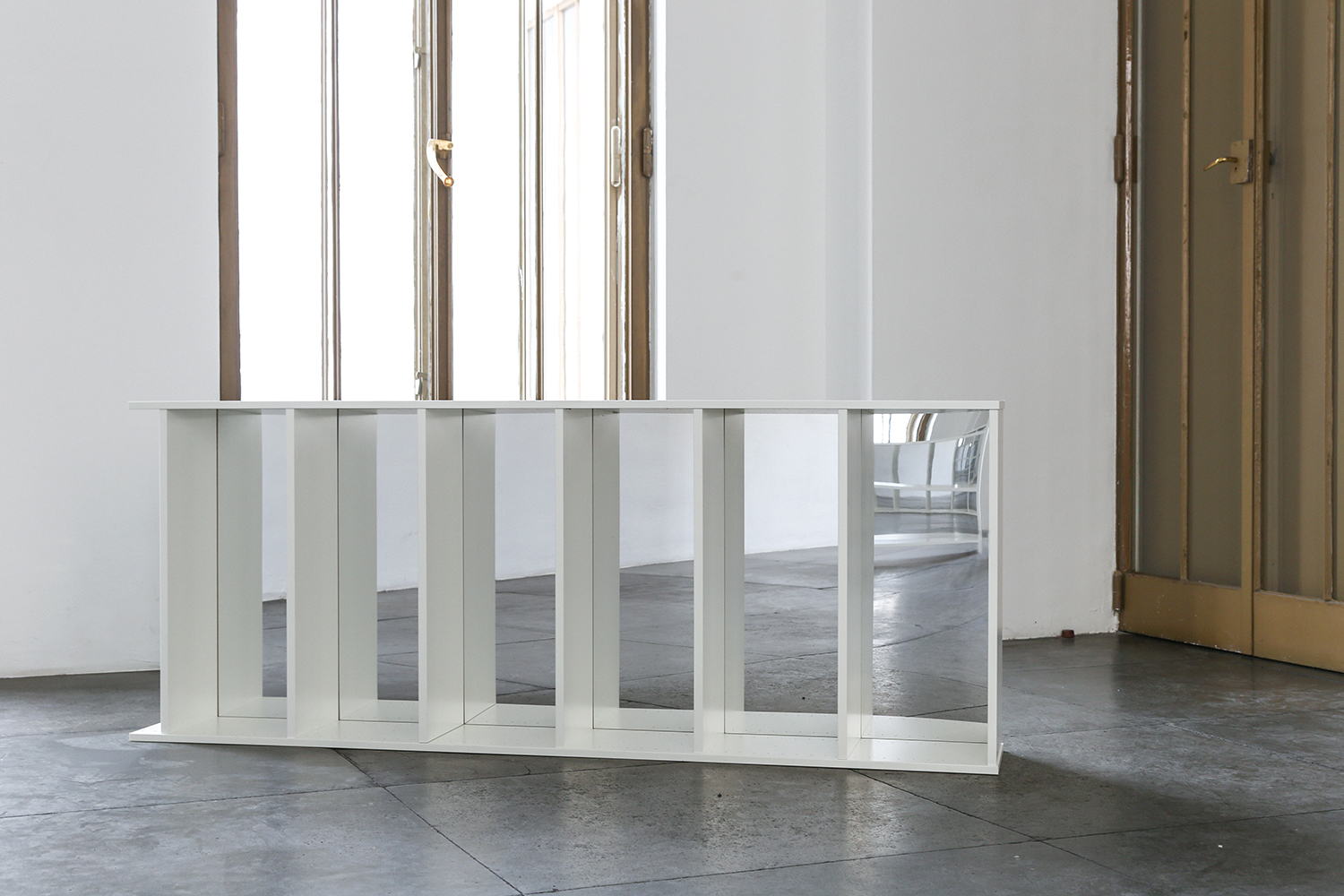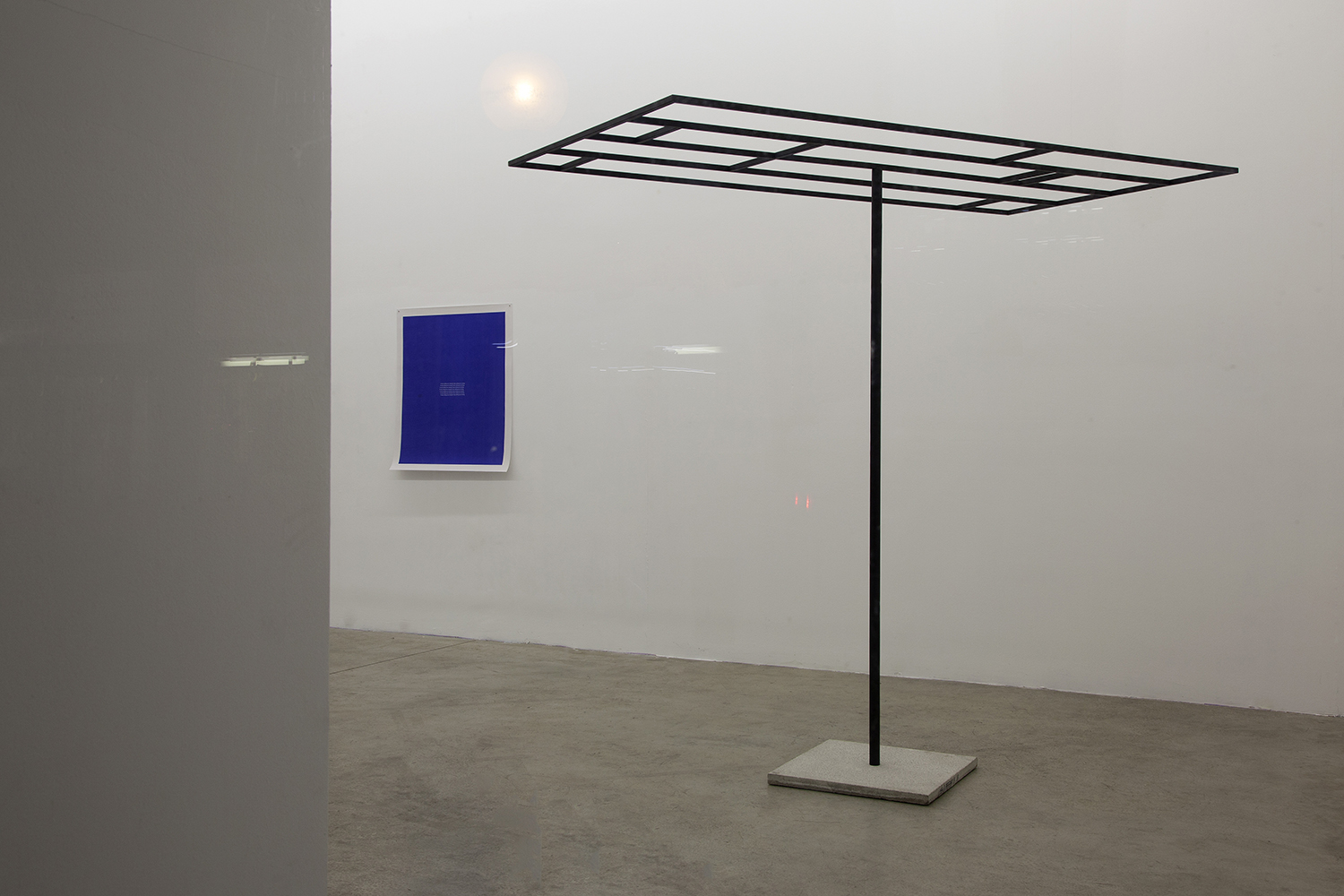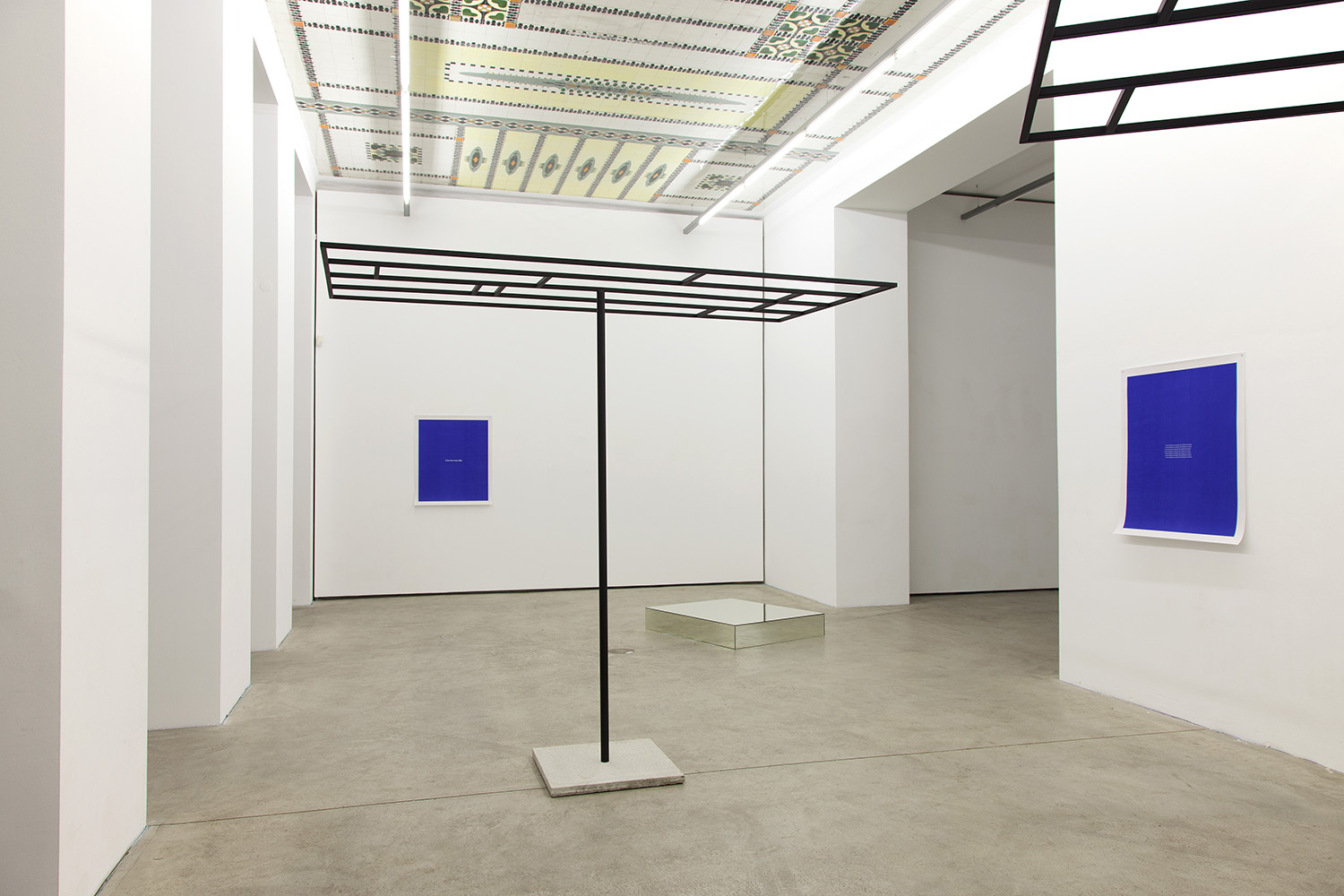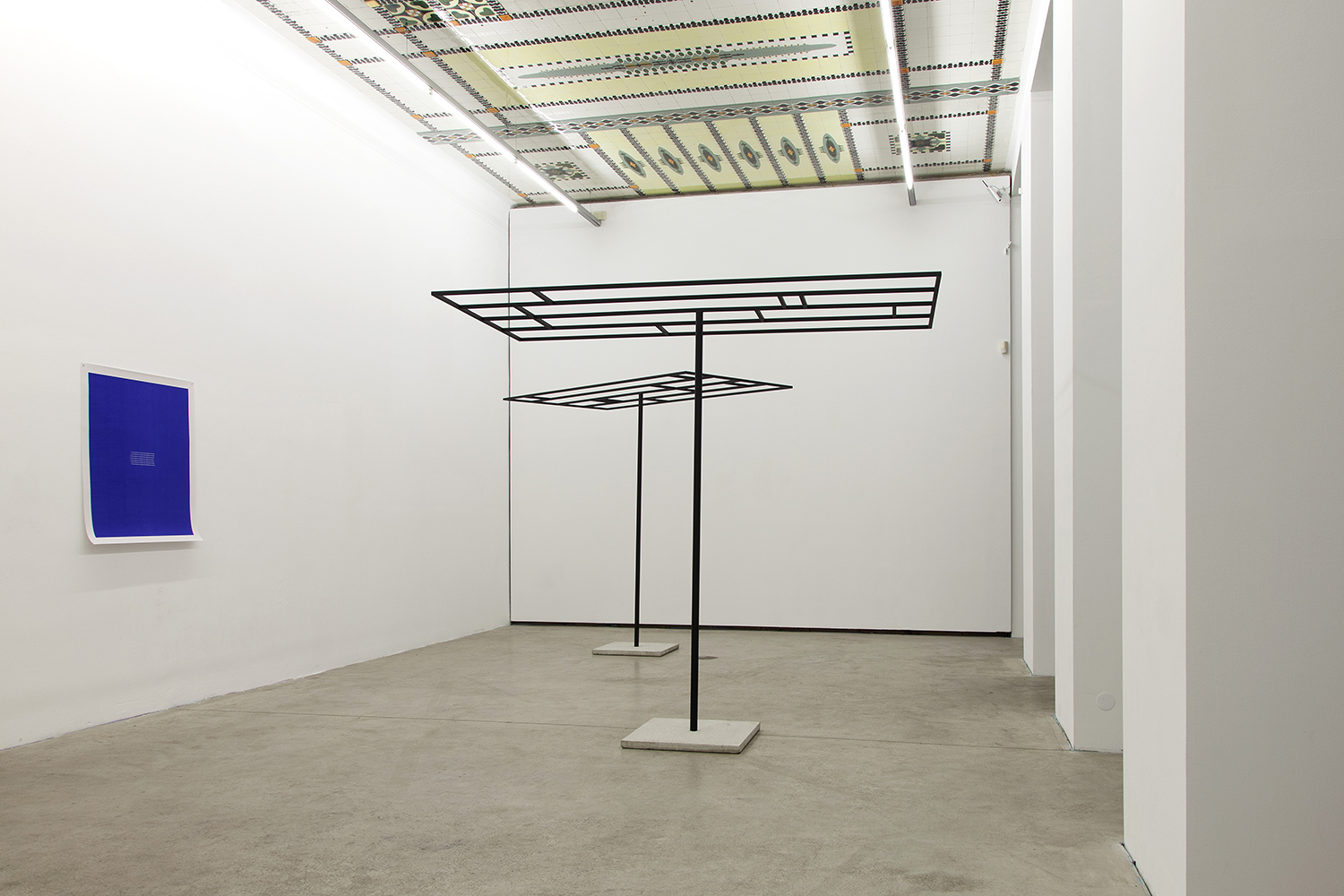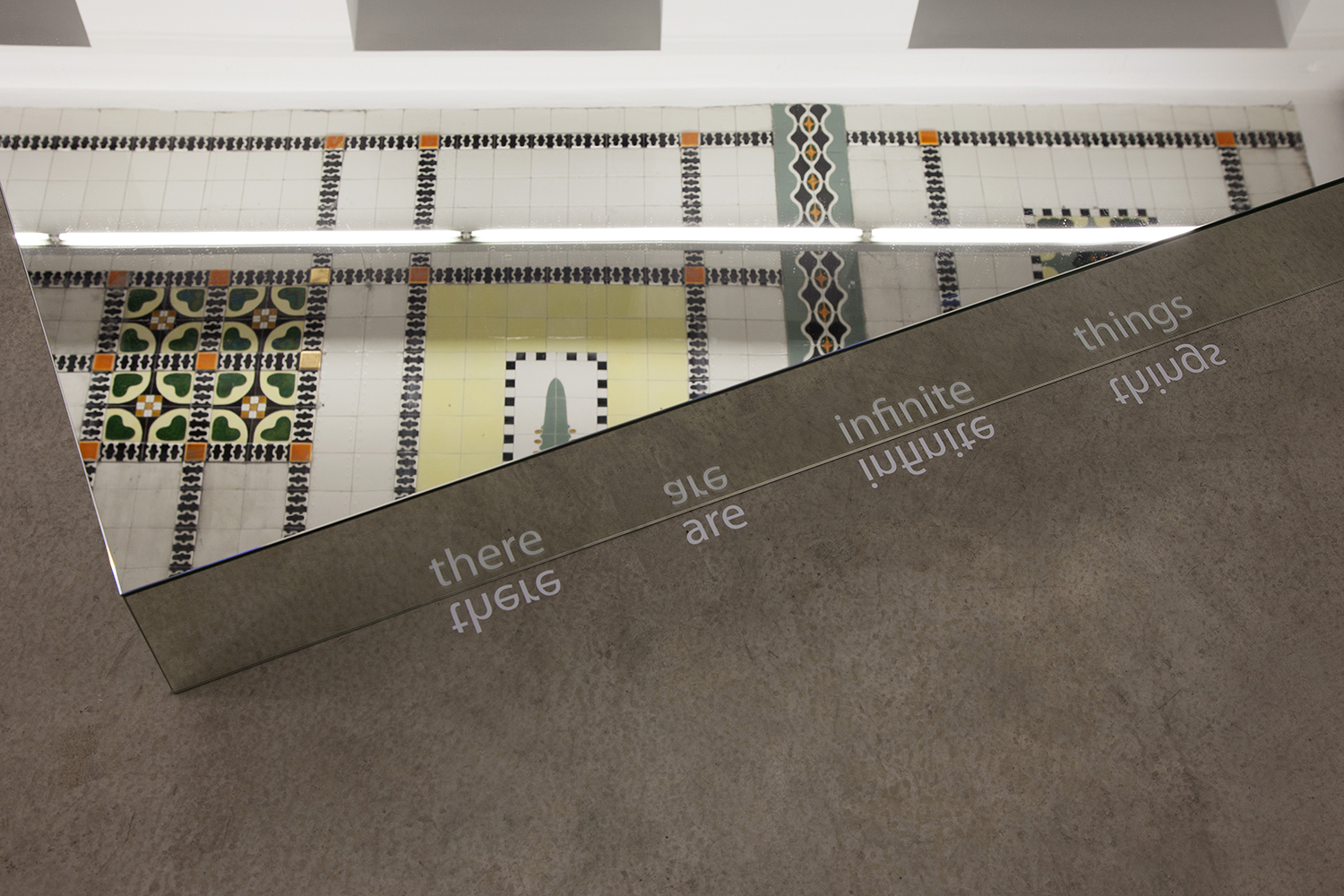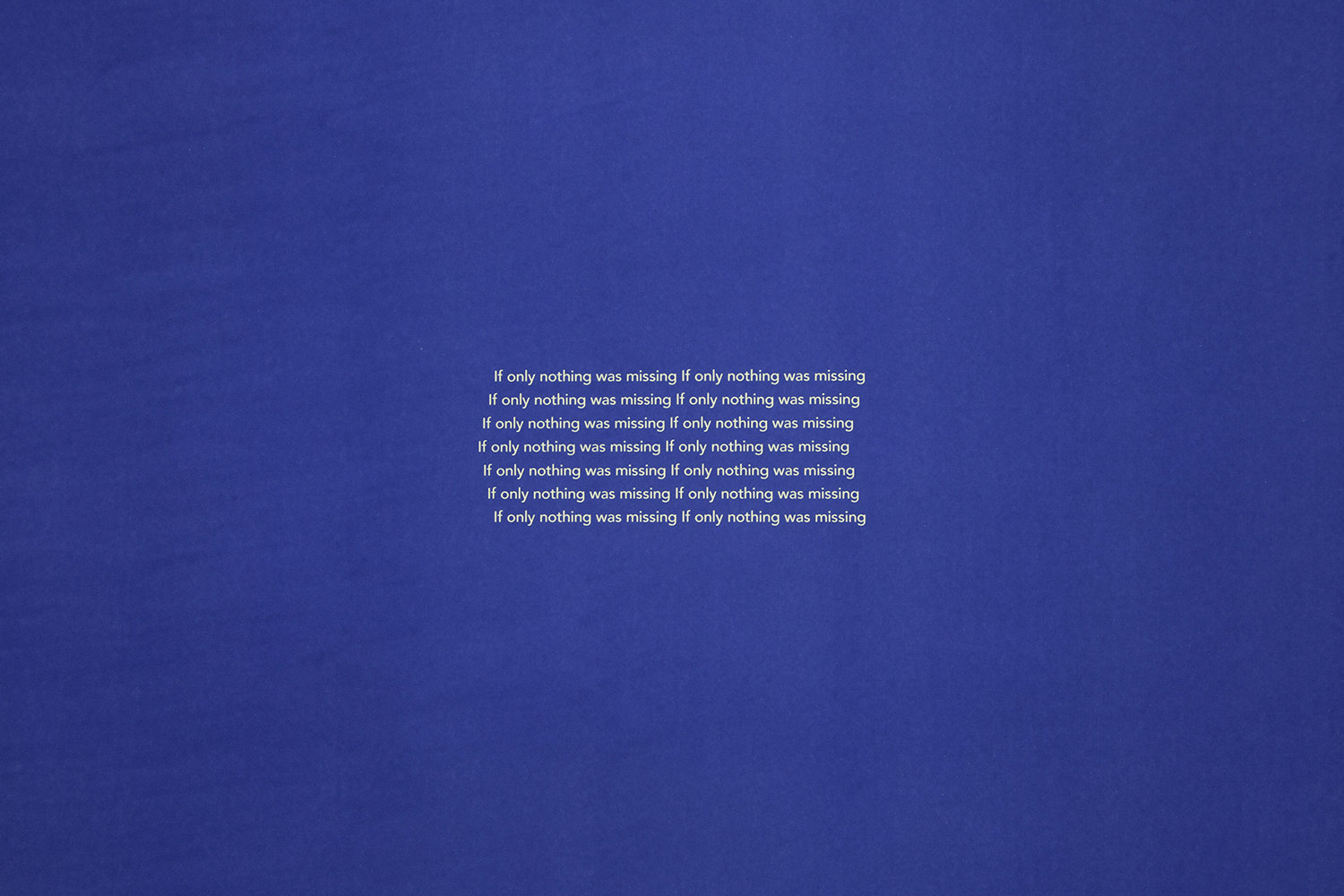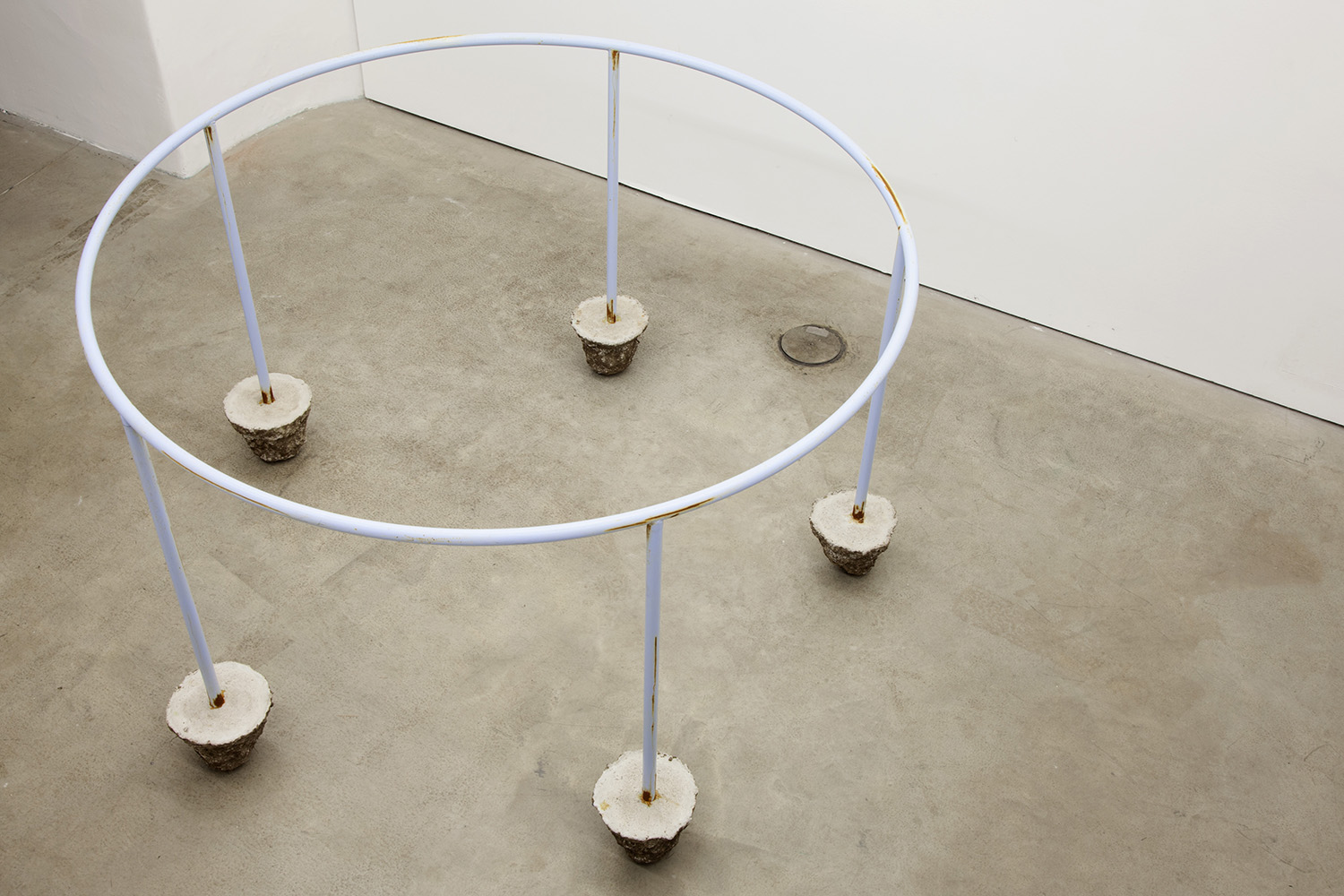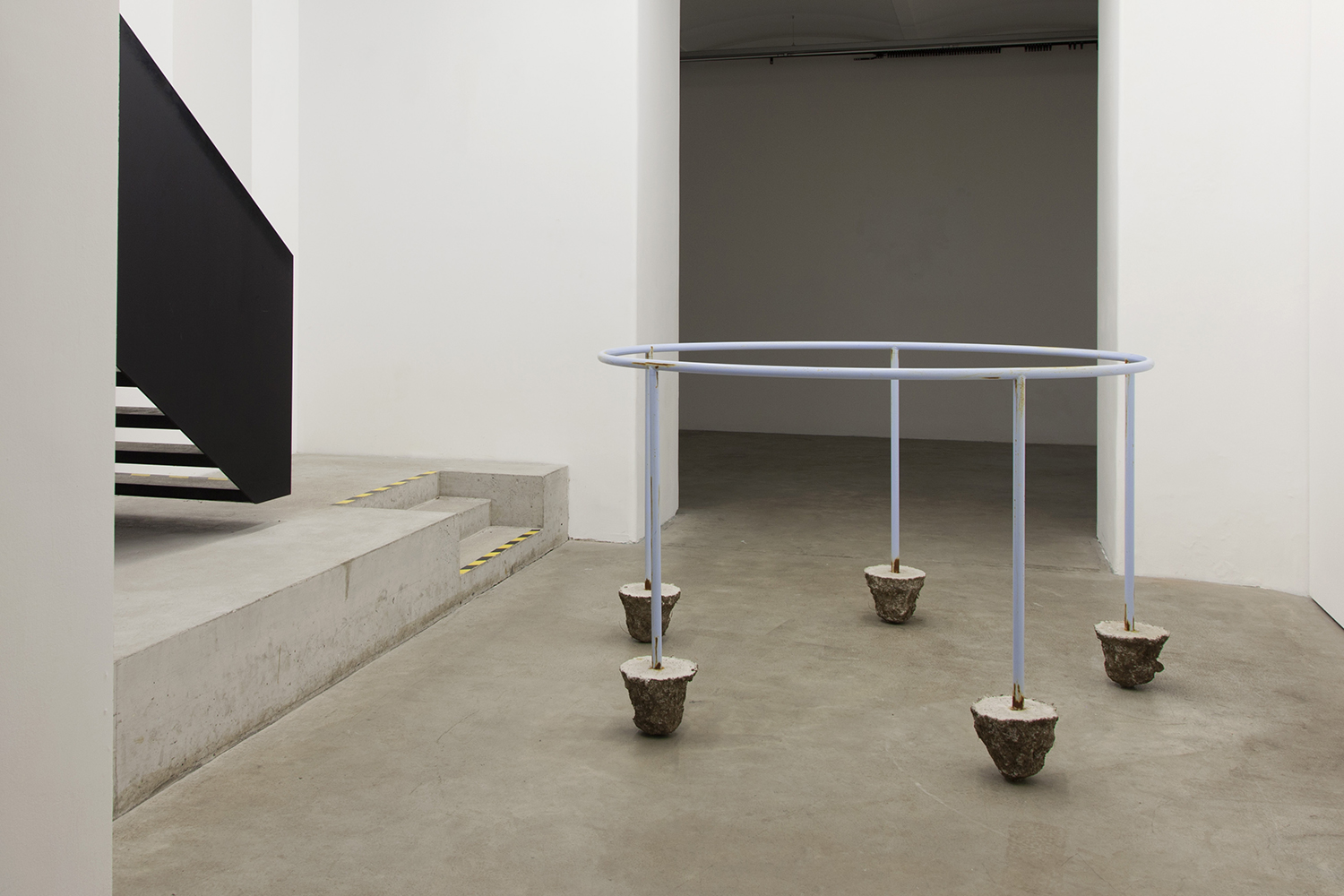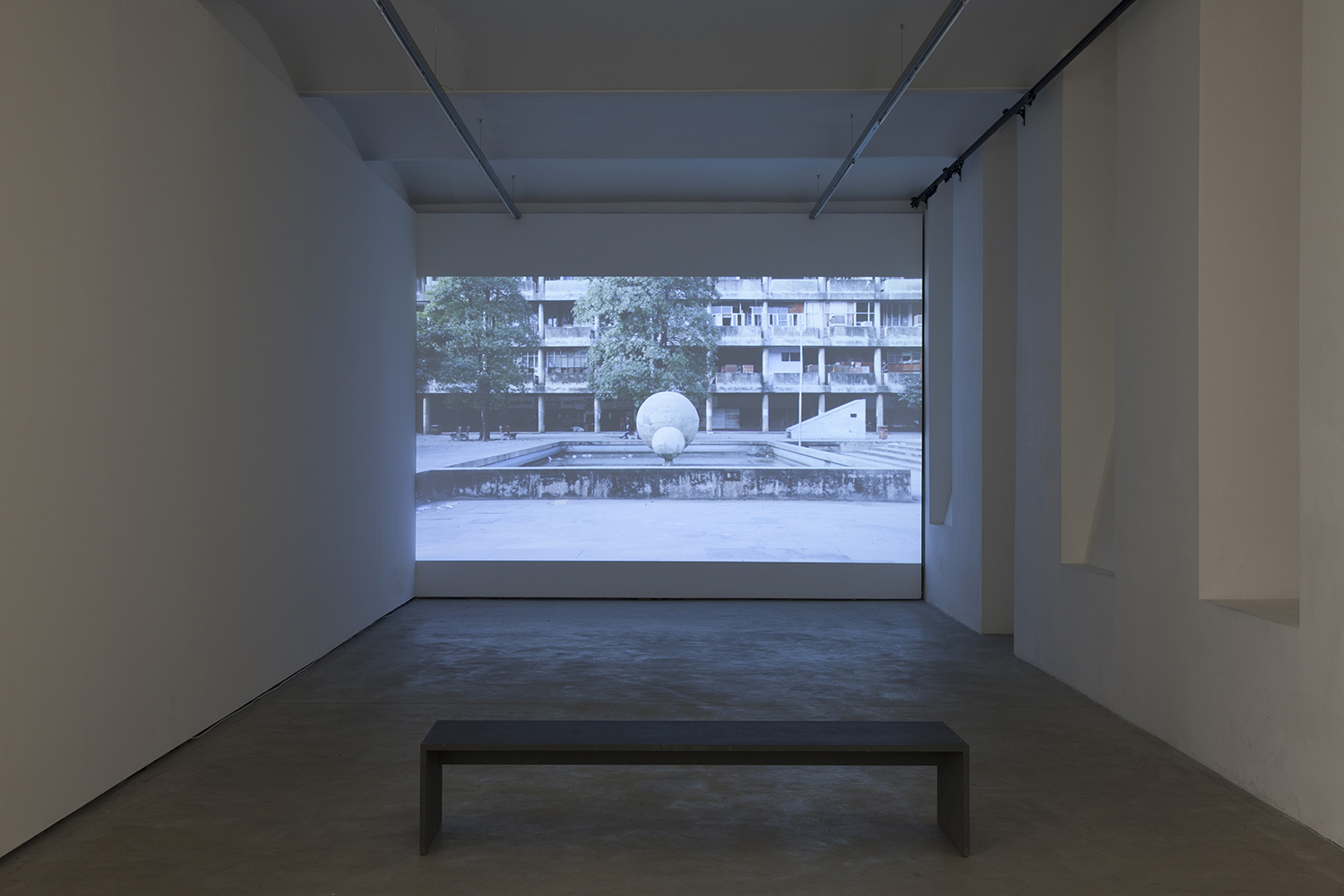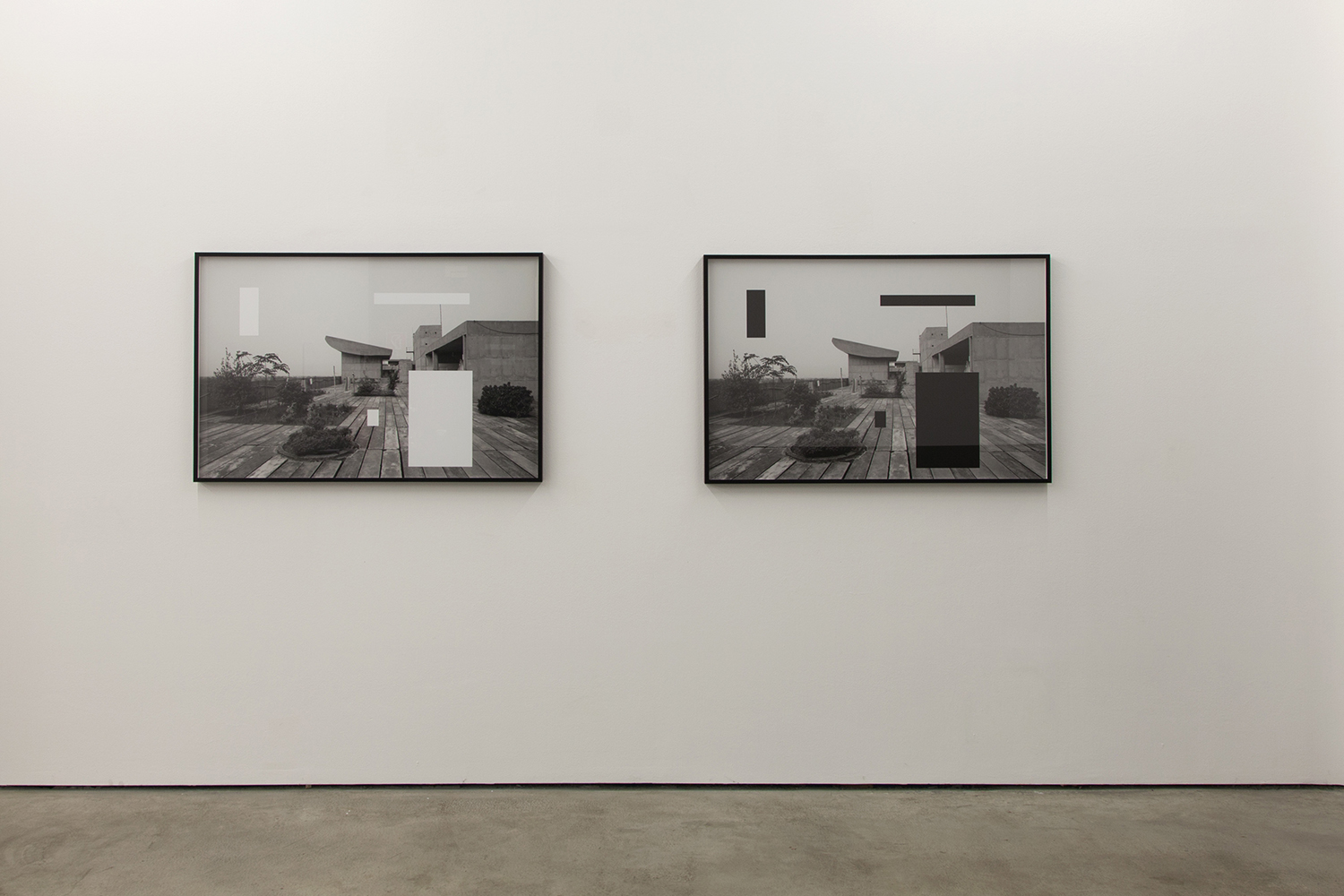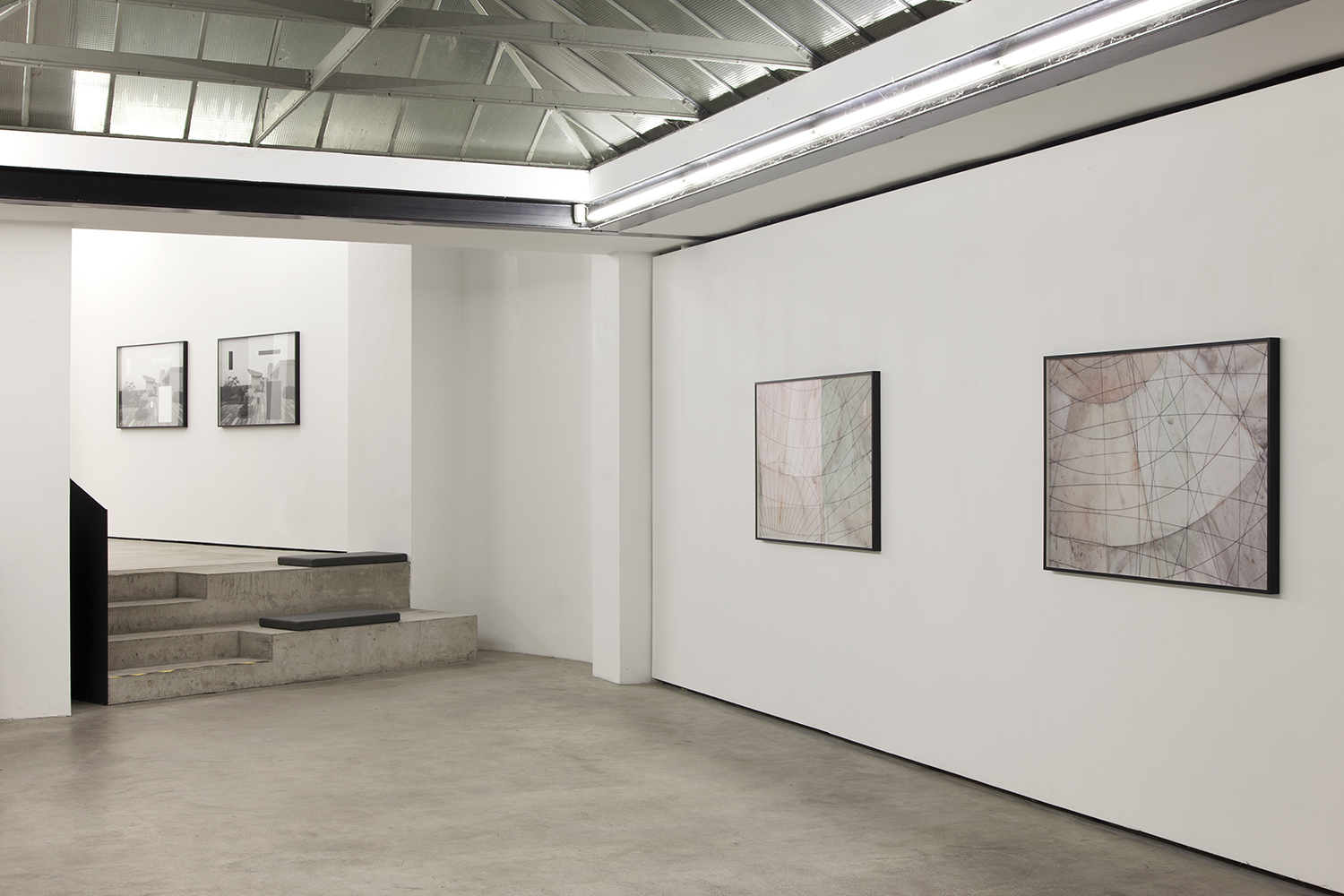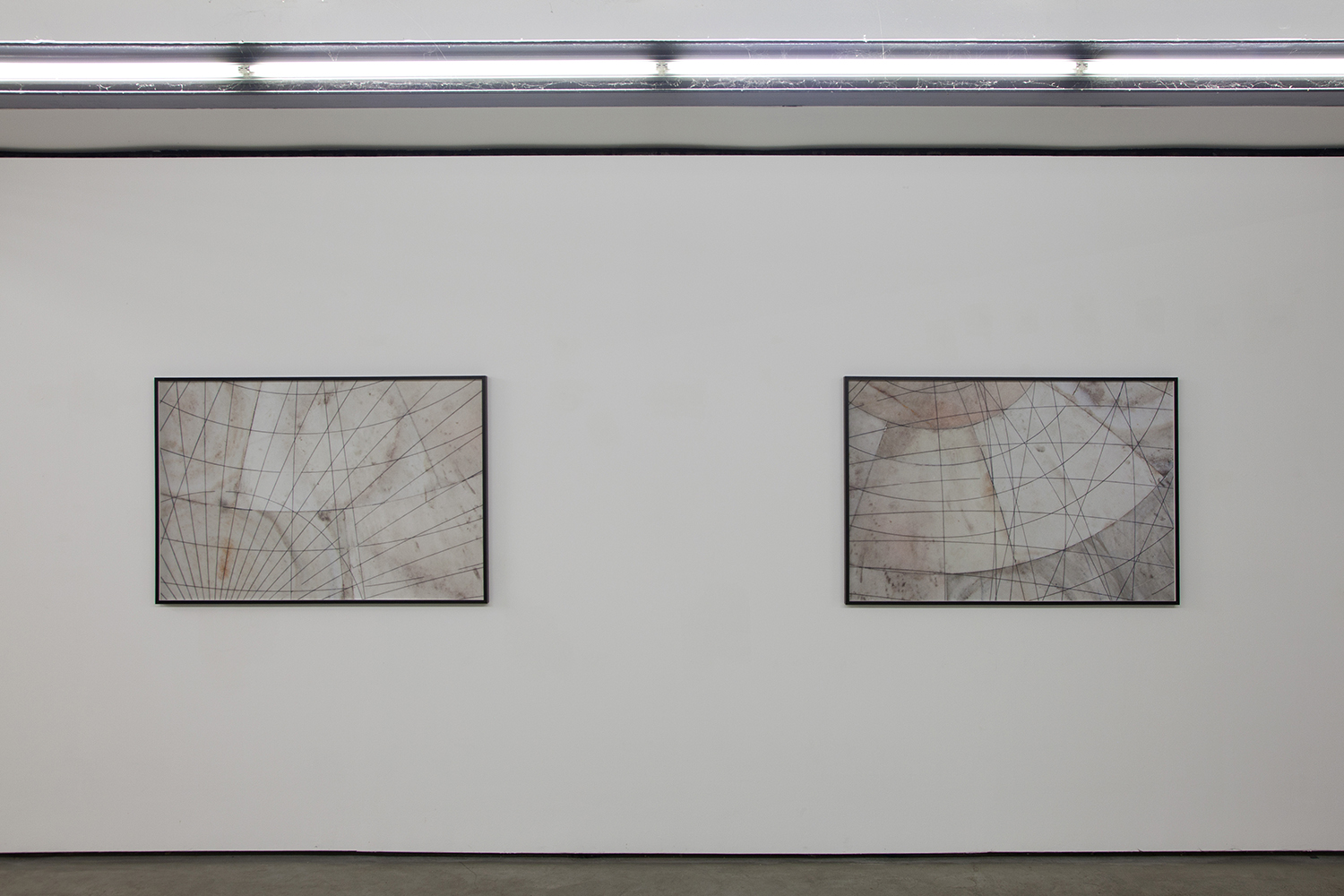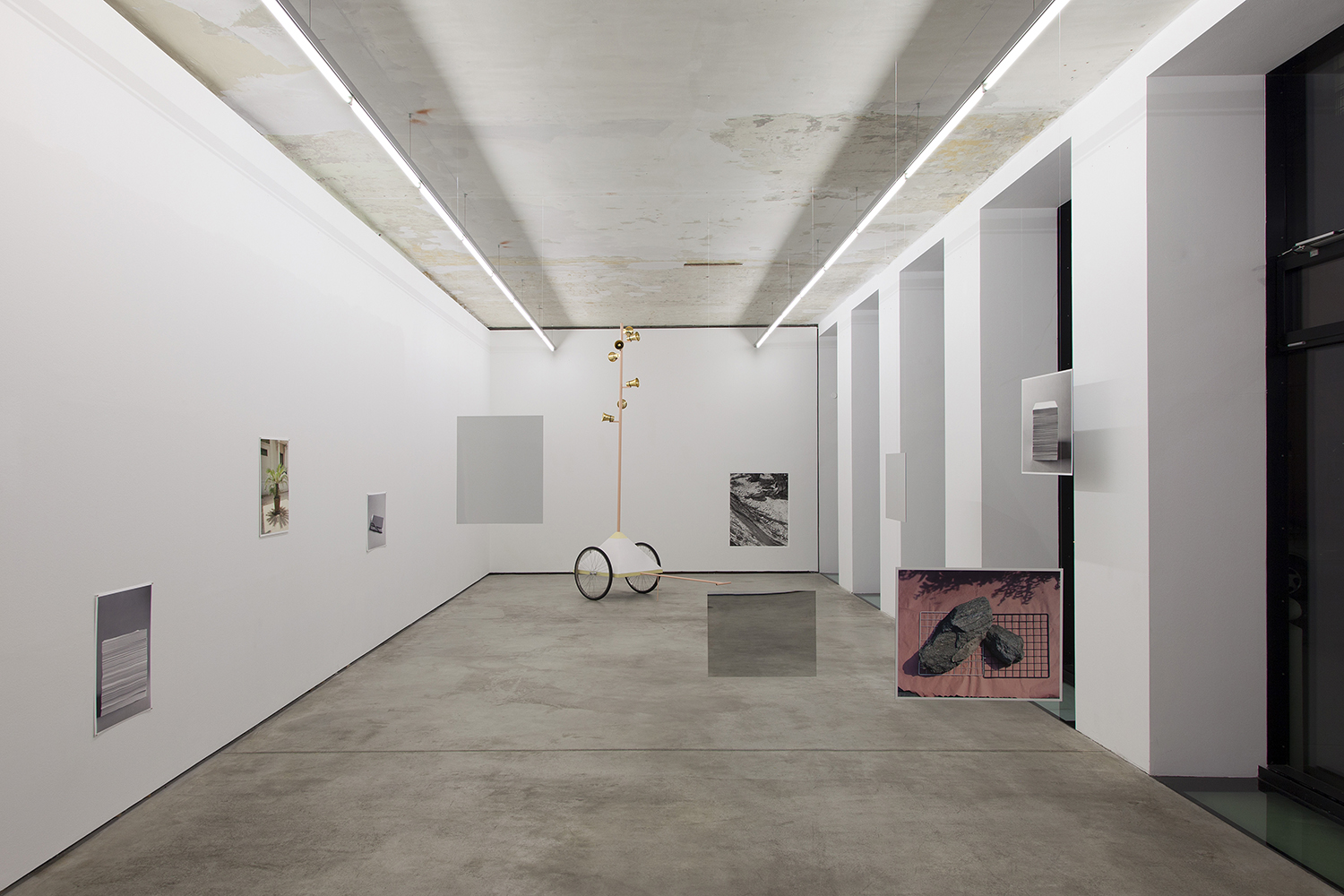Babyface
Michael Fanta
Konzulát Studios, 10117 Berlin
February 28 – March 1, 2020
Michael Fanta (b. 1989, Graz) lives and works in Vienna. He studied at the Academy of fine Arts, Vienna, with Daniel Richter and at the Academy of the Arts Iceland, Reykjavík. Fanta has been included in numerous exhibitions in Austria and across Europe. Recent group shows include Dangerous Stuff, Julius Getty Gallery, London and Fensterblick a duo with Gábor Király at the Austrian Culture Forum in Budapest. One-person exhibitions include Night Out, Institut für moderne Kunst, Nurnberg and Neue Bilder, Museum MUSA, Vienna.
Funny Games
Potencja (Karolina Jabłońska, Tomek Kręcicki & Cyryl Polaczek)
Gussglashalle, 10997 Berlin
May 18 – May 19, 2019
The exhibition Funny Games features recent works by Karolina Jabłońska, Tomek Kręcicki and Cyryl Polaczek – three young Polish painters who exhibit collectively as Potencja and run an independent art space bearing the very same name in Kraków. Despite their history of close collaboration, Potencja’s first joint presentation in Berlin is built around themes such as rivalry, competition and miscommunication. Originally, the show was meant as a tongue-in-cheek commentary on the collective’s internal dynamics and, in a broader perspective, an account of how tight-knit bonds of comradeship and solidarity dissolve within late capitalist culture. Although many works presented at Gussglashalle allude to these matters, the final selection might also be read as a broad enquiry into painting conceived as a conceptual practice. Displaying affinity to cinema and reiterating characteristic motifs over and over again, Potencja’s works challenge the communicative potential of figural painting.
Jabłońska, Kręcicki and Polaczek began their collaborative work in 2012, while working towards their diplomas at the Fine Arts Academy in Kraków. At the outset, they were presenting their works at unusual places such as the post-communist milk bar Wiarus in the city centre. In 2016 they opened their first project space in Zabłocie, a post-industrial district of Kraków, and in the following years they achieved critical acclaim and widespread interest in the Polish art scene thanks to their collaborative shows across the country (including Potencja at Raster Gallery in Warsaw, 2017). Dubbed “the future of Polish painting”, Potencja have quickly become a brand in the national art scene – but the brand’s strength stems from the group members’ distinct personalities. Although Funny Games participants act as a collective, they mobilize distinct sensibilities and draw inspiration from different sources. Jabłońska often borrows from vernacular culture and overcodes her paintings with feminist overtones; many of Kręcicki’s works are reductive and theatrical in the post-minimalist manner, while Polaczek’s – most symbolic and heavily mediated with cultural references (as well as relying on the tactile qualities of the canvas and paint themselves).
What unites Jabłońska, Kręcicki and Polaczek’s practices in spite of their idiosyncracies is their slightly surrealist approach to figuration. Whether it is a cigarette stub, a mouth, a light-bulb or a human leg, in their paintings such objects often become enlarged, distorted or ripped out of the usual context; in short – defamiliarized. It is because of this trait that Potencja’s works have been compared to the oneiric videos of Berlin’s Preis der Nationalgalerie winner Agnieszka Polska or ethereal paintings of Tomasz Kowalski. Many of their pieces might be anectodal just like works of Marcin Maciejowski or Wilhelm Sasnal – former members of Kraków-based Grupa Ładnie and two of the most influential contemporary Polish painters – but Potencja’s anectodes differ substantially in terms of content and style of delivery. Whereas Maciejowski dabbles in Polish history and fashions his paintings on comic strips, Jabłońska, Kręcicki and Polaczek pay more attention to direct human interactions and employ the visual vocabulary of cinema. They capture movement in freeze-frames, depict their protagonists in extreme close-ups and capture some scenes from multiple angles. Relying on repetition and shifts of perspective, their painting series reflect the logic of film montage and thereby correspond to their actual attempts at film-making (including Złe rekiny and Interstelaż – the collective’s parodist takes at sci-fi and horror movies).
The title of Potencja’s exhibition in Gussglashalle alludes to the controversial 1997 movie directed by Michael Hanneke. An epitome of mindfuck cinema, Funny Games confronts the viewers with absurd, sadistic violence and incessantly challenges their expectations that concern the protagonists’ behavior. Similarly to Haneke’s film, Jabłońska, Kręcicki and Polaczek’s paintings depict scenes of brutality and gore – yet the affinities do not end here. The Austrian director’s movie is set in a desolate place, if read allegorically, it might be said to envision the social world as a closed system whose inhabitants can seek no external legitimization for their actions and might well feel entrapped in their solipsistic perception of reality. Re-painting disturbing scenes and seemingly banal objects over and over again, the Polish painters evoke a similar sense of entrapment. Instead of introducing more meaning to the depicted world, the slight shifts of angles and moments of estrangement in Potencja’s consecutive takes on the same motifs only amplify the impression of anomy and lack of direction. In their painterly worlds, there are no significant plot twists and moments of recognition – in lieu, there is ever more doubt and neurosis.
If anything counterbalances the neurotic quality of Potencja’s painting, it is – just like in Haneke’s case – slightly humorous moments of reflexivity. In one of the most memorable scenes in Haneke’s Funny Games, a sadistic protagonist grabs a TV remote and presses the rewind button, which results in the actual reversal of the movie’s action. Jabłońska, Kręcicki and Polaczek often use similar devices (for instance, showing an object well-known from their previous works in front of a camera lense) – such tricks do not, however, serve to provide ‘strong’ interpretive keys to their oeuvres. The artists suggest no guidelines, no moral codes and no easy justifications. In the age of social media whose algorithms project our mirror images on smartphone screens, the trio choose to confront the viewers with the sheer oddness of ‘looped’ perception.
Arkadiusz Półtorak (Poland, 1992) – curator and writer; PhD candidate in the Faculty of Polish at the Jagiellonian University and graduate of De Appel Curatorial Programme (2017/2018); co-founder of Kraków-based art initiative Elementarz dla Mieszkańców Miast and contributing editor at “Magazyn Szum”.
Champaintings
Michael Klipphahn & Winnie Seifert
Franz-Josefs-Kai 3, Suite 16, 1010 Vienna
February 21 – March 14, 2019
Winnie Seifert and Michael Klipphahn, both born in 1987, both studied with Prof. Ralf Kerbach and together they run the Dresden art space "Galerie Stephanie Kelly". This is where the superficial similarities end.
In her practice Seifert paints with a lot of physicality and intuition, with broad, partly dense, outgoing, clearly defined brushstrokes. Through the seemingly never-ending cycle a feeling for the rudimentary can be guessed. At the same time, the reference to the great gestures and painterly (mostly male) models is counteracted with pointed irony in the titles. Strokes and coloured surfaces on the picture plane expand and produce an apparently decorative surface that tilts into the irritating through the coarse, impure and unmediated nature of the painterly elements. In the end, Seifert flirts with a composed tableau of staggered color surfaces.
Michael Klipphahn's representational painting, on the other hand, is entirely a product of its time. The foregoing research process comprises social media, such as Facebook or Twitter, which in the stream of timelines produce infinite material on social processes, advertising amd fashion worlds in the form of professional or non-professional documentary photography. Special attention is paid to the language of the new media and the simultaneous illustration of a chronic melancholic loneliness of its protagonists. In his pictures we first see the supposedly flawless moment and then the irritation breaks through the seemingly flawless. Similar to a video camera, in Klipphahn's painting the zoom reveals something that would have remained hidden without this function. It is not a painting of motifs, but rather one of overcoming distance.
Despite the open differences in approach, in the way paintings are processed as well as the formal differences, both Klipphahn and Seifert work against the zeitgeist: Seifert eludes the zeitgeist, there are no references to currently popular currents in painting, she (her painting) does not inflate herself, is not arrested in time. Due to its intellectual proximity to the original nature of painting, provoked by a product of artistic handwriting, as well as its physicality, which is only abstractly present in new media, there is no temporal allocation in the subjects.
Klipphahn first makes use of the zeitgeist, the timelines from which he draws, and yet: he snatches his subjects from these eternally bubbling sources in order to attribute more to them than their rapid demise. And if these subjects have much to do with youthfulness and unconsumedness, then they cannot be clearly assigned in time. They carry youth within them and yet it is not clear when it will happen. They are chosen for something more, they obtain a longer life through Klipphahn, which perhaps will not be infinite and yet just carries this promise in itself.
The title of the exhibition, "Champaintings", quickly brings to mind "Champagne for my real friends, real pain for my sham friends", a quotation attributed to Francis Bacon. In this sense, it is the true friends who critically deal with the signs of the times, not the "sham friends", who keep their little flag in the wind. It's also interesting to note that Klipphahn and Seifert's art space is one of the few contemporary spaces in a city that rather indulges in nostalgia and otherwise practically renounces the contemporary.
In "Champaintings" at Zeller van Almsick Seifert and Klipphahn are exhibiting for the first time as a duo.
If She Wanted I Would
Have Been There
Once Twice or Again
Sofia Ekström, Josefina Malmegård, Jin Mustafa, Theresa Traore Dahlberg
Curated by C-Print
Franz-Josefs-Kai 3, Suite 16, 1010 Vienna
October 13 – October 31, 2018
In Too Much Happiness, Alice Munro writes about how in life there are generally just a few places, or maybe only the one place where something happened, after which point there are all the other places. Thinking of a rapport with Vienna that was once both forged and lost here, and then allowed to persist in a direction more uncertain, for me Munro’s words inform this city. This is, or used to be that place. There was a search of belonging here, calling to mind the discoveries of Sylvia Plath’s Daddy; The snows of the Tyrol and the clear beer of Vienna are not very pure or true. No place here is essentially more emblematic of this personal rapport struck than a publiccommissioned work by artist Lawrence Weiner on the defense tower from WWII, situated in the Esterházy Park. It poetically offers the words Smashed To Pieces In the Still of the Night. That this landmark artwork is now facing the same fate that it instills onto wall with its words adds to the narrative and while the work itself allows multiple readings, Weiner himself has simply referred to how listening to bottles being smashed in a city as prim and proper at face value as Vienna, takes on a very different tone at dark. Weiner’s work like that of Munro’s or Plath’s, serves as one of several inspiring points of departures for this exhibition which inviting four Swedish artists to Vienna could ultimately have taken place anywhere, not necessarily just here, but the idea behind which resonated particularly well here.
The works by the four in If She Wanted I Would Have Been There Once Twice or Again consequently are marked by the common denominator of surveying a very private sphere or rapport with a geographical space or the physical and emotional distances between several such spaces.
Growing up with two photographer parents and with formative years arguably lived in front of the camera, figuratively and literally, for Sofia Ekström the notion of the family portrait studio finds itself as a recurring fixture throughout her body of work. Her archival installation of objects, photographs, authored texts and video is a mirror to the past and examines the subtleties of a divided relationship with her late father. In Portrait of a Father (fadersporträttet) she films a portrait session of her father sitting for her in front of the camera, letting the viewer in on the dynamics between two artists at a moment of mutual forte.
Theresa Traore Dahlberg’s work on view derives from an ongoing photographic series shot in Ouagadougou where she partially grew up herself. The frame establishes a social scenography set at daybreak where the time element is telling of a stage-in-between, marked by anticipation of a scene that is soon to be played out or perhaps captures the aftermath of one that already has occurred. It suggests and hints at interaction of a certain nature, of which there is visible trace, but no clear presence.
Jin Mustafa’s video Untitled Streams revolves around virtual and liminal spaces. The non-linear stream of imagery supports a narration hovering between the role of mediated communication to fill the voids of distance and the construct of memory. At a pivotal moment, the narrator recalls the ease with which a location from the distant past can vividly be visualized from the mind, noting subsequently the failure to do the same with a distinct road driven daily in the present of today.
Josefina Malmegård’s Home stresses how one’s quotidian abode can make for a subversive space if distorting the habitual. For the project she placed ads around the city, inviting male strangers to her home to perform domestic chores while being filmed. The work probes questions about the gendered gaze, perversion and privacy. All these various questions of when and why paradoxically evokes a near Hitchcockian suspense and tension amid an uneventful and slow course of action, prompting the viewer to wait for that one climactic moment to arrive.
Ashik Zaman (C-print), 2018
PRIVATE VIEW #6
Charlotte Klobassa
Franz-Josefs-Kai 3, Suite 16, 1010 Vienna
May 13 – May 20, 2017
The series is being continued with Charlotte Klobassa, a 1987 born Viennese, whose paintings deal with the depiction of found imagery, while examining the notion of impulsiveness and free gesture opposed to a more controlled conveyance.
In her series ‘Scribble’ Klobassa draws inspiration from collected pieces of paper found in stationary shops. Discovered while on the lookout for a technique or strategy to evade and subsequently free oneself from a limiting workflow, these findings lend themselves perfectly for free interpretation and association. The papers with test scribbles from unknown authorship manifest a very imminent, impulsive and unconscious composition, and Klobassa complement them with her own sketches or appropriate someone else’s handwriting. By later translating onto large-scale painting she pays tribute to the importance of the medium by emphasizing her obsessive precision in execution of details, celebrating the dichotomy between impulsiveness and habitual.
The medium and small formats exhibited are influenced from social media excerpts, that Charlotte Klobassa implements or enhances with everyday life objects. She thereby creates moods that have an inherent illustrative character, arising as mental collages that permeate her emphasis on spontaneity as well as a remaining evidence of the process itself. As Klobassa states, the accelerated, passive floods of digital networks create a simultaneous mixture of fascination and sense of loss that spontaneously inspire her, evoking a sense of belongingness and desire to consume. The separation by the surface screen, space and time, however, prevents real proximity, depth and exchange. By transferring the imagery onto the pictorial medium, she takes out the sleekness of those virtual moments of desire, while showing images that take their surroundings into account and thus create room for further levels of content and communication.
PRIVATE VIEW #5
Evelyn Plaschg
Franz-Josefs-Kai 3, Suite 16, 1010 Vienna
April 22 – May 6, 2017
In its fifth edition, we are resuming the series with Evelyn Plaschg, a 1988 born Styrian, whose graphical works allude to an undisclosed, subliminal subject while conveying a sense of daintiness and ephemerality.
The starting point for this new series of Evelyn Plaschg’s work is Lucas Cranach’s painting ‘Three Graces’ (1530). Following Greek mythology, the daughters of Zeus and Eurynome, called Euphrosyne (the jocund), Thalia (the prosperous) and Aglaia (the radiant), brought grace and beauty to the people and the gods and the trio was oftentimes depicted as handmaidens of the goddess Venus. The Graces come to be especially popular in the Renaissance, since their representation opens up an opportunity to elaborate on their natural potential for sensuality.
In ‘The Species of Approachers’ Plaschg picks up on the childish frivolity and the alleged alliance between the three figures and some of the graphic elements from Cranach’s ‘Three Graces’ can be found on the larger canvases exhibited. Her modern day graces are full-length personal portraits (also in reference to Cranach) in a spatial setting. The posture of the figures, and their distinct elegance, originates in the subjects’ relation to the space they find themselves in.
The color palette suggests sensuality, alludes to a blush or redness that could be attributed to embarrassment or discomfort, as much as to a more epicurean context.
In her new large-scale formats, Plaschg treats the canvas like a sheet of paper: with no possibility of erasing or overworking, but rather leaving all the traces in the open, she embraces the performative element of drawing in high concentration.
THE HIGH WIRE ACT
Minda Andrén, Olivia Coeln, Barbara Hainz, Wolfgang Lehrner,
Mladen Miljanović, Julian Palacz, Andrea van der Straeten, Kay Walkowiak
Curated by Cornelis van Almsick
and Magdalena Zeller
Berggasse 35, 3.OG, 1090 Vienna
November – December 2016
The tightrope act is a dying genre of acrobatics. Circus memories are nowadays more childhood memories than a contemporary form of entertainment. Yet the tightrope act as a synonym of a daring project is more relevant than ever.
Whether it is the current political situation in regard to the relationship of the EU with Turkey and the refugee crises involved or, quite banal, the happy outgoing of skydiver Luke Aikins jumping without a parachute from a height of 7600m end of July this year: It’s the tightrope act circumscribing it aptly.
Meanwhile there is a strong contrast between the projected need for security of our Western society and the reality of existing problems that sometimes require enormous audacity and determination.
The works of the artists deal with this kind of balance. A surprising act of balance, death-defying performance or simply a composition of strings. There’s a fine line on which the artists move: the abyss on both sides, a death-defying act of balance and in mind the aspiration of physical safety and the recognition of the audience.
YOUNG AMERICANS
Petra Cortright, Luis Giepert, Alex Ito, Carter Mull,
Ken Okiishi, Timur Si-Qin, Ryan Trecartin, Kaari Upson
Curated by Cornelis van Almsick,
organised by Irene Gludowacz
FRANZ JOSEFS KAI 3
1010 Vienna, Franz-Josefs-Kai 3
November – December 2015
Don’t be deceived by the Young Americans. Their youthful exuberance is seductive, but they have deeper and darker secrets to tell than first meets the eye. Underneath the pop aesthetics, the flashy branding, and the decidedly artificial surfaces, are Generation X and Y digital natives and artists, coming to terms with the alienating ubiquity of daily life expressed in new media.
One of the curious paradigms of the digital experience is that the increasing importance of image culture used on computer screens has been balanced with the growing potential of new materials available to produce physical objects IRL (in real life). Contemporary artists are increasingly transferring techniques used in computer programs directly to material objects and vice versa. When taken offline, the assumed limitations of the screen become endlessly generative as the need for material expression of ideas continues to flourish. Like a teenager coming of age, this approach is maturing, as are the nuances that define it.
However, the journey is far from over and has been more destructive than productive. The apparent equivalence of digital content and physical form has destabilized definitions of wholeness. Information and history have become mutable, just as much as fixed identities and the purity of ‘truth’ cannot be trusted. The boundaries between what is real, imagined, projected and seen are falling away, blending into lived experience as a mash-up of metaphysical philosophy. With the constant need to delete and refresh, memory and meaning are effectively wiped clean, leaving behind a feeling of emptiness – a neo-nihilism that underpins the digital experience.
From photographs about alienation and commodity by Ken Okiishi, to the post-apocalyptic landscape of Alex Ito’s installation, and the self-conscious videos by Petra Cortright, the selection of artwork in the Young Americans forefronts each artist’s unique digital output as well as their specific socio-political, ecological, and metaphysical concerns.
The American dream has long been tarnished as the façade of capitalism, power, and moral righteousness blinds the realities of rising poverty rates, institutionalized violence, and impending environmental collapse. There is an understanding of social degradation built-in to the American experience that bubbles beneath the surface, and feeds its way into the narratives that the Young Americans address.
Text by Arielle Bier, ©2015
TIME TO FILL UP THE GLASS
Adrian Buschmann, Michael Fanta, Hanna Putz, Rosa Rendl
Alexander Ruthner, Lilli Thießen, Anne Cathrin Ulikowski, Marcin Zarzeka
Curated by Cornelis van Almsick
Galerie CRONE, Berlin
10969 Berlin, Rudi-Dutschke-Straße 26
May – June 2015
Weiblicher Partygast: „Also, angeblich, verursacht die rapide Abholzung des Regenwaldes eine weltweite Verbreitung neuer Viren, die große Teile der Bevölkerung dahinraffen wird. Ich zitiere diesbezüglich lediglich den New Yorker, wenn Sie verstehen..“ Will Randall: „Jedes gehobene Magazin argumentiert, dass der Verlust der Regenwälder den Weltuntergang bedeutet. Nun, gleichermaßen kann man argumentieren, dass die Welt bereits untergegangen ist. Dass die Kunst tot ist und wir erschöpft sind. Dass die Kunst von der Pop Kultur ersetzt worden ist, wir Tagesfernsehen haben, schwule Senioren, Frauen, die von ihren Zahnärzten vergewaltigt worden sind und dies vertraulich in Talkshows preisgeben. Es gibt eingehende Studien, warum Frauen ihren Ehemännern die Schwänze abschneiden.“ Männlicher Partygast: „Time to Fill up the Glass.“
Die in der Ausstellung vertretenen Künstler teilen eine gemeinsame Vergangenheit: Kennengelernt haben sie sich in der notorischen Klasse von Daniel Richter an der Akademie der bildenden Künste in Wien, zahlreichen Cocktailpartys und Verursacher kleiner, wie großer Skandale in der Wiener Kunstwelt. Teils gemeinsam, haben sie mittlerweile Ausstellungen im Ausland bestritten - u.a. in Hong Kong, Los Angeles, London, Warschau oder Moskau. Dennoch blieb der Fixpunkt Wien, wo Fanta, Putz, Rendl, Thießen und Zarzeka, nach wie vor ein Studio halten.
In den Räumen im Erdgeschoss finden sich Fotoarbeiten von Rosa Rendl, installative Malerei von Lilli Thießen, skulpturale Wandarbeiten von Marcin Zarzeka und eine raumübergreifende Arbeit von Hanna Putz.
Abgesehen von der skulpturalen Arbeit ‘Sundown Vienna’ von Marcin Zarzeka und der Zusammenarbeit ‘Pullmann’ von Adrian Buschmann und Hanna Putz, ist in den oberen Räumen ausschließlich Malerei zu sehen. Die Arbeiten bewegen sich in einem Spannungsfeld zwischen Abstraktion und Figürlichem. Dennoch haben es die Maler Buschmann, Fanta, Ruthner und Ulikowski, die alle bei Daniel Richter auf der Akademie studiert haben, geschafft, sich ihren eigenen Stil zu erkämpfen und sich damit erfolgreich von Richter zu emanzipieren. Buschmanns Titel, die seinen Bildraum erweitern, Fantas malerische Materialitäten, Ruthners mit plastischen Elementen durchsetzte Landschaftsabstraktionen und Ulikowskis bildlicher, wie schwarzer Humor, bergen eine unglaubliche Originalität.
Marcin Zarzeka hingegen bricht mit der Malerei, obwohl er stark mit ihr verwurzelt ist; studiert hat er an der Bildenden in Wien, bei Amelie von Wulffen und Birgit Megerle. Bereits als Student experimentierte er mit Aquarellen, die er mit eigens gemachten Rahmen versah und die sich über die Zeit selbst zur Skulptur entwickeln sollten und die Aquarelle gänzlich ablösten. Ein starker Bezug zum polnischen Konstruktivismus ist unverkennbar.
Die Kooperation von Buschmann und Putz zeigt auf Postern eine ungewöhnliche Symbiose zwischen Malerei und Fotografie. Die Prints zeigen Hotelzimmer mit generischer Ausstattung, deren Charakterzüge sich in der Malerei von Buschmann widerspiegeln. Dem Maler und der Fotografin Putz gelingt hier eine außergewöhnlich eigenständige Parallele zu Kippenbergers Hotelzeichnungen, die das Leben des ‘fahrenden’ Künstlers thematisieren.
Alex Ruthners Arbeiten oszillieren zwischen Abstraktion und Figürlichem. Auf einem mehr oder weniger monochromen, grauen Hintergrund finden sich expressive Farbflächen. Elstern, Lerchen und Stare sind zu sehen, die auf vermeintlich anachronistischen Fernsehantennen, sicher jedoch auf geometrischen, schwarzen Linien sitzen. Eine mutmaßlich graue Stadt, deren Melancholie und Verbitterung kontrastiert wird vom Optimismus der zierlichen Vögel.
Text von Cornelis van Almsick, ©2015
A FAREWELL TO ARMS
Alejandro Vidal
Ryszard Waśko
Curated by Cornelis van Almsick
and Katarzyna Uszynska
Neuer Kunstverein Wien
1010 Vienna, Herrengasse 6 – 8
February 2015
Das Gedicht mit dem Titel ‘A Farewell to Arms’ des Engländers George Peele handelt von der Loyalität eines alternden Ritters gegenüber seiner Königin. In seinem 1929 erschienenen gleichnamigen Erfolgsroman erzählt Ernst Hemingway hingegen von Henry Barkley, der sich aus Liebe zur Krankenschwester Catherine vom Krieg abwendet. Hemingway konterkariert die Grauen des Krieges des ersten Weltkriegs mit einer ergreifenden Liebesgeschichte, eine Absage an Krieg und Gewalt.
Der Titel ist Ausgangspunkt der Gegenüberstellung von Alejandro Vidal und Ryszard Waśko, die sich beide nicht nur mit nationaler Identität und deren Konfliktpotential beschäftigen, sondern die ebenso soziale und religiöse Abgrenzung und deren Ausdruck in der Alltagskultur thematisieren.
Die Bezeichnung „Der Dschungel“ wird einerseits in unserer Wahrnehmung mit einem menschenleeren Paradies, der reinen Natur in Verbindung gebracht, andererseits versteht man unter dem Gesetz des Dschungels einen Ort, wo das Recht des Stärkeren herrscht. So zeigt uns Vidal in seiner Serie ‘Paradise of Exception’ eine Dschungellandschaft voll wilder, undurchdringlicher Vegetation mit Palmen und Strand, eine Atmosphäre von Natürlichkeit und Frieden.
Doch nicht nur das Schwarz-Weiß des Drucks der Arbeiten irritiert und lässt innehalten. Die Drucke basieren auf Reproduktionen von Abbildungen, die Vidal Feldhandbüchern der amerikanischen Armee entnommen hat. Büchern, die den Soldaten als Leitsystem für den Kampf um das Überleben im Dschungel dienten. Der Dschungel und seine Dichotomie zwischen Romantik und Gefahr, zwischen Farbe und schwarz-weiß finden ihren Ausdruck in der imaginären Welt der Bildvorlagen aus Militärhandbüchern.
Auch Vidals Videoinstallation ‘Firestorm’ spielt mit Zweideutigkeiten. Zu sehen ist eine scheinbar endlose Aneinanderreihung von farbenprächtigen Feuerwerken, deren Klang sich parallel zu dessen Abbild entfaltet. Je länger man jedoch zuhört, desto mehr ergeben sich Abweichungen: Zu hören sind: Kriegsgeräusche und Explosionen aus einem unbekannten Kampf.
Dem in der während des Golfkrieges verlassenen irakischen Botschaft in Ost-Berlin gefundenem Briefpapier entnahm Vidal den Satz in englisch: „Trough your search for your Enemies you will not find them“, den er nunmehr in einer in situ Arbeit auf die Wände des Ausstellungsraumes auftrug.
Ryszard Waśko arbeitete bereits in den 70 er Jahren mit visuellen Medien wie Film, Fotografie und Video. In seinen konzeptuellen, medienreflexiven Arbeiten ließ er nicht nur die Grenzen zwischen den künstlerischen Gattungen hinter sich, sondern brachte auch immer wieder naturwissenschaftliche, mathematische Methoden in seine Arbeit ein. So orientierte sich der Schnitt seiner Filme und die Gestaltung seiner Fotografien an mathematisch-geometrischen Prinzipien.
In der im Jahr 1977 entstandenen Arbeit “Hypothetical Photography” fügte er eine schwarz- weiße Straßenabbildung in ein Koordinatensytem ein und übersetzte sie in seinen Zeichnungen in ein graphisches Schema, eine Bearbeitung der Fotografie, die ihn letztlich zu einer einzigen geraden Linie führt. 1987 greift Waśko für seine Arbeit “Hypothetical Checkpoint Charlie” auf diese Idee zurück. In einem mathematisch geometrischen Analytischen und destruktivem Prozess löst er die fotografische Abbildung des „Checkpoint Charlie“ in seinen Zeichnungen auf, bis das Objekt wiederum in geraden Linien verschwindet. Die Arbeit “Hypothetical Checkpoint Charlie” kündet bereits 1987 von der Auflösung eines obsoleten Monuments des Kalten Krieges, in dem Gewalt, Aggression und Unterdrückung für alle Zeiten in Beton gegossen schienen. Am 10. November 1989 fotografierte Waśko noch einmal den nunmehr offenen Checkpoint Charlie und vereinte die Photographien und Zeichnungen zu der in der Ausstellung gezeigten Installation.
In seiner Arbeit „No-man’s Land Flags“ aus dem Jahr 1997 präsentiert er aus verschiedenen Farben und Formen gebildeten imaginären Fahnen und thematisiert damit die künstliche und oft gewillkürte Konstruktion nationaler Identitäten.
Die Räumlichkeiten des Ausstellungsraumes, einer alten Wohnung, in dessen Wände Geschichte geschrieben zu sein scheint, verleihen der Ausstellung eine Atmosphäre eines verlassenen Ortes, eines Ortes wie wir ihn von Bildern aus Zonen des Krieges und der Gewalt kennen.
Text von Cornelis van Almsick, ©2015
LIVING THE INTERNATIONAL STYLE
Wolfgang Lehrner
SOLO
Curated by Cornelis van Almsick
Haus Wittgenstein
1030 Vienna, Parkgasse 18
January 2015
Living the International Style by Wolfgang Lehrner (born 1980, lives and works in Vienna) is an approach to the ambivalence encountered in modernity.
“International Style” refers to a drive in classic modernist architecture, which originated in Europe in 1922 and would later be found throughout the world. The term was initially used as a title for a 1932-exhibition at MoMA and for the successive publication The International Style: Architecture since 1922, and it describes an internationalized form of architecture de-contextualized from the locale.
Such a clarity-oriented realignment for man simultaneously implies gain and loss. The dichotomy of modernity’s achievements lies at the heart of this discrete exploration. The works of this series can be ascribed to the 3 aspects Living / International / Style and aim at grasping the moment of transition. A continuous tightrope ride along the small boundary between freedom and uprooting, mass and individual, openness and translucency.
In the sense of this border-crossing, the Haus Wittgenstein (built 1925-1928 by Ludwig Wittgenstein in cooperation with Paul Engelmann) is, to say the least, exemplary. Its aesthetics are simple and sublime, colossal and weightless, translucent and hermetic, pure and elaborate. Wittgenstein’s philosophical and architectural project of isolating the “Speakable from the Ineffable” allows the spectator to depart from zero into experiencing both extremes.
Text by Dajana Dorfmayr, ©2015
A DIFFERENT ORDER
Nandita Raman
Kay Walkowiak
Curated by Cornelis van Almsick
FRANZ JOSEFS KAI 3
1010 Vienna, Franz-Josefs-Kai 3
November 2014
The points of departure for this exhibition are two different constructs of thought and space rooted in India: the Western mondernist planned city of Chandigarh, which was built in the 1950s under Le Corbusier with a Utopian approach, and Maha Kumbh Mela in Allahabad, which is – with 40 million pilgrims – the largest gathering of people worldwide.
In new sculptural, filmic and photographic works, Nandita Raman and Kay Walkowiak discuss different aspects of these real places with Utopian characteristics. They examine the topos of a failed utopia as well as the phenomenon of this insatiable longing for a place beyond all places. Not least, this exhibition discusses the question of translation this non-place which, as a place of potentiality, keeps our wish machine running.
